
Taosi Astronomical Observatory (Solar) 陶寺观象台 (Táosi Guānxiàngtài)
Excavation Site IIFJT1, Shanxi Province 山西省 (Shānxī Shěng), China
Alternative Method for Precise Biǎo (表), Gnomon, Usage for Determining the Location
and Timing of the Sun's Azimuthal Bearing and Elevation Angle
(anticipated full release, early winter 2016)
ABSTRACT
|
The Late Neolithic, Longshan Period (ca. 3000-2000 BCE)(Feng, 2013)[1] Chinese Solar Observatory at Táosi (2600-2000 BCE)(Liu, and Chen, 2012),[2] or (2400-2100 BCE)(Sun, 2008)[3] and UNESCO World Heritage Site (Case Study 5.1), maybe the oldest confirmable astronomical observatory in the world (Xu, and He, 2010).[4] Far more scientifically profound, Táosi Observatory, per various clues provided by the facility's spatial arrangement, could be the earliest known technical demonstration as to the non circular nature of Earth's elliptical orbit about a focicentric Sun.
The following proposing that the Táosi people devised a velocity compensated solar instrument premised about a non height sensitive "horizontal shadow casting", zenith orientated, vertical staff known to the Greeks via the Babylonians as a gnomon or polos (Herodotus ca. 5th c. BCE) when oriented with the north celestial pole (Heath, 1897, 2002).[5] The shadow of the gnomon or biǎo 表[6] (Cullen, 1996),[7] unlike a horizontal attached biǎo typically implemented with the standard north-south aligned, culmination centric, Chinese shadow clock or guī biǎo (Thurston, 1994)[8] (圭表),[9] projected upon one of two horizontally oriented, vertical projection screens, one fast, one slow.
The use of two projection screens, the screens differing in radial distance from the gnomon, resulting in different shadow path lengths, thus different shadow translation velocities. Upon proper placement, the altered shadow path lengths resulting in velocity compensation of the daily movement of the shadow image formed on the projection screen. The normalized shadow velocity being consistent with Earth's unitary areal velocity, or equal area in equal time (Newton, 1685; Moulton, 1902, 1914, 1962)[19] as oppose to the non uniform orbital path velocity. The process of configuring the two projection screens perhaps the product of many seasons of trial and error, the screens eventually compensating for Earth's varying angular rate of change (θdt) about the Sun. The slow screen placement error at Taosi Observatory, off by less than 4.3% percent.
This instrument in practice, having the capacity to determine the location of the setting Sun to an azimuthal angular accuracy of better than 0.5o degrees or 30' arcmins, the approximate width of the Sun and Moon. The naked human eye capable of resolving to 1' arcmin (Smith, 2000).[11] In the hands of skillful operators, the instrument perhaps good to an accuracy of less than 0.1o degrees or 6' arcmins, or 1/5th the diameter of the Sun. The ultimate precision of the proposed alternative measurement methodology and instrument configuration for Táosi Solar Observatory dictated by the repeatable precision and granular accuracy of available time measuring devices for producing an astronomical time reference on the order of seconds (Landes, 1983, 1998).[12]
The ellipticity of Earth's orbit escaping the ancient Greco-Roman world from such greats as Eratosthenes, Hipparchus, and Ptolemy of Egypt, they being followers of eccentric-circular (Evens, and Berggren, 2006)[13] and geocentric orbit theory (Heath, 1897, 2002).[14] Had such astronomical efforts taken place at Táosi Observatory, perhaps leading to the exposure and understanding as to the existence and formulation of the solar analemma path shape in the sky, thus providing Late Neolithic Chinese rudimentary working knowledge of elliptical orbits. The highly possible, comparative orbital studies performed at Táosi predating the exceptional analytical orbital mechanics studies deduced by the Prussian, Johann Kepler (1571-1630) from the analysis of Mars orbital data (Kepler, 1598; Caspar, 1959, 1993)[15] accumulated by the Norwegian born Danish astronomer in Prague (Bohemia), Tyco Brahe (1546-1601)(Moulton, 1902, 1914, 1962)[16] by an astonishing 3,700 years.
|
I) INTRODUCTION
The Chinese, from the Sháng Cháo (商朝)[17] (Shang Dynasty)(1554-1045 BCE)(Zhang, and Fan, 2003)[18] and per recent studies perhaps from the Yáo Wángguó (Wangwei, 2013)[19] (姚王國),[20] or (Yao Kingdom)(2356-2255 BCE) during the Lóngshān wénhuà (龍山文化)[21] Longshan culture (4200-1900 BCE)(Wangwei, 2013),[22] (3000-2000 BCE)(Liu, and Chen, 2012; Zhang, and Fan, 2003),[23] (3300-2000 BCE)(Chang, Pingfang, Liancheng, Wangping, Youping, Wenming, Zhongpei with Hong, and Renxiang, 2002),[24] or (3000-1855 BCE), and less likely, from the time of the Xia Dynasty (Liu, and Chen, 2012),[25] (夏朝)[26] (Xià Cháo)(2205-1767 BCE)(Zhang, and Fan, 2003),[27] implementing a gānzhī (干支)[28] or "stems and branches" calendrical system. The ganzhi, stems and branches calendrical system integrated in the liùshí huājiǎ (六十花甲)[29] or sexagenary based, 60 day lunisolar calendrical cycle (Yoke, 1985, 2000),[30] transitioning to a 60 year cycle or yuán (元)[31] during the (Western Han Dynasty)(Rowe, 2011),[32] (西漢朝)[33] Xī Han Cháo (206 BCE-9 CE)(Zhang, and Fan, 2003).[34] In addition to a sexagenary based calendar cycles, the Chinese having an affinity for the tropical or lunar year over the solar or sidereal year (North, 2008).[35] This affinity for the tropical year perhaps a direct bi product of the 19 year (235 month) period, lunar Metonic cycle.
The Meton cycle or "Great Year", known to the Greeks as (έννεακαιδεκα-ετηρίδα)(Diodorus, ca. 1st c. BCE; Heath, 1897, 2002),[36] and probably independently discovered and known by the competing Yīn (殷)[37] people (1766-1112 BCE)(Zhang, and Fan, 2003),[38] of the Shang Dynasty (Zuobin 1945),[39] as zhāng (章)(Yoke, 1985, 2000)[40] or rule cycle (Cullen, 1996).[41] The accepted position being that the awareness of the Moon's 19 year cycle was incorporated in China long prior to the 6th c. BCE and generally understood time frame for which the zhang (rule cycle) is believed to have already been widely intertwined into Chinese society.
The periodically inserted intercalary months, to retain synchronization of the lunar tropical year relative to the solar sidereal year, for the zhang (Meton cycle) known as rùnyuè (閏月)(Yoke, 1985, 2000).[42] The basic distinction between lunar months with 29 days verse those with 30 days believed to have already been appreciated and compensated for during the Shang Dynasty (Chang, Pingfang, Liancheng, Wangping, Youping, Wenming, Zhongpei with Hong, and Renxiang, 2002)[43] to more efficiently reach food cultivation and animal husbandry objectives (Ebrey, 2003).[44] The Chinese lunisolar calendrical system, to be traditionally known as the farmer's almanac (農曆)[45](Aslaksen, 2010),[46] nónglì, in addition to being known as, Xialì (夏曆) Xia Calendar and Yīnlì, (殷曆) Yīn Calendar[47] and differing from that used elsewhere in the world such as ancient Egypt and Greece.
The pharaonic Egyptians, for nearly 2,000 years, incorporating one of two principle calendars, the first being a lunar (tropical) calendar, thus remaining consistent with the "civil year". The Egyptian lunar calendar being implemented from about ca. 2500 BCE (North, 2008).[48] The civil year constructed of only 3 seasons, they being, flood, growth and harvest. Each season, the start of which not coinciding with a solstice or equinox and four months in length for a total of 12 months in a year (Thurston, 1994).[49] Each month composed of thirty, 24 hour days with 5 extra days added at the end of the year for a total of 365 days per year (Neugebauer, 1957, 1969).[50]
Nearly concurrent in its use and eventually more socially relevant to the Egyptians and still in use during the time of Ptolemy ca.. 130 CE, was the Sothic calendar, also referred to as the Alexandrian calendar upon the transition from March to January to start the new year (Thurston, 1994),[51] along with the addition of a leap day every four years by the Romans in 22-23 BCE (Evens, and Berggren, 2006).[52] The Sothic calendar and empirically determined to have started from ca.. 2773 BCE (Whitrow, 2004),[53] during the Early Dynastic or Archaic Period (3050-2663 BCE), 2nd Dynasty (2813-2663 BCE)(Ikram, 2009),[54] though possibly not conceived of until the start of the Old Kingdom and the 3rd Dynasty during the reign of King Zoser's (North, 2008),[55] (Djoser) the King formally known as Horus Netjerykhet (2654-2635 BCE)(Ikram, 2009),[56] by Djoser's ca. 2670 BCE Minister and Astronomer, Imhotep (Whitrow, 2004),[57] being preferentially utilized in Egyptian society by the time of the 18th Dynastic ruler, Pharaoh Akhenaton, known also as Amenhotep (1353-1336 BCE) Neferkheperurawaenra (Shaw 2000, 2003).[58]
The Sothic calendar and helical system, being annually regulated by the predawn sighting of the "dog star", known to the Egyptians as Sihor, the "Divine Sepet" (Sopet or Sothis) and to the Greeks as Sirius (α Canis Major)(Burnham, 1966, 1978),[59] near mid July (Neugebauer, 1957, 1969).[60] The helical astrometric regulator for the Egyptians, the star Sirius, as with any star, a simple and exact comparative process for conducting repeatable position determinations of Earth's momentary location about the Sun. The helical system as implemented by the Egyptians, assigned the principle tasked of approximating the cyclical high and low water level phases of the Nile River and as such an arbitrary location in Earth's orbit, thus the heliacal method not needing to be in coincident with the lunar year, disregarding lunation cycles (Whitrow, 2004).[61]
Post the end of the Mycenaean civilization and close of the Dark Age (ca. 1200-1000 BCE) on the Greek Peninsula, leading to the beginning of the Archaic Period (ca. 750-500 BCE) and pre Socratic Greeks (Martin, 1996, 2000),[62] used a similar helical system. The early Greeks believed to have premised the start of their heliacal calendar, with fixed solstices, as noted in the pseudo famers calendar and almanac titled "Works and Days" (Heath, 1897, 2002).[63] The writings "Works and Days", regulated by the dawn sighting of the star Arcturus (Thurston, 1994)[64] (α Boötis)(Burnham, 1966, 1978),[65] produced by the Homer (ca. 750 BCE) contemporary Greek, Hesiod (ca. 700 BCE)(Whitrow, 2004)[66] or (ca. 650 BCE)(Geminos ca. 90-35 BCE; Evens, and Berggren, 2006).[67] Hesiod segmenting a year into 4 seasons (φνλαί) with 3, thirty day months (φρατρίαι), each month composed of 3, ten day (ένη) weeks (Philochorus, ca. 300 BCE; Heath, 1897, 2002)[68] The post Homer and Hesiod Archaic Period, Socratic Greece calendar, from at least the time of Alexander the Great (ca. 332 BCE)(Santon, and McKay, 2012),[69] along with the Roman calendar from the time of Rome's inception ca. 753 BCE (Harley, and Woodward, 1987),[70] and most likely sourced conceptually prior to the start of the Neo Babylonians or Chaldaea (Χαλδαια)[71] Chaldean Dynasty (ca. 626-539 BCE)(Evans, and Berggren, 2006),[72] structured about a half lunation, 14 day, time scale. The half lunation period formalized as a 14th day of the month shabbatum to include a one fourth lunation period, or 7th day numeric factor. The quarter lunation period of 7 days, latter absorbed in the form of the Jewish 7th day shabbath (Sabbath), all implementing a 7 day week (Whitrow, 2004).[73]
The Chinese from the Shang Dynasty, as did Hesiod in Greece, and until the Song Dynasty (Aslaksen, 2010)[74] (宋朝)[75] Sòng Cháo (960-1126 CE)(Zhang, and Fan, 2003)[76] instituting a 10 day week. Each daily increment, a xun 旬,[77] and assigned a tiāngàn (天干)[78] "Heavenly Stem" character (Cullen, 1996).[79] Every 10 xun (10 days) being equal to a Shī tiāngàn (十天干)[80] or "Ten Heavenly Stems" (Tbl. 1). A series of 12 "Earthly Branches" or Shíèr dìzhī (十二地支)[81] "Twelve Land Branches" (Aslaksen, 2010)[82] and analogous to months (Tbl. 2), being integrated into a 60 year cycle called kan chih (Yau, and Stephenson, 1989),[83] or gān zhī (幹支) "Stems and Branches", and independent of months and years. The Chinese numbering the months 1-12, rather than individually naming them (Thurston, 1994).[84] The associated 60 year cycle being implemented from at least the Zhou Cháo (周朝)[85] (Zhou Dynasty)(1111-256 BCE)(Zhang, and Fan, 2003)[86] with few alterations, remaining continuous to present day (Yoke, 1985, 2000).[87]
| Shī tiāngàn (十天干), Ten Heavenly Stems and Associated Element (Rowe, 2011)[88] |
| 1 |
2 |
3 |
4 |
5 |
6 |
7 |
8 |
9 |
10 |
| 甲 |
乙 |
丙 |
丁 |
戊 |
己 |
庚 |
辛 |
壬 |
癸 |
| Jia |
Yi |
Bing |
Ding |
Wu |
Ji |
Geng |
Xin |
Gen |
Gui |
| Wood |
Wood |
Fire |
Fire |
Earth |
Earth |
Metal |
Metal |
Water |
Water |
| Shíèr dìzhī (十二地支), Twelve Land Branches and Associated Animal (Rowe, 2011)[89] |
| 1 |
2 |
3 |
4 |
5 |
6 |
7 |
8 |
9 |
10 |
11 |
12 |
| 子 |
丑 |
寅 |
卯 |
辰 |
巳 |
午 |
未 |
申 |
酉 |
戌 |
亥 |
| Zi |
Chou |
Yin |
Mao |
Chen |
Si |
Wu |
Wei |
Shen |
You |
Xu |
Hai |
| Rat |
Ox |
Tiger |
Rabbit |
Dragon |
Snake |
Horse |
Goat |
Monkey |
Chicken |
Dog |
Pig |
(Tbl. 1, upper) Chinese 10 day calendrical week or shī tiāngàn (十天干) Ten Heavenly Stems, including the respective element. (Tbl. 2, lower) The 12 calendrical branches or shíèr dìzhī (十二地支) Twelve Earthly Branches along with the associated animal. Each of the Earthly branches, in terms of the number of days, being similar to a month.
|
In much the same manner as the Egyptian Pharos's desire to construct and implement an agriculturally sensitive calendar structured about the heliacal pre dawn sighting of the star Sothis, the selected star's annual morning reappearance associated with the yearly rising and receding of the Nile River water level as measured from the city of Heliopolis (Whitrow, 2004),[90] in conjunction with the given northeast Africa location of Egypt, though very hot and dry at times, and in particular during the spring (Shaw 2000, 2003)[91] not resulting in widely variable seasonal weather patterns and related extreme temperature differentials (Thurston, 1994),[92] thus very much unlike that of central China, was the desire by Chinese Emperors to maintain a civil calendar consistent with the seasonal nodes.
With a seasonally synchronous calendar, the Chinese gained the partially ability to anticipate macro cyclical weather and temperature variations. The Chinese from the Shang Dynasty having already developed a firm understanding of general animal behavior relative to seasonal weather patterns (Chang, Pingfang, Liancheng, Wangping, Youping, Wenming, Zhongpei with Hong, and Renxiang, 2002)[93] generating the capacity to more efficiently reach food cultivation and animal husbandry objectives (Ebrey, 2003).[94]
Such agricultural motivations further elevating the importance of timing the winter solstice, dong zhi (冬至)[95] and summer solstice, xiá zhi (夏至).[96] The seasonal nodes in Chinese order being chūn fēn (春分)[97] vernal equinoxes (spring), xià zhì summer solstice, qiū fēn (秋分)[98] autumnal equinox (fall) and dōng zhì (冬至) winter solstice (Rowe, 2011).[99] With such knowledge, the Chinese embraced a yearly calendar, lìfǎ that was synchronous with both the huíguī nián (回歸年)[100](tropical year)(Tiquia, 2012),[101] and èrshísì jié qi (二十四节气)[102] or 24 evenly spaced seasonal nodes separated by 15o degrees in latitude (Tbl. 3), forming a multi synchronous calendar with 365.25 days per year (Yoke, 1985, 2000).[103] The eventual standardizing of the jiéqì method for segmenting the solar ecliptic path for civil purposes, the exact number of jiéqì being reduced per various accounts from 30 to 24, commencing from near the 7th c. BCE according to writings detailing the jieqi of that era, survived by the 4th c. BCE text "Guǎnzi" (管子)[104] "The Book of Master Guan" (Yoke, 1985, 2000).[105]
| Èrshísì Jiéqì (二十四節氣), 24 Seasonal Nodes in 15o Degree Longitude Intervals (Tiquia, 2012)[111] |
Lunar Month
Number, Seasons
Equinoxes and Solstices |
Numeric Name
(Rowe, 2011)[112] |
Gregorian Date
(±1 day)
|
Jié Qì 节气
Seasonal Node
(Yoke, 1985, 2000)[113] |
Jié Qì
Climate and Other
Expectations
[lit., gen.] |
Ecliptic Degree
Longitude Interval
(Rowe, 2011)[114]
(Yoke, 1985, 2000)[115] |
1
SPRING |
正月
Zhēng yuè |
04-05 Feb |
立春
Lì chūn |
Stand Spring
[spring begins] |
315o
Aquarius |
| |
|
18-19 Feb |
雨水
Yǔ shuǐ |
Rain Water |
330o
Pisces |
| 2 |
二月
Èr yuè |
06 Mar |
惊蛰
Jīng zhé |
Shock Hibernate
[insects reappear] |
345o
Pisces |
VERNAL
EQUINOX |
|
21-22 Mar |
春分
Chūn fēn |
Spring Point |
0o/360o
Aries |
| 3 |
三月
Sān yuè |
04-05 Apr |
清明
Qīng Míng |
Clear Moon
[tomb sweeping] |
15o
Aries |
| |
|
20-21 Apr |
谷雨
Gǔ yǔ |
Valley Rain |
30o
Taurus |
4
SUMMER |
四月
Sì yuè |
05-06 May |
立夏
Lì xià |
Stand Summer
[summer begins] |
45o
Taurus |
| |
|
21-22 May |
小满
Xiǎo mǎn |
Little Filled |
60o
Gemini |
| 5 |
五月
Wǔ yuè |
05-06 Jun |
芒种
Máng zhòng |
Beard Seed
[grain pollinates] |
75o
Gemini |
SUMMER
SOLSTICE |
|
21-22 Jun |
夏至
Xià zhì |
Summer Extreme |
90o
Cancer |
| 6 |
六月
Li yuè |
07-08 Jul |
小暑
Xiǎo shǔ |
Little Heat |
105o
Cancer |
| |
|
22-23 Jul |
大暑
Dà shǔ |
Great Heat |
120o
Leo |
7
FALL |
七月
Qī yuè |
07-08 Aug |
立秋
Lì qiū |
Stand Autumn
[fall begins] |
135o
Leo |
| |
|
23-24 Aug |
处暑
Chù shǔ |
Location Heat |
150o
Virgo |
| 8 |
八月
Bā yuè |
07-08 Sep |
白露
Bá ilù |
White Dew
[condensation] |
165o
Virgo |
AUTUMNAL
EQUINOX |
|
23-24 Sep |
秋分
Qiū fēn |
Autumn Point |
180o
Libra |
| 9 |
九月
Jiǔ yuè |
08-09 Oct |
寒露
Hán lù |
Cold Dew |
195o
Libra |
| |
|
23-24 Oct |
霜降
Shuāng jiàng |
Frost Descends |
210o
Scorpio |
10
WINTER |
十月
Shí yuè |
07-08 Nov |
立冬
Lì dōng |
Stand Winter
[winter begins] |
225o
Scorpio |
| |
|
22-23 Nov |
小雪
Xiǎo xuě |
Little Snow |
240o
Sagittarius |
| 11 |
十一月
Shí yī yuè |
07-08 Dec |
大雪
Dà xuě |
Great Snow |
255o
Sagittarius |
WINTER
SOLSTICE |
|
21-22 Dec |
冬至
Dōng zhì |
Winter Extreme |
270o
Capricorn |
| 12 |
十二月
Shí èr yuè |
05-06 Jan |
小寒
Xiǎo hán |
Little Cold |
285o
Capricorn |
| |
|
20-21 Jan |
大寒
Dà hán |
Great Cold |
300o
Aquarius |
(Tbl. 3) Chinese lunisolar lifa (曆法) calendar year (tropical year) defined by 24 longitude values, demarked in 15o degree segments with a total of 12 months, 4 seasons, and 4 defined points along Earth's orbital path that are coincident with the equinoxes and solstices (Yoke, 1985, 2000).[116] The lifa calendar, per legend, being bestowed by the Chinese Yellow Emperor, Huáng Dì (皇帝)[117] (2697-2597, or 2696-2598 BCE)(Zhang, and Fan, 2003)[118] (2697-2597 BCE)(Tan, Yifu, Zuàn, Heyi, and Suichu, 1989)[119] or Emperor Huang, on the winter solstice of 2698 BCE, to include various leap systems, and with few modifications, in continuous official use till at least the 19th century with (Aslaksen, 2010)[120] the Chinese officially transitioning to the Gregorian calendar in 1912 (North, 2008).[121]
|
The first day of each Chinese month starting on the night following the day of the shuò (朔),[106] or dark Moon (Cullen, 1996),[107] which in practice commenced with the setting crescent Moon just after sunset. Each 30o degree movement of the Moon approximate to the tropical distance travel by the Moon during a single new Moon to new Moon cycle being a zhōngqi (中氣)[108] (Aslaksen, 2010).[109] The annual formulating and printing of the yearly calendar being the single most important and sensitive, thus over sighted task assigned to the Imperial Astronomical Bureau (Yoke, 1985, 2000).[110]
The Chinese from perhaps the Xia Dynasty, and from no less than ca. 700 BCE (Thurston, 1994)[122] making use of a simple astronomical text and simplified farmer's style almanac by way of the discrete segment from the classic text "Dà dài lǐjì" (大戴禮記)[123] "Great Senior, Book of Rites" (Theobald, 2010),[124] or simply Lǐjì (禮記) "Records of Rites" with its yuèlìng (月令),[125] "monthly ordinances" (Henderson, 1984, 1989, 2011).[126] The dating of the original text yet resolved as various segments are accredited by some to have been authored by the great sage Confucius (Theobald, 2010),[127] (551-479 BCE) or Kǒngqiū (孔坵)[128] (Zhang, and Fan, 2003)[129] and (孔子)[130] Kǒngzǐ, known today through the Song Dynasty recompiling of the original work, as chapter 47 (Theobald, 2010),[131] "Xia Xiaozheng" (Thurston, 1994)[132] (夏小正)[133] "Xià Xiǎozhèng" or the "Lesser calendar of the Xia" (Harley, and Woodward, 1987).[134] Xia Xiaozheng being the principle source of the expected animal behavior along with weather patterns relative to the lunisolar, lìfǎ (曆法)[135] calendar (Henderson, 1984, 1989, 2011).[136]
The uniformly spaced 15o degree intervals in longitude separating each of the 24 jiéqi, though directly related to the Sun's greater apparent motion along the ecliptic path, velocities variations not taken into consideration, being a separate function and analytical nature from that taken in the formulating of the non uniformly spaced (Thurston, 1994)[137] èrshíbā xiù (二十八宿)[138] 28 lunar lodges or lunar mansions. The non uniform divides yielding 28 xiù (宿), each segment being a longitudinal, right ascension (RA)(Illingworth, 1985),[139] component premised about the Sun and Moon's motions relative to the nodal locations of the Moon's orbit about the Earth and associated with eclipse conditions (North, 2008),[140] ultimately serving in much the same capacity as the standard, uniformly spaced and ecliptically placed 12 zodiacal constellations.
The implementing of zodiacal constellations and from the Greek word zó̱dion (ζῴδιον)(Thurston, 1994)[141] the word further evolving to zōdiakos kyklos (ζῳδιακὸς κύκλος),[142] "circle of living beings" (Lachièze-Rey, and Luminet, 2001),[143] originally beginning with less than 12 groupings as adopted by the Babylonian astronomers around ca. 1800 BCE. The collection of zodiacal constellations, continuing to evolve over the next millennium developing in to a set of 12 exclusive constellations (Neugebauer, 1957, 1969; von Braun, Ordway, and Dooling, 1985)[144] by the time of the Chalcedon Babylonians ca. 687 BCE, and perhaps as early as 1100 BCE. Latter modified slightly into the current set of constellations by the Greeks (Thurston, 1994).[145]
As a point of interest, every zodiacal constellation is placed upon on the Sun's ecliptic path, but not every constellation on the ecliptic path is a zodiacal constellation, such being the case with the constellation Serpentarius or Ophiuchus (Ὀφιοῦχος). The constellation Ophiuchus and symbol use to represent western medical practice (Royal Society of Medicine UK, 2012)[146] appropriately spanning the ecliptic path, and for similar folklore reasons as the antithetically placed constellation Orion (Ωαριων) or simply warrior, Sahu to the Egyptian's (Burnham, 1966, 1978),[147] between his killer Scorpius and Orion's vengeful ally Sagittarius (Burnham, 1966, 1978),[148] from [16 hr 23' min 25" sec] - [17 hr 43' min 40" sec] right ascension or (247o 37') - (266o 14') degrees (epoch. 2000)(Tirion, Rappaport, Lovi, 1987).[149]
The advent of the xiù or lunar lodges (mansions) chronologically determined by way of association with contemporaneous ancient writings pertaining to the observations of the star Antares and known to the Chinese as xīnsù (心宿)[150] Heart of the Dragon or Fire Star in the xiu (lodge)(Yoke, 1985, 2000),[151] Dōngfāng Qīnglóng (東方青龍)[152] "Green Dragon of the East" today the red giant star (α Scorpii) in the zodiacal constellation Scorpius (Burnham, 1966, 1978),[153] determined by Schlegel (1866) to be from around the ca. 3rd millennium BCE and more specifically by Shinzo (1936) to be ca. 2300 BCE (Schlegel, 1866; Shinzo, 1936; Yoke, 1985, 2000).[154] Such correlative dating assertions, from a comparative sense being reasonable, the star Antares (Serq) being one of the oldest form of Egyptian hieroglyphics, having been scribed prior to the start of the 1st Dynasty, ca. 3100 BCE (Burnham, 1966, 1978).[155] The xiu set, and possibly in existence since the time of Huang Di (Yoke, 1985, 2000)[156] (皇帝)(2697-2597 BCE or 2696-2598 BCE), with roughly half visible in the night sky at any one time, when grouped into sets of 2-3 xiu, more or less analogous to the 12 zodiacal signs (North, 2008).[157]
A rather curious continuity characteristic of the lifa is the peculiar, near stationary over time and yet still synchronous position of the equinox and solstice nodes in orbit space, or the apparent lack of climatic precession (Laskar, 1999).[158] The right ascension values of the lifa with respects to the right ascension values of background stars seaming not to have drifted in retrograde along the ecliptic much if at all from the time of the lifa's inception. The lifa calendar, in theory a non static "multi relative velocity", moving astrometric "reference frame" (Ohanian, 1987),[159] incorporating an explicit season dictated, solar declination (Dec.)(Illingworth, 1985)[160] values, in addition to the lifa's similarly unique right ascension relationship with the 28 xiù (宿), binding the movement of both array sets. Such spatial binding requiring the lifa and xiu to respond as a congruent collective, forcing the two arrays to be covariant upon action and angularly invariant upon coordinate rotation (Arfken and Weber, 1966, 1970, 1985, 1995).[161]
The required translation of the xiu array premised about the spherical geometry relationship (ρ, φ, θ)(Salas, and Hille, 1990)[162] in addition to the coordinate or tensor transformation rule of rigid bodies (fixed coordinates), which stipulates that any motion Δ(ρ, φ, θ) of an arbitrary point, P(ρ, φ, θ), on the surface of a sphere, {Δ ∙ P(ρ, φ, θ)} in this case the zodiacal set, mathematical assigned as tensor [z], sympathetically effects and equally the placement of the spherically coupled set of xiu, assigned tensor [x], upon the identical sphere (sky), such that the vector transformed tensor, {Δ'(ρ, φ, θ) ∙ [x]} = {Δ''(ρ, φ, θ) ∙ [z]}.(Menzel, 1947, 1953 1961).[163] More simply stated, any translation of a xiu results in an equal translation of the zodiacal constellations and relative to astrometric cartography an equal coordinate transformation.
The omission in Chinese records as to the use of "interseasonal xiu" or "leap xiu" adjustments, in theory resulting in the non synchronous correlation between the uniformly spaced calendar months and associated seasons with respects to background star locations in right ascension. The seasons slowly prograding (Fitzpatrick, 2012)[164] as a collective along the ecliptic, gradually becoming sequentially coincident with the proceeding months. The Moon's gravitational influences, the Moon's orbit inclined ≈ 5.145o degrees relative to Earth's ecliptic path (J2000.0)(Williams, 2013),[165] generating periodic nutation of Earth's oblique rotational axis (wobble)(Fig. 1), known as (ωp)(Stacey and Davis, 2008),[166] and from such action, disassociating the arbitrary longitudinal relationship between the lifa's original implicit solar declination orientation and the actual orbital location of the seasonal nodes relative to the ecliptic path.
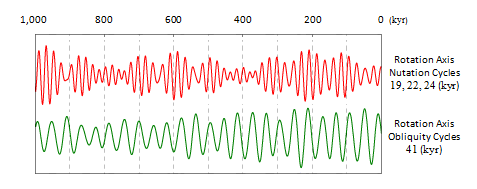 [167] [167]
(Fig. 1) Graph (Rohde, 2005; adapted, McGraw, 2014) showing in thousand year multiples, both Earth's rotational axis nutation cycle or "obliquity radial angle frequency" (θdt-1) to complete a single nutation of the rotational axis (wobble) at top (red oscillation) the radial angle velocity, (θdt) rendered as amplitude, along with axis obliquity inclination cycle (green oscillation) or tilt periodicity and angular range in amplitude (Hays, Imbrie, Shackleton, 1976).[168] The sum of these two functions, typically misunderstood for being true apsidal (perihelion) precession of Earth's rotating elliptical orbit about the Sun.
|
The "celestial pole" wobble like nutation rate of Earth's rotational axis of ωp = 50.291" arcsec per year along the ecliptic (J2000.0)(Stacey and Davis, 2008),[169] or a rate of ≈ 46" arcsec along the celestial equator (Zeilik, and Gregory, 1998),[170] one nutation or rotation cycle having a period of 24, 22, 19, 17 kyr, depending on mechanism, effecting both the angular velocity (period) and till angle (amplitude and domain), "rate of change" for Earth's oblique axis tilt. The obliquity tilt varying in a range from 22o-24o degrees with a principle 41 kyr oscillation cycle in addition to supperpositioned lesser cycles of 39, 59, and 29 kyr (Hinnov, and Hilgen, 2012).[171] Such axial nutation values not inclusive of the more error prone value of true planetary precession or perihelion (apsidal) drift (Zeilik, and Gregory, 1998).[172] The possibilities of orbital drift being inclusive of both prograde and retrograde motions, perihelion drift being prograde or advancing motion.
The viable time frame for empirically determining the historic orbital mechanic oscillations of Earth's axial nutation empirically determined by Hinnov, and Hilgen to be 10-20 million years. The maximum determinable period, limited by extra Terran system gravitational perturbation resulting in rapidly diminishing function accuracy, not exceeding 35-60 million years (Hinnov, and Hilgen, 2012).[173] The apparent seasonal discrepancies in the lifa, relative to the placement of the 28 xiu (lunar mansions), though possibly open to other justifications, raising attention as to the understood accuracy of Earth's historical rotation and revolution orientations during the past 5,000 years or greater.
True "planetary precession", known as prograding perihelion or apsidal precession, of Earth's orbital path about a focicentric Sun (Bergmann, 1968, 1987, 1992),[174] explicitly the rotation of Earth's elliptical orbit foci, (Ramsey, 1991; Lerner, and Trigg, 1991)[175] being inclusive of the asymmetric perimeter boundary (Fig. 2). The orbital element for perihelion advancing, apsidal precession (ω) the argument of perihelion (Fitzpatrick, 2012)[176] or the advancing of the "argument of perigee", and angle measured between the vernal equinox apsis (node) and perihelion point (Encrenaz, Bibring, Blanc, Barucci, Roques, and Zarka, 1991)[177] defined as the "line of apside" or apse line (Thomson, 1963, 1984).[178] The value for the radially and interiorly pointing orbital component for the "argument of perigee" called "longitude of perihelion" or variable, (ϖ), (Fitzpatrick, 2012),[179] being ϖ = 102.94719o degrees longitude (J2000.0)(Williams, 2013).[180]
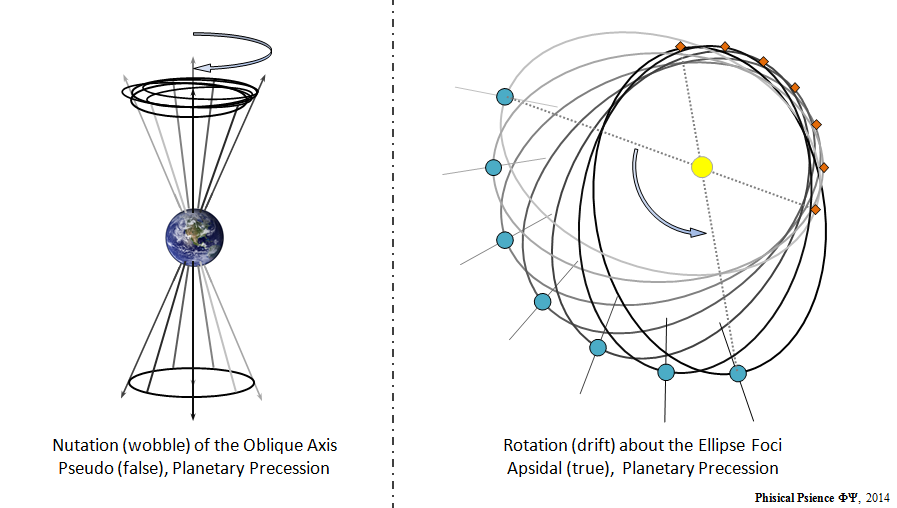
(Fig. 2) The notional illustration (McGraw, 2014) in the left frame presents both, the local general effects produced from Earth's celestial pole nutating, wobbling oblique axis (left top) or false planetary precession in addition to an example of non perturbed gyroscopic precession (left bottom), thus excluding the effects of "non axial symmetry" related Chandler wobble (Stacey and Davis, 2008),[181] compared to in the frame at right, the prograde or counter rotating and extended effects (right) produced by elliptical orbit, foci rotation (Ramsey, 1991; Lerner, and Trigg, 1991)[182] and example of true planetary precession with rotation of the "line of apsides" (Moulton, 1902, 1914, 1962)[183] (grey dotted line). Both phenomena, nutation of the revolving axis and apsidal precession of the orbit resulting in right ascension (RA) like, ecliptic translation of the background stars, thus zodiac, though at different rates of change and angular domain. Earth's nutation and obliquity rate of change being more dynamic and greater in amplitude than the effect of apsidal precession. The frame at left resulting in precession of the seasons, as the "anti solar point" (opposite side of the Sun from Earth) remains stationary with nutation. The frame at right resulting in the repositioning of the anti solar point (orange squares), the 28 xiu and zodiac constellations moving in tandem.
|
One rotation of Earth's elliptical orbit, resulting in a required zodiacal sign theoretical angular translation rate of ωth = 12.79" arcsec per year and observed translation rate of ωobs = 11.45" arcsec per year (J2000.0)(Fitzpatrick, 2012)[184] along the ecliptic. The two values, the theoretical and observed rates differing by a fairly large 11.7% percent. The translation velocity approximately 0.3181o-0.3553o degrees per century, or one prograde rotation of Earth's elliptical orbit axis (foci) every 101,323-113,172 years. Apsidal precession being an independent and unrelated, non coupled celestial mechanic phenomenon from nutation of Earth's oblique rotational axis (Moulton, 1902, 1914, 1962).[185]
The principle visual effect from nutation of the oblique axis, the inclination plane of the Earth relative to the angle of the invariable plane (i) of the solar system at i = 1.57o degrees (J2000.0)(Vitagliano, 2003, 2011; McGraw 2011)[186] being slightly more than 14.01-15.29x times greater in apparent reciprocation range and declination swing amplitude of the ecliptic path per axis rotation (nutation) and ≈ 4-5x times higher "angular rate of change" precession like effect relative to true precession or apsidal precession, with respects to the apparent and collective motion of all the background stars, or pseudo planetary precession.
Apsidal precession being the principle reason for the Moon's elliptical orbit start and end points each month to drift in right ascension, not precisely overlapping relative to the longitude location of the background stars (Fig. 3). One rotation of the lunar perigee taking ≈ 8.85 years (Encrenaz, Bibring, Blanc, Barucci, Roques, and Zarka, 1991).[187] The orbital path differential in the Moon's monthly orbit leading to the Moon's orbital nodes for a tropical (lunar) month to translate in longitude and out of phase with the tropical year.

(Fig. 3) Notional illustration (McGraw, 2014) of the Moon's incline elliptical orbit (iM) and orbital nodes (orange markers) relative to Earth's inclined elliptical orbit and orbital nodes (red markers) about a focicentric Sun, superimposed upon the solar system's mean or invariable plane (i) and illustration reference plane. The Moon's orbit inclined iM = 5.145o relative to Earth's ecliptic path, the Earth's orbit inclined i = 1.57o relative to the invariable plane for (J2000.0). The longitude of ascending node, (Ω), for non highly inclined orbits being the difference between the "longitude of perihelion", (ϖ), and the "argument of perihelion", (ω), or (ϖ - ω) = Ω (Fitzpatrick, 2012),[188] thus Ω = -11.26064o degrees (J2000.0)(Williams, 2013).[189]
|
The progressively growing difference in synchronicity between the Moon's orbit relative to Earth's orbit about the Sun, inducing the ancient Greeks, per Geminos (ca. 90-35 BCE), to implement the use of periodic intercalary (έμβόλιμοι) months on alternating years (παρ' ένιαντόν)(Censorinus ca. 1st c. BCE; Heath, 1897, 2002).[190] Attempts to synchronize the Moon's orbit relative to Earth's orbit about the Sun for calendrical purposes, leading the Babylonians to produce a multiplicative factor of 223 synodic lunations, or ≈ 18.03 years, for viewing repeating eclipse events for the same day (North, 2008).[191] A synodic month being equal to 29.530.589 days (J2000.0)(Evens, and Berggren, 2006).[192]
The time for the Moon to go from vernal equinox point, thus the Moon's minimum radius distance and apsis, returning to a state of angular coincident with the vernal equinox (Fitzpatrick, 2012),[193] or tropical month, 27.321.582 days (J2000.0), leading the ancient Greeks to discover the necessary cyclical conditions for viewing a solar or lunar eclipse for the same day and location on the Earth. This "location specific" eclipse viewing cycle structured about the draconic (nodical) months each draconic month being 27.212.220 days (J2000.0), or the time required for the Moon to revolve from an orbital nodal point along the ecliptic plane to the same nodal point location, thus in line and onto with the Sun for a specific location on the Earth.
Studies of the eclipse cycle frequency leading to the awareness of the 19 year Meton cycle, or when the viewing path of an ellipse event is likely to be repeated for the same region and time of the Earth's surface, and premised about the lunar synodic month of 29.530.589 days (J2000.0)(Evens, and Berggren, 2006).[194] The synodic month being the time required for the Moon to go from one new or full Moon to the next (North, 2008).[195] The 19 year Meton cycle corresponding to just over two revolutions of the line of apside between the Earth (ellipse foci) and the Moon.
The astronomical observation of the passing seasonal nodes being understood by some as having already been integrated into the late or classic Longshan culture (2500-1900 BCE)(Liu, and Chen, 2012)[196] or (2600-2000 BCE)(Chang, Pingfang, Liancheng, Wangping, Youping, Wenming, Zhongpei with Hong, and Renxiang, 2002)[197] of central China (Zhang, and Fan, 2003)[198] (Fig. 4). That by the time the Zhou bi (周髀) "Gnomon of the Zhou" is believed to have been recompiled (ca. 2nd-1st c. BCE)(Li, 2005)[199] during the Han Cháo (漢朝)[200] (Han Dynasty)(206 BCE-220 CE)(China National Bureau, 1999)(Li, 2005),[201] the Chinese fully understanding for the better part of 2,500 years prior (xxxx, xxxx)[202] the path of the Sun and Moon, tài yīn (太阴)(Rowe, 2011) in the sky.[203]
II) BACKGROUND
The Táosi Guānxiàngtài yízhǐ (xxxx, xxxx)[200] (陶寺观象台遗址)[xxx] Táosi Observatory archeological ruins (ca. 2100 BCE)(Wu, Chen, and Liu, 2009)[xxx] [+36.0o N, +XX.0o E] (xxxx, xxxx),[111], UNESCO (Case Study 5.1)[xxx] near the Fén River valley (Pankenier, Liu, and De Meis, 2008)[xxx] (汾河)(Fén He),[xxx] and tributary to the Huang He (黃河)[xxx] Yellow River in Xiāngfén Xián (襄汾县)[xxx] Xiangfen County, Linfén City (临汾)[xxx] Shānxī Shěng (山西省)[xxx] Shanxi Province, formerly known as the ancient Yào Wángguó (堯王果)[xxx] (2356-2255 BCE)(Wangwei, 2013)[xxx] Yào Kingdom) capital city of Píngyáng (Zhang, and Fan, 2003)[xxx] (平陽),[xxx] excavation site IIFJT1 (Wu, Chen, and Liu, 2009),[xxx] and perhaps a detached complex to Shùn Dì (舜帝) Emperor Shun (Fig. 5), born as Yáo Chonghua (姚重華)[xxx] (2255-2205 BCE)(Zhang, and Fan, 2003),[xxx] former palace (Figs. 6, 7) having enclosed a possible solar observatory used to monitor the passing of the seasonal nodes (He, 2007a)[xxx] (Figs. 8-10).
Additional chronological studies released during the summer of 2013, indicating that the Táosi ruins, and possibly an inherited product in addition to being associated with the former capital of the Yáo Wángguó (Yao Kingdom)(2356-2255 BCE)(Zhang, and Fan, 2003),[xxx] maybe older than previously believed by about 500 years, perhaps separately establish from ca. 2800 BCE (Wangwei, 2013).[xxx]
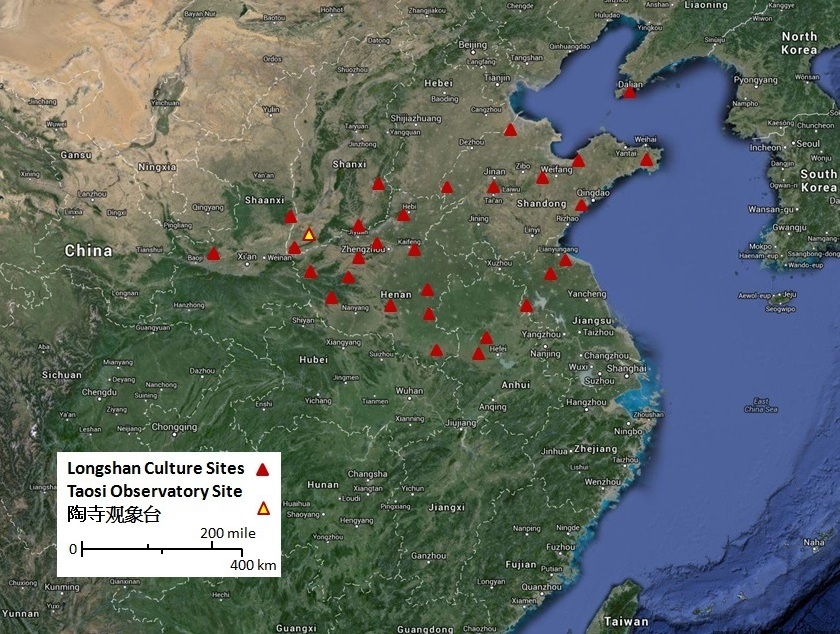 [129],[130] [129],[130] 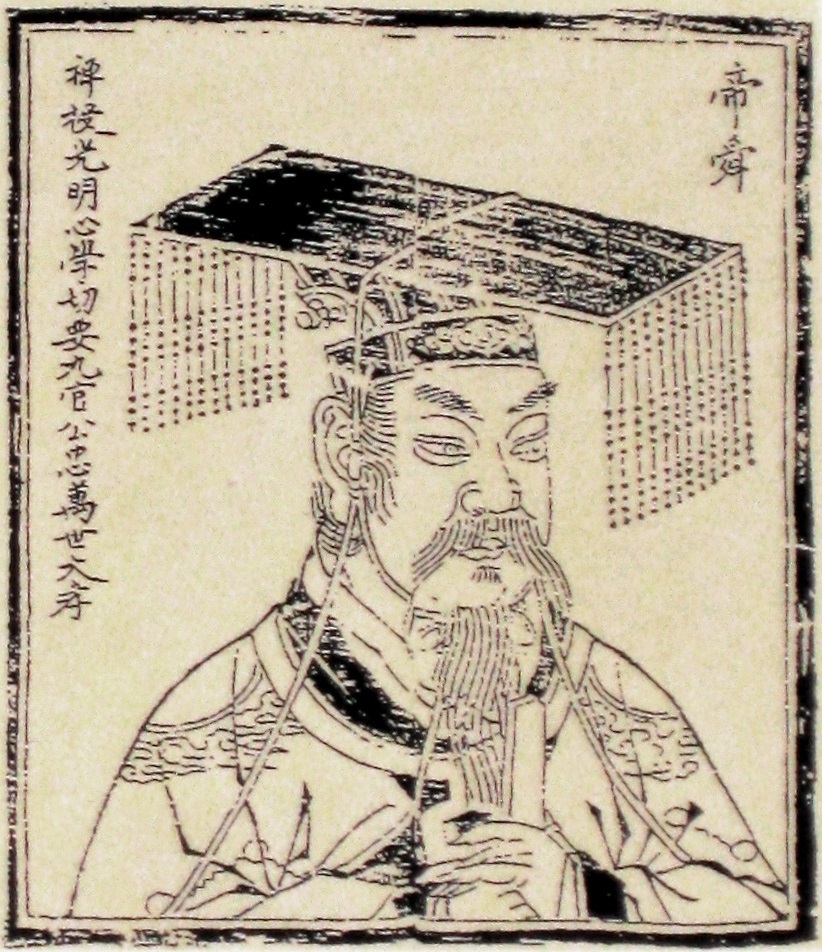 [131] [131]
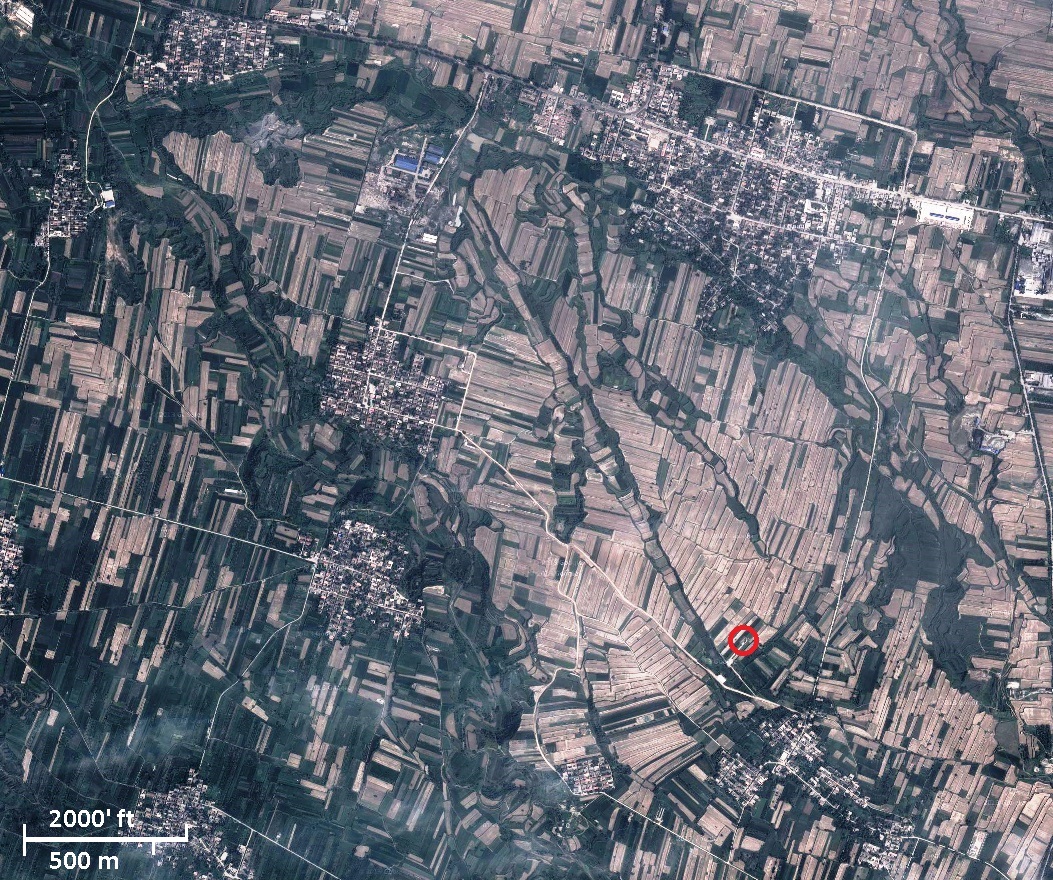 [132] [132] 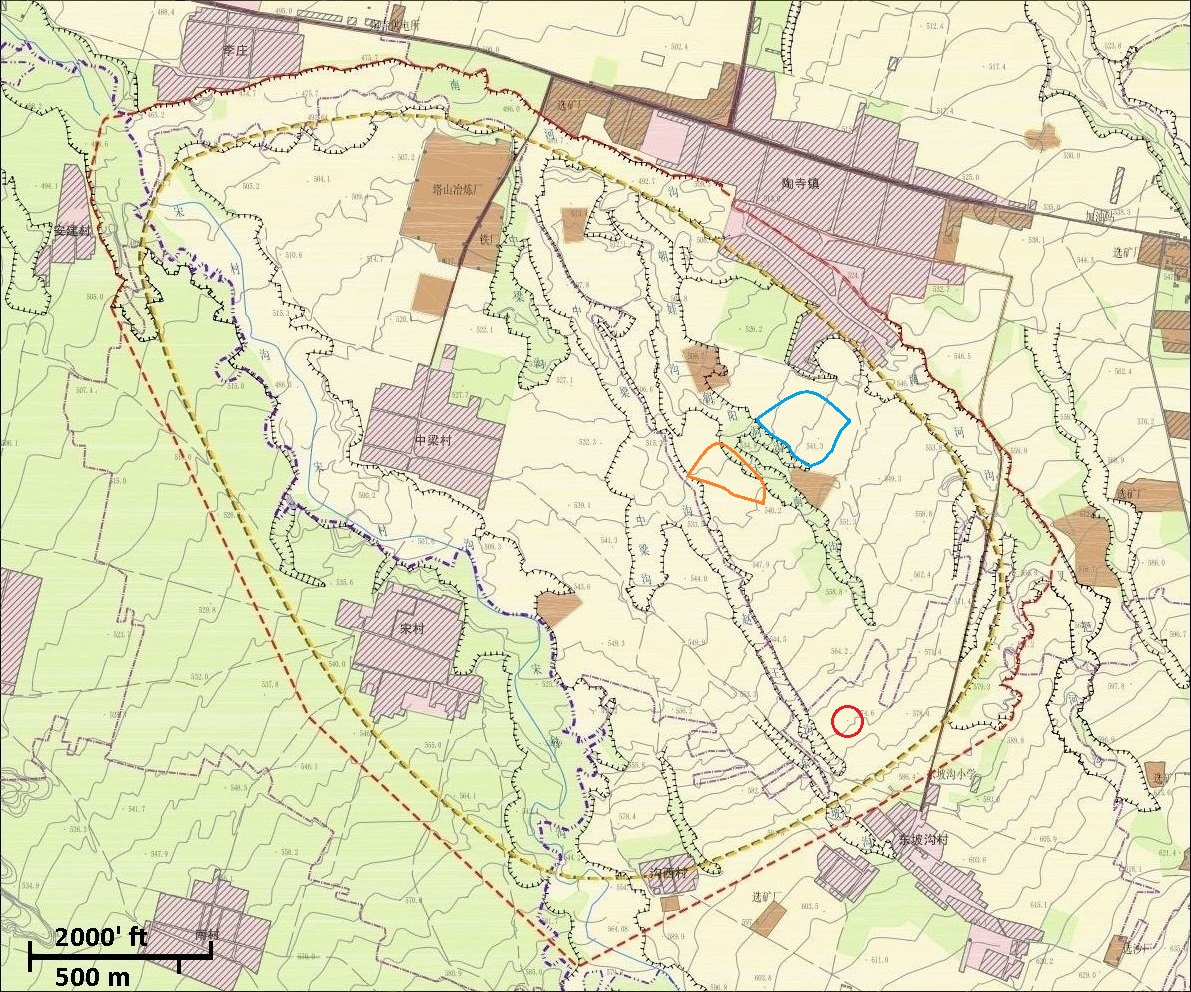 [133],[134] [133],[134]
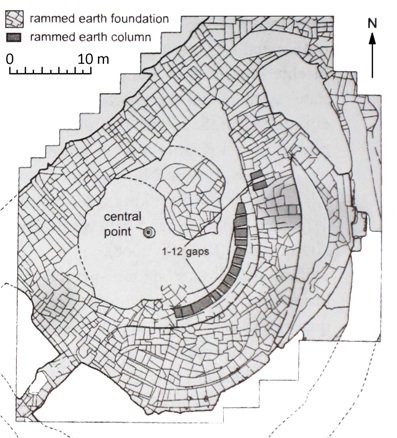 [135] [135] 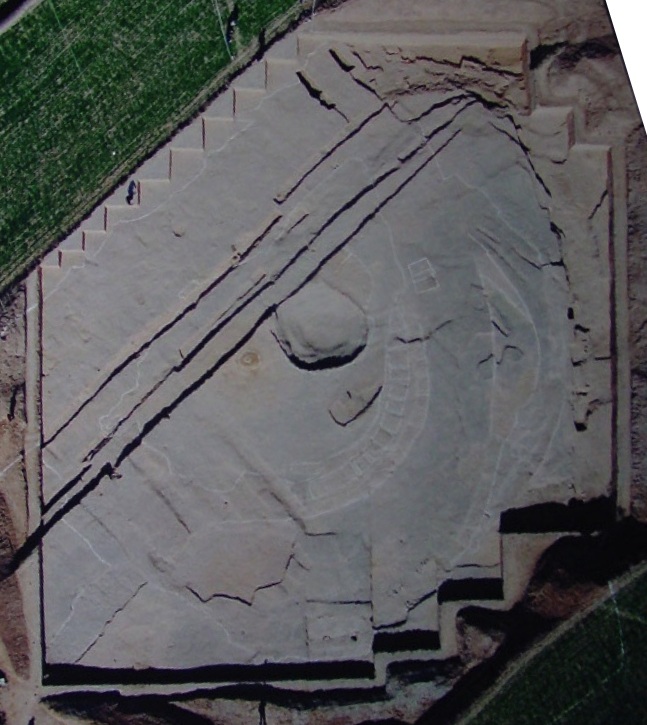 [136] [136] 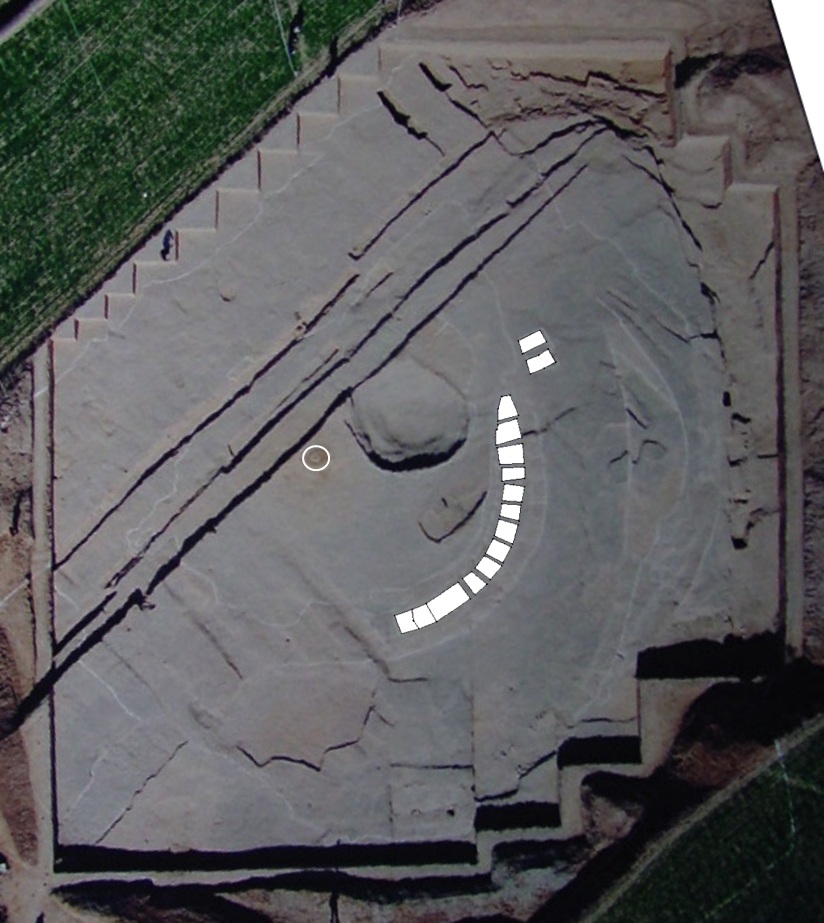 [137] [137]
(Fig. 4, upper left) Satellite image of central China indicating the location of the principle Late Neolithic Longshan archaeological sites (red triangles) in addition to the region near the ancient city of Píngyáng (平陽), today known as Linfen City (临汾), and Táosi Observatory (red triangle with yellow center) (Zhang, and Fan, 2003; Google Map, 2014, adapted, McGraw, 2014).[138], [139] (Fig. 5, upper right) Woodblock print illustration of Shùn Dì (舜帝) Emperor Shùn, artistically rendered in Qín Cháo 秦朝[140] (221-206 BCE)(Zhang, and Fan, 2003)[141](Qín Dynasty) like attire. (Fig. 6, center left) Satellite image of the region just east of Linfen city, Shanxi China with the location of the Táosi Observatory noted (red circle)(Google Map, 2013, adapted, McGraw, 2013).[142] (Fig. 7, center right) Geological survey map of the Táosi region outlining the principle expanse of the Yao capital (中国建筑设计研究院建筑历史研究所的歷史, China Architecture Design and Research Group Institute of Architectural History, 2013; adapted, McGraw, 2014),[143] the palace proper outlined in blue and north of the observatory (red circle) by ≈3,000' ft (915 m), the elite residences area outlined in orange (Feng, 2013).[144] The Yao capital covering an area of ≈3 million m2 (Chang, Pingfang, Liancheng, Wangping, Youping, Wenming, Zhongpei with Hong, and Renxiang, 2002)[145] or 3 km2 (≈740 acres or 1.1 miles2).[146] (Fig. 8, lower left) Scaled háng tǔ 杭土[147] (rammed earth)(Chang, Pingfang, Liancheng, Wangping, Youping, Wenming, Zhongpei with Hong, and Renxiang, 2002)[148] floor plan drawing of Táosi Solar Observatory along with the location of the central point for the biǎo (表) or gnomon (Cullen, 1996)[149] staff, low profile pedestal and template indicated (Xie, 2007; Guojia, 2002; He, 2007a; adapted, McGraw, 2013).[150] (Fig. 9, lower center) Aerial view of Táosi Solar Observatory (Xu, and He, 2010).[151] The large hemispheric shape of the solar observatory complex being ≈130' ft (40 m) in diameter (He, 2013).[152] For a sense of scale, the three small irregular dark objects about the site perimeter, one near bottom center, in addition to one near the 9 and two at 10 o'clock positions being human shadows. (Fig. 10, lower right) Táosi solar observatory with pillar defined aperture mask array superimposed with small circle marking the location of the gnomon pedestal (Xie, 2007; Guojia, 2002; He, 2007a; Xu, and He, 2010; adapted, McGraw, 2012).[153] The distance from the gnomon to the closest pillar being 10.8 m (35.4' ft)(Wu, Chen, and Liu, 2009).[154]
|
The ancient Chinese acutely sensitive to the basic observational condition, being geographically located in the mid latitude region of the northern hemisphere rather than near the equator, that on the first day of winter, the Sun rose low in the southeast late in the morning, remaining low in the southern sky at noon casting the longest shadow of the year, followed by setting low in the southwest (Fig. 12). Such that as the year advanced towards the summer solstice, xiá zhì (夏至) the Sun would rise earlier in the morning, reaching a higher culmination (elevation) angle each day, setting latter in the evening (Cullen, 1996).[155] In addition, the Chinese being equally aware that the rate at which the Sun moved in elevation (declination axis) angle along the local meridian, or azimuthally along the horizon per day, accelerating from winter to summer and decelerating from summer to winter (xx, xx).[156]
In 2009 a 180 cm (5.9' ft) length lacquer pole was discovered in royal tomb IIM22 (xxxx, xxxx)[157] that has since been identified as a biǎo (表) or gnomon (Cullen, 1996)[158] staff for producing incline shadow measurements for determining the Sun's culminations, sunrise and sunset locations, dated to ca. 2100-2000 BCE (He, 2009).[159] The single staff biǎo, evolving into the guī biǎo sundial, and nearly identical to the standard Egyptian sundials used during the reign of Pharaoh Thutmose III ca. 1500 BCE (Barnett, 1998).[160] The Egyptian obelisk (ὀβελίσκος),[161] (Fig. 8) from the time of Pharaoh Seti I (ca. 14th c. BCE)(Whitrow, 2004)[162] with such prime example as the 13th c. BCE quarried obelisk positioned at the Vatican (Linda Hall Library, 2002)[163] or enlarged modern facsimile the Washington Monument, (Fig. 9) gnomon sundial devices (Whitrow, 2004)[164] for public display, functioning in an identical manner as the Chinese biǎo.
Since both zenith oriented (Carroll, and Ostlie, 1996)[174] gnomons, the Vatican Obelisk in Rome (+41.9o N)[175] and the Washington Monument in District of Columbia (+38.53o N)(National Geodetic Survey, and Kimberling, 2009)[176] are located beyond the imaginary girdle about Earth's northern hemisphere called the "Tropic of Cancer" or above (+23.4o) north latitude, the reciprocal location for the southern hemisphere being called the "Tropic of Capricorn" at (-23.4o) south latitude (xxxx, xxxx)[177] or greater, and the direct product of Earth's 23.4o oblique (tilted) rotational axis with respects to the ecliptic (NASA, J2000.0),[178] at no time during the course of a year experience the Sun momentarily directly overhead at the zenith point (xxxx, xxxx),[179] and "zero shadow" moment on an otherwise sunny solar (meridian) noon (xxxx, xxxx).[180]
Gnomons located between (+23.4o)-(-23.4o) momentarily casting a shadow directly beneath their own base, or nadir (Burnham, 1966, 1978)[181] shadow, as the Sun transits the zenith, resulting in no noon time shadow being visible because of "self obstruction" for two days of the year. The north-south meridian aligned transit of the zenith point by the Sun being a "double pass" event less precisely located at +23.5o N or -23.5o S (xxxx, xxxx),[182] to which a singular event. It being very probable that the cities of Guangzhou (23.13o N), Macau(23.17o N) and Hong Kong (22.28o N)[xxx] China exist where they do, being geographic markers since these cities reside very near the Tropic of Cancer and as such simple to confirm their longitude location, having no gnomon shadow near the time of the summer solstice, the Sun transiting the zenith.
 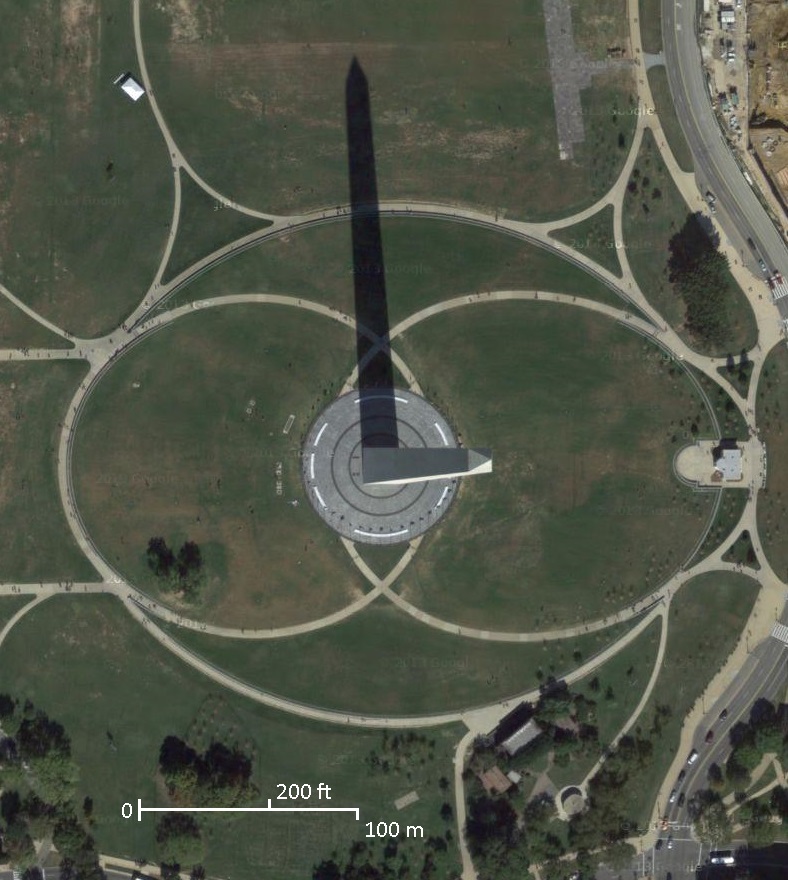 [171] [171]
(Fig. 8, left) Photo looking north (McGraw, 2006), at the 25.31 m (83' ft) tall, 8.25 m (27' ft) circumference at base, ≈1 million pound (453,600 kg) Egyptian obelisk (ὀβελίσκος)[172] located at the center of the north-south aligned elliptical St. Peter's Square, Vatican, Rome, also known simply as the Vatican Obelisk. This obelisk, brought back to Rome by Emperor Caligula in 37 CE from Heliopolis (Alexandria) Egypt, stood at the emperor's circus located south of the basilica, eventually relocated to the center of St. Peter's Square in 1586 by Domenico Fontana by order of Pope Sixtus V followed later with the placement of the metallic ornament atop (xxxx, xxxx).[173] (Fig. 9, right) Satellite photo (US Geological Survey, and Google Maps 2014; adapted, McGraw, 2014) of the 81,120 ton (73,590 metric ton), 555' ft 5" inch (169.3 m) tall Washington Monument (National Park Service, 2011)[174] at the center of the 17.24 acre (751,071' ft2)(69,777 m2) east-west aligned "Ellipse" in Washington D.C. (National Geodetic Survey, and Kimberling, 2009).[175] The image collected just short of local meridian noon, the Sun being very near to culmination, thus maximum elevation angle in the sky, portraying this obelisk gnomon with close to minimum shadow length for the day. The Washington Monument, upon the setting of the cap stone in 1884, the tallest building in the world (National Park Service, 2014),[176] today still the tallest classically shaped obelisk.
|
Note in the photograph of the Washington Monument (Fig. 9) towards the top of the frame, the slightly arcing shape and gradient nature of the beige colored, worn grassy region above and to the left (west) of the shadow tip. This accentuated wear pattern produced by people strolling in tandem with the easy to observe, slowly moving shadow image on the ground, which near midday travels at a rate of ≈100 m/hr or 1.6 m/min (≈328' ft/hr or 5.5' ft/min). The monument's radial shadow, over the prior couple a weeks, appearing to be growing in length, thus post the summer solstice. The shadow tip location incrementally translating each day towards the north, this determinable from wear patterns in the grass. The lawn to the south and inside (anterior) the radius of the shadow tip, recovering from pedestrian traffic, the vegetation returning to a more healthy green appearance. Neither gnomon, the obelisk nor the biǎo, to remain fully functional, needing to be used in conjunction with or benefiting from the implementing of an aperture mask array.
Principle studies of the Táosi Astronomical Observatory (TAO) (中国科学院自然科学史研究所, Institute for the History of Natural Sciences, Chinese Academy of Sciences, 2011),[177] and solar facility (Wu, 1999, 2000; Guojia, 2002; Wu, and He, 2005; Xie, 2007; He, 2007, 2007a; Li, and Chen, 2007, Pankenier, Liu and Meis, 2008; Wu, Chen, and Liu, 2009; Xu, and He, 2010; Sun, 2011; He, 2013; Huang, 2013; Feng, 2013) being previously centered about the task of utilizing the complex as a direct viewing, forward line of sight (LOS) instrument with fixed aperture mask array for observing and measuring the sunrise (Pankenier, Liu, and De Meis, 2008).[xx] The method limited in forward horizon field of view (FOV) from the understood placement of large monolithic vertical pillars oriented to provide narrow backlit sighting apertures, the pillars placed upon a foundation of interwoven wood planks and soil or háng tǔ 杭土[xx] also known as rammed earth (Chang, Pingfang, Liancheng, Wangping, Youping, Wenming, Zhongpei with Hong, and Renxiang, 2002)[xx] along a partially concave arcing array some 10 m (30' ft) from the biǎo 表 (vertical gnomon). The four critical, double pass solar observations per year, there being from the facilities inherent design 11 possible time frames per year and unorthodox number of astronomical sightings, intuition suggesting 12 or 13 annual viewings of the Sun or Moon, being concentrated about the four weeks around the solstices and equinoxes.
The standard and highly restrictive method proposed for the implementing of the instrument at Táosi Observatory, being noticeably void of supportive processes expressing standard operational techniques beyond direct and simple, naked eye, forward sighting of the instrument. The singular method currently stated to operate the facility at Táosi, not integrating closely the simultaneous or concurrent collecting of solar data by way of the forward aperture array sightings in association with an incline shadow tip image produced by a height sensitive[xx] vertically orientated biǎo (gnomon), the image of the shadow tip needing to be cast upon a uniform and level common surface area. The Táosi complex, from what has been shown, appearing too small in area and too non uniform in surface finish to ever obtain the necessary degree of shadow tip placement measurement uniformity and accuracy required of a ground landing, incline shadow gnomon, relative to the location of the rising Sun.
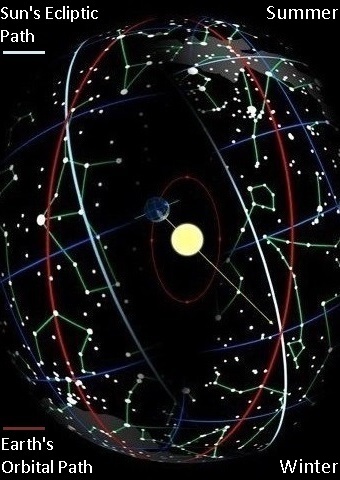 [xxx] [xxx] 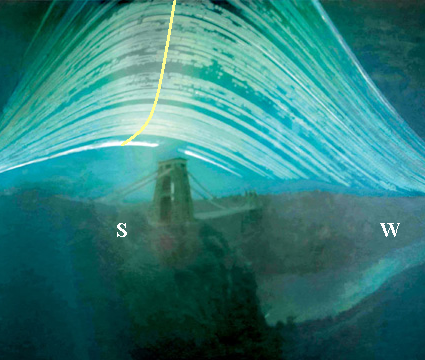 [xxx] [xxx] 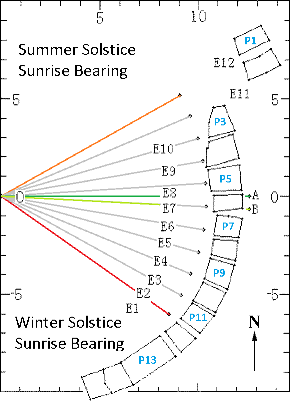 [xxx] [xxx]
(Fig. 10, left) Illustration (rotated 90o clockwise)(xxxx, xxxx; adapted, McGraw, 2013) of the Sun's ecliptic path (silver) in addition to Earth's orbit (small red circle) cast upon the background ecliptic constellations or zodiacal signs.[xx] The obliquity (tilt) of Earth's rotational axis producing an inclination in the Sun's path as seen from the Earth (xxxx, xxxx).[96] The two seasonal equinoxes, spring (vernal) and fall (autumnal) being the moment in time when the two paths intersect. Earth's orbit dipping below the ecliptic on the first day of spring (lower right), reaching apogee (farthest point) with the Sun on the summer solstice (top), rising above the ecliptic on the first day of fall (upper left), reaching perigee on the winter solstice (bottom)(xxxx, xxxx).[97] The illustration rendering the Earth during the vernal equinox (spring), facing towards the antisolar point, or the opposite point of orbit colloquially known as the far side of the Sun, in the direction of the constellation and sign, Aries (xxxx, xxxx).[xx] (Fig. 11, center) Extreme long duration, multi exposure photograph of the Sun's path (slightly clipped at top) across the sky, capturing a six month period from winter solstice (bottom) to summer solstice (top and out of frame) or "positive declination" solargraph as seen from the United Kingdom (xxxx, xxxx; adapted, McGraw, 2013).[98] The curved line (yellow) corresponding to the peak elevation (inclination angle) location of the Sun's path in the sky or culmination point, otherwise known as local "solar noon". The daily culmination point drifting along the Sun's ecliptic path from left (east) to right (west) representing a movement from winter to summer. The Sun translating in right ascension (RA) angle at a non linear rate of change, the movement in right ascension being a dependent function of Earth's acceleration and deceleration along its elliptical orbit about the Sun.[99] The Sun's return path (negative declination) from summer to winter resulting a culmination point trace reciprocal in nature to the positive declination trace, producing a near vertical mirror image. The elevation angle range of the culmination point being a product of Earth's oblique rotational axis.[100] (Fig. 12, right) Scaled illustration in meters of the Táosi aperture mask array with gnomon pedestal at left center, highlighting the azimuth "line of sighting" (LOS) for the summer (orange) and winter solstice (red) along with the bifurcated sighting E7 producing the fall, A, (green) and spring, B, (light green) equinox nodes (Wu, 2007; adapted, McGraw, 2013). This rendering being premised about 9 equally segmented angular divides (fixed rate, angular velocity)(grey lines), resulting in the 11 sighting paths E2-E12 (Pankenier, Liu, and Meis, 2008) for each six month, binodal period (half orbit of the Earth) or 22 sighting total per year.[101] These 11 arbitrary LOS values being inconsistent with the non linear (variable rate, angular velocity) location of the sunrise at the start of each of the 12 calendar months or sunrise location at the start of any one of the 13 lunar months in a year. The inherent non overlapping, non onto nature of the two equinox nodes, A and B, being a function of Earth's changing angular velocity generated by its elliptical orbit around the Sun (xxxx, xxxx).[102] Attempts to ephemerally compensate for the current epoch (Fig. xx) not being of the correct nature or sufficient in value to place the rising Sun and transit motion for the four seasonal nodes reasonably close to the vertical center line and apparent horizon of the nearest available aperture gap during the course of a single year.
|
Contemporary analysis of the Táosi Observatory site, including field work to visually critique and verify the Sun's rising location on the apparent horizon relative to the position of a fixed and stationary gnomon during the solstices and equinoxes, having been conducted in a manner that incorporated the use of 11 vertical "pillar apertures" for sightings angles E2-E12 (Wu, 1999, 2000),[103] located between pillars P1-P12 (Fig. 8). Per this discussion, the pillars to be noted in general form as (Pa[n]). The sighting angle E7 and used for equinox events being bifurcated by Wu (1999, 2000) into two, non site plan inherent, sighting angles "A", (E7A), and "B", (E7B), so as to better accommodate the true location of the vernal and autumnal equinox. These two equinoxes being non superpositioning events of the Sun or onto relative to their respective appearance locations on the eastern horizon. The Sun, because of Earth's orbital mechanic properties, Earth's orbit being elliptical in shape and non linear in angular rate of change, resulting in the Sun to rise from two separate azimuthal bearings for each discreet equinox event.
Of the 12 possible pillar aperture (Pa | E1 → E12 ) locations per half year viewing cycle, for a total of 24 sightings per annum, only 11 sighting angles, E2-E12 being angularly eligible for solar alignment use irrespective of known clipping restricts resulting from self generated physical obscuration of the Sun by the apparent location and placement of the pillar themselves (Wu, 1999, 2000). The number of independent and potential calendar year sighting (CS) of 22 (CS = 2Σ Pa[n]) suggesting that the sighting aperture count provided by Wu (1999, 2000) is not a simple corresponding function of months in a Chinese calendar year (Tbl. 3). The total potential number of sighting paths given per site floor plan over a half year period, remaining inconsistent in terms of the intuitive number of desired sightings opportunities of the Sun, independent of the restrictive spatial arrangement of the pillars.
III) METHODOLOGY I
Further studies performed by Pankenier, Liu and Meis (2008) from 1999-2000 also devising and implementing 12 azimuthally uniform and evenly spaced sighting angles E1 (60.35o azimuth)-E12 (131.07o azimuth) situated about the 11 pillar sighting paths E2-E12 (Wu, 2007) (Fig. 8) and angularly between and nearly coincident with the two seasonal node end points, summer and winter.[104] Generating an additional and virtual 12th sighting path between slot aperture E10, pillar P4 and slot aperture E5, pillar P8 (counting clockwise pillar 1 path 1 equivalent to viewing line of sight E12, pillar 12 path 12 equivalent to line of sight E1). The azimuthal bearing for each of the sighting angles premised upon what appears to be placement optimization as a function of desired sighting angle, irrespective of the Táosi observatory floor plan or the non linear azimuthal bearing line of sight requirements produced by Earth's elliptical orbit about the Sun.[105]. The 3 principle pillar gaps, along with the remaining 8 gaps, relative to the pass 4,000 years, failing to correctly correspond with any Chinese calendar cycle, or Earth's orbit about the Sun.
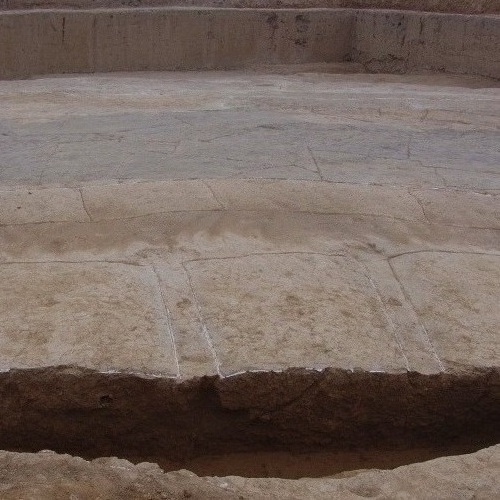 [xxx] [xxx] 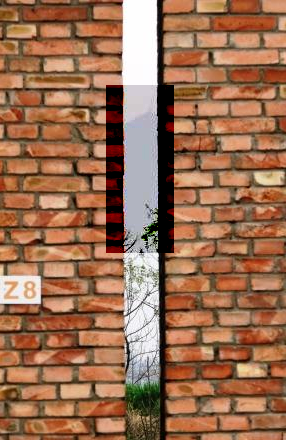 [xxx] [xxx] 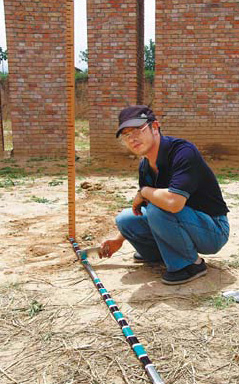 [xxx] [xxx]
(Fig. 13, left) Photo of Táosi observatory pillar foundation excavation showing an exposed cross section of several of the rammed Earth pillar footings (He, 2010).[109] The possible building materials used for each pillar that being stone, formed rammed or encased earth, given a typical pillar ≈0.5 m x 1.5 m (≈0.75 m2) in area (Tbl. 5) and 3-4 m in height (Pankenier, Liu and Meis, 2008)[110] producing a pillar ≈2.25 m3 (≈80' ft3) in volume. Using a rammed soil density of 1,600 kg/m3,[111] resulting in an impractical typical mass of 3,600 kgs (7,920 lbs) or greater, for each pillar. Possible alternatives construction materials being cast terra cotta segments or wood timbers fashioned together as a single pillar. An observatory design and construction method utilizing 13 monolithic pillars, independent of material selection, introducing additional complications in the alignment, placement and final dimension of the pillars. For every alteration in azimuth bearing, rotation and or radial translation of a single pillar resulting in a complementary, cascading alterations in the width and shape of each adjacent pillar to maintain viable aperture openings between the 12 pillars, thus the center lines of the vertical apertures simultaneously remaining coincident with the line of sight between the Sun in the distant foreground with the anterior gnomon (biǎo) in the background. (Fig. 14, center) Photo of reconstructed testbed replica pillars made of brick at the Táosi observatory nearby study site (Whitworth, 2012).[112] Each of the pillars, to properly frame the Sun above the apparent horizon needing to be approximately 3 m (13' ft) tall (He, 2013).[113] Just visible through the haze, about 2/3 up the aperture gap, assisted with an enhanced image section, can be seen the summit of Chong Mountains, Táer Shan (塔儿山)[114](Táer Mountain)(Xu, and He, 2010; adapted, McGraw, 2014).[115] (Fig. 15, right) Photo of Nu He (China Daily, 2009)[116] in front of testbed replica, brick pillars P11 (left) - P13 (right) with simulated biǎo or gnomon (brown measured staff) inserted upright, casting a short, mid day shadow. This sort of incline shadow method for determining the time and position of a near horizon event being less than ideal, requiring very long gnomon shadow image projection paths (Fig. 25).
|
The non uniform placement of the collective pillar sightings apertures E12-E2 being very noticeable in the photo of the Taosi solar observatory reconstruction (Figs. 12, 13), completed in 2013 (Huang, 2013).[117] The measured (normalized) solar illumination flux value (Φ)[118] exterior the nominal biǎo (gnomon) location for pillar sightings E2-E12 (horizontal axis), given uniform solar irradiance (I),[119] per width measurements of the backlit illuminated apertures, thus the effective area of the illuminated apertures and determined from the Huang photograph, being generally inconsistent with mathematically anticipated irradiance values for each of the vertical slot openings (Fig. 14). The normalized solar irradiance plot value (vertical axis) ranging from zero (no light) to one (full sunlight), (Φ | 0 → 1).
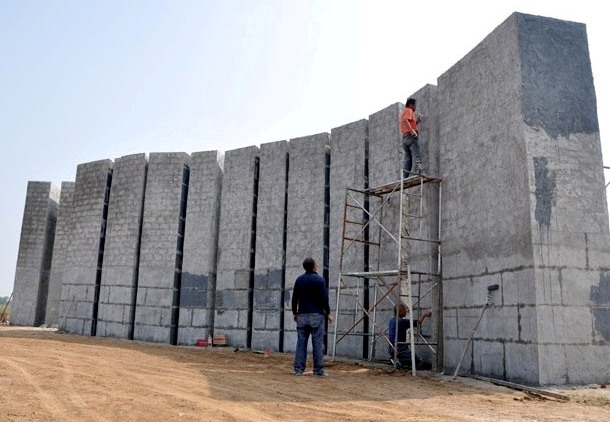 [xxx] [xxx] 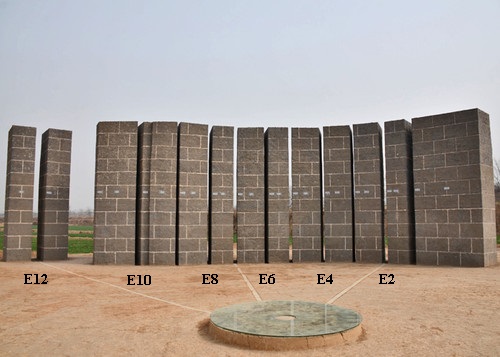 [xxx] [xxx]
(Fig. 17, left) Side front view of a full size recreation of the Táosi solar observatory aperture mask array near completion (Li, 2010).[122] This photo clearly presenting the depth of the pillars. This tall and heavy modern array approximation, the original rammed Earth Táosi structure perhaps exceeding 46,800 kg (>103,700 lb), being constructed atop a concrete slab foundation and robust soil stabilizing element not associated with the ancient facility. Had the pillar array been made of common sedimentary rock such as limestone blocks (2,600 kg/m3),[123] there being no residual evidence found to date for such stone construction methods being implemented at Táosi, exceeding 76,050 kg (>167,660 lb). Such massive pillars, if placed atop rammed soil, in just a few seasons or less, perhaps sinking into the soil, eventually tilting, thus altering the critical aperture field of view necessary to fully illuminate a vertical gnomon ≈10 m (32.8' ft) away. The large individual pillars, and reasonable to expect the people which designed such instrument must have completely understood thus anticipated in advance, that upon the completion of each pillar, being inflexible structures in terms of physical dimension adjustment, meaning that such structures would be less suited for post construction shaping and positioning for final assembly and integration. A procedure that should have had to been performed as rough construction methods and placement of the individual pillars would more than likely not have been sufficiently accurate to risk operational failure of the instrument using a single build to fit method. (Fig. 18, right) Frontal photo of Táosi observatory aperture mask array with bright background sky (Huang, 2013; adapted, McGraw, 2013)[124] revealing which sighting azimuth angles from slot E12 (left) to E1 (right) have a clear field of view (FOV) capable of illuminating a gnomon (biǎo), the pedestal mount being in the immediate foreground. The pillar gaps E10, E9, and E6 being dark slots, from geometric optics meaning that these slots are closed apertures[125] thus not capable of illuminating a vertical gnomon (biǎo). The pillar gaps E1, and E5 appearing just wide enough in angular width for a bright sunrise to pass an adequate amount of planar, undiffracted light upon a gnomon for a sufficient duration of time to accurately note the precise location of the incline shadow tip image upon a common level ground at a minimum distance of 14.2 m (46.6' ft) behind the gnomon for slot E5 and 91.6 m (300.5' ft) for slot E11 (Fig. xx). Capturing this image scene from directly above the gnomon mount location, altering the field of view some, hence line of sight with respects to the pillar gaps, resulting in a slightly different set of illuminated and non illuminated apertures, the array incapable of producing full illumination of the gnomon from all required sighting angles.
|
The Huang photo, taken "off axis" from the optimum equinox line of sight (LOS) reference azimuth bearing or pillar sighting E7, not of great concern with respects to the overall final illumination flux cosine plot from such orthogonal translation from the nominal biǎo (gnomon) location (Fig. xx). Such orthogonal displacement resulting in a magnitude reduction (amplitude modulation) and width compression (frequency modulation) of the illuminance cosine curve, leaving the general shape of the plot intact. The location of the photographer causing the optimized solar irradiance plot to shift towards the right side of the chart with the rate to which the illuminance values approaches I = 0 zero for the respective azimuth sightings increasing at an increasing rate, the slope of the irradiance cosine curve to the left and right of the irradiance plot apex (centerline) or negative inflection point, f 'Φ (θ ' ) = 0, being more negative in grade, reaching the zero value more rapidly.
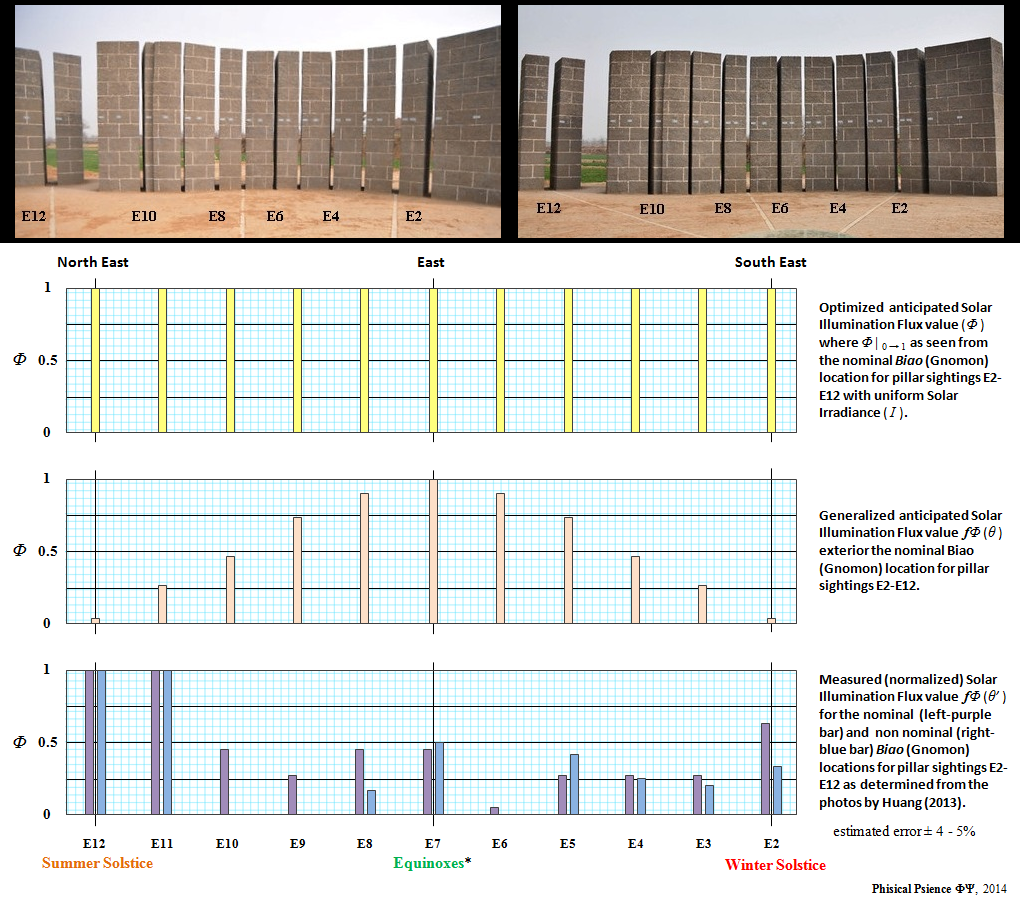 [xxx],[xxx] [xxx],[xxx]
(Fig. xx) ....[xxx], [xxx]
|
In addition to the undesirable failure of the four critical sighting paths (apertures), they being summer solstice, winter solstice and the fall and spring equinoxes, to properly align and transit the aperture widths, that or be consistently misaligned from a historical perspective taking into consideration such factors as non overlapping, non repeating precessions of the rotational axis[126] (Figs. xx, xx) in combination with arrhythmic oscillations in the obliquity of the Earth's rotational axis[127] (Figs. xx, xx) relative to the current epoch, thus capable of roughly determining historical ephemeral coordinate compensation values, further complicating the validation of the Táosi site as a solar observatory premised about a gnomon with incline shadow configured.
The sum effects on the position of the Sun along the horizon at Sun rise and set....
The following three diagrams below being void of "true precession" effects, and known as perihelion precession or apsidal precession.[xxx] Apsidal precession, and the same as precession of the zodiac or seasonal nodes, being the precessing (angular drift) of Earth's anti solar orbital point about the Sun (xxxx, xxxx),[xxx] and not the apparent precessing effects produced by nutation (wobble) of Earth's oblique rotational axis as shared by the Greek Hipparchus of Rhodes (Ἵππαρχος ὁ Ῥόδιος)(190-120 BCE)(O'Connor, and Robertson, 1999)[xxx] in his text "Peri tes metabaseios ton tropikon kai isemerinon semeion" (On the precession of the solstices and the equinox, ca. 150 BCE), or alternatively the rotating of the ecliptic as appose to the rotating of the celestial equator (Thurston, 1994) as stated (ca. 2nd c. CE) by the Greek educated Roman citizen of Egypt, Claudius Ptolemaeus (Κλαδιος Πτολεαος) Claudius Ptolemy, 83-161 CE (Ashmand, 1822), or 100-170 CE (Koertge, 2008).[xxx] The anti solar point today being in the direction of the ecliptic constellation (zodiacal sign) Aries (xxxx, xxxx).[xxx]
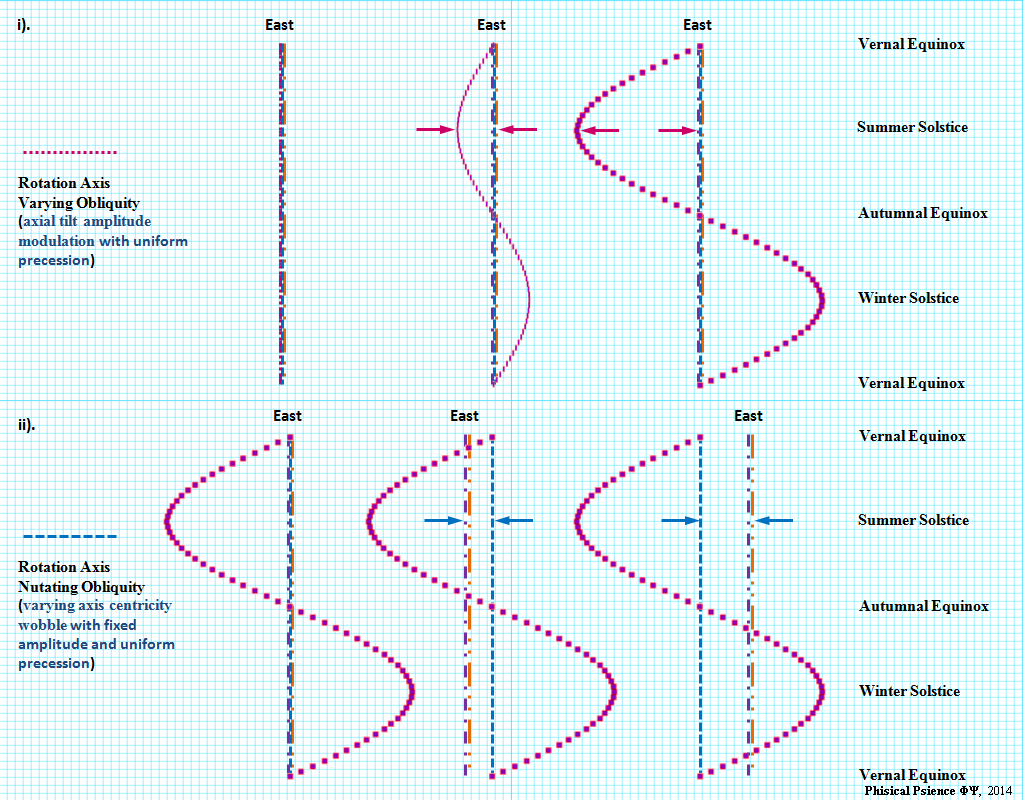
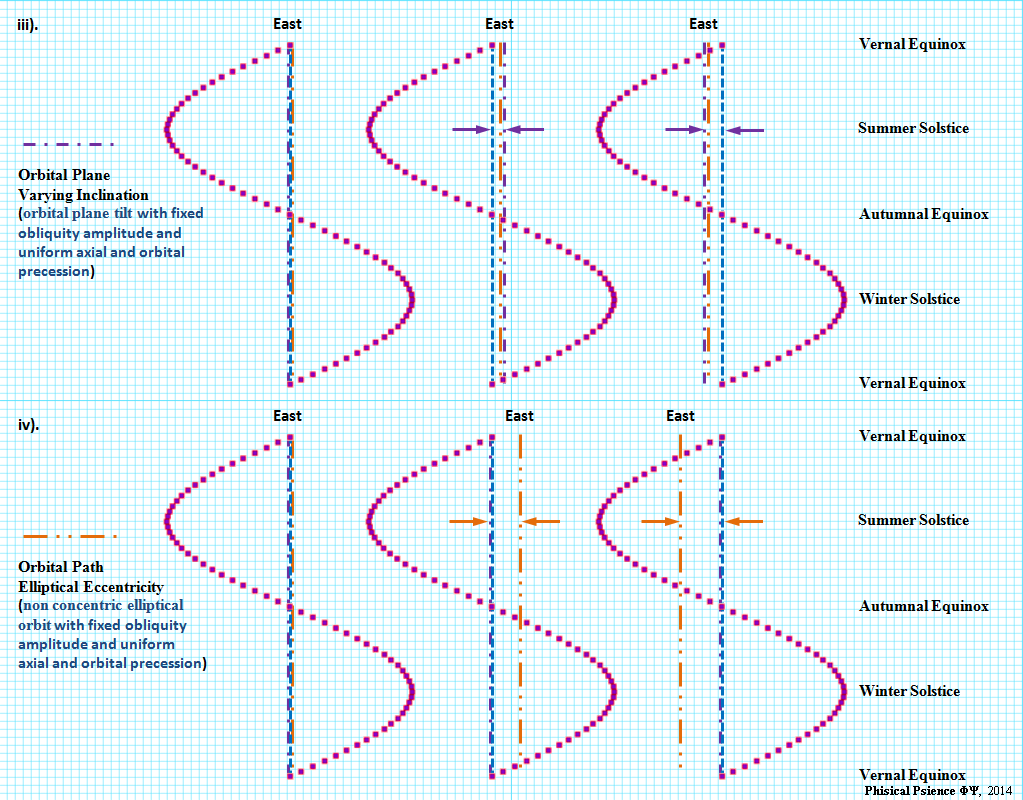
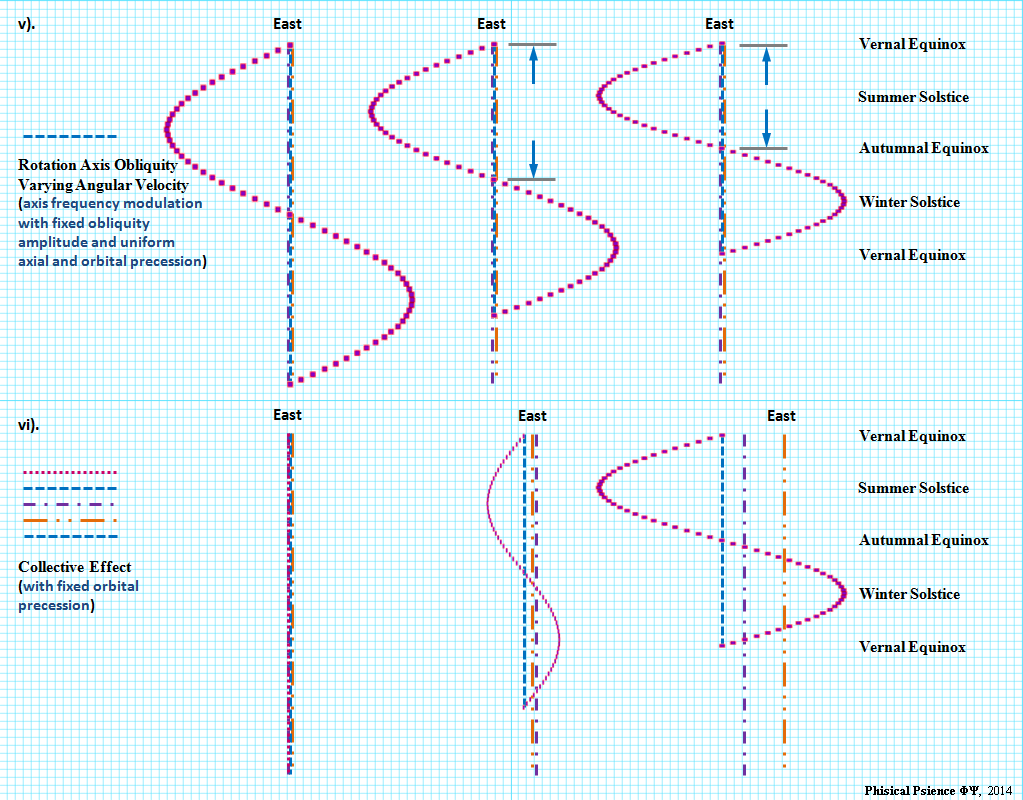
 [xxx] [xxx]
(Fig. xx) .... (xxxx, xxxx).[xxx]
|
The vertical pillars themselves, for obtaining measurements of the rising Sun using an incline shadow gnomon, not needing the additional complexity of being placed in radially arcing arrangement. The task of timing sunrise events being just as sufficiently performed with the pillars placed along a linear path, much like that seen with the thirteen towers that compose the ca. 4th BCE, 300 m (984' ft) long, recognized Chankillo solar observatory, UNESCO (Case Study 3.3)[131] located on the Casma-Sechin Oasis in the Casma Province of Ancash Department, Peru (Ghezzi, Ruggles, and Blandford, 2008)[132] (Figs. xx - xx).
IV) SURVEY of METHODOLOGY I
As a comparison, this author remaining yet convinced as to the claimed primary solar functions of the Chankillo site. There being to date, very limited studies shared as to how the facilities discreet building structures aided in the performing of astrometric tasks. In addition, the existence of numerous non resolved fundamental inconsistencies of an elemental nature, relative to the facility's general design and site plan, in particular, the uniform distribution and architectural nature of the typical 13 huacas, (shrines)(Malville, 2010)[133] (aperture mask) towers themselves, resulting in a total of 12 or 14 viewing line of sights. The driving social and or engineering motivations for the many spatial arrangements of a non contributing nature inherent to the Chankillo complex, needing to be more sufficiently determined. The various design impediments at the site appearing contradictory, given the benefit of a minimum and uniform level of technological understanding necessary to perform naked eye geometric optics in association with an astronomical facility conceived of for timing horizon events, and separate discussion.
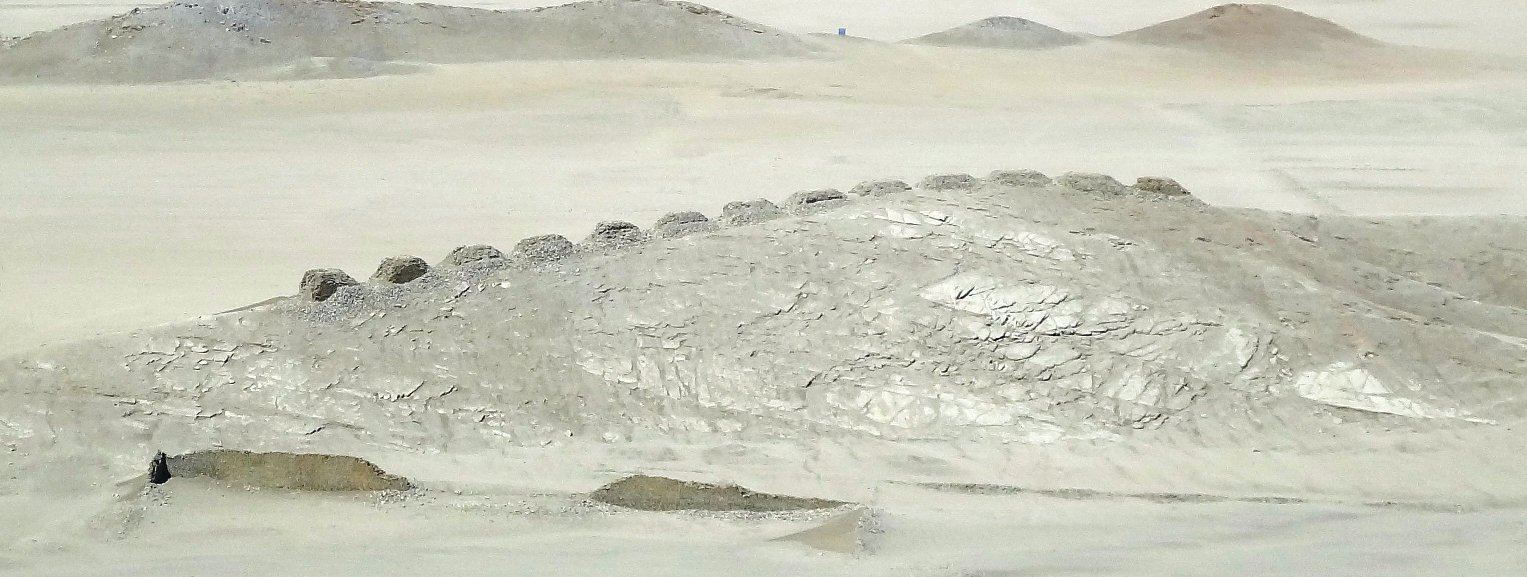 [xx] [xx]
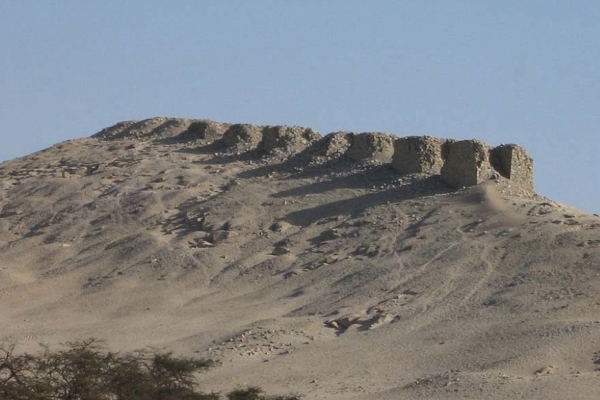 [xxx] [xxx] 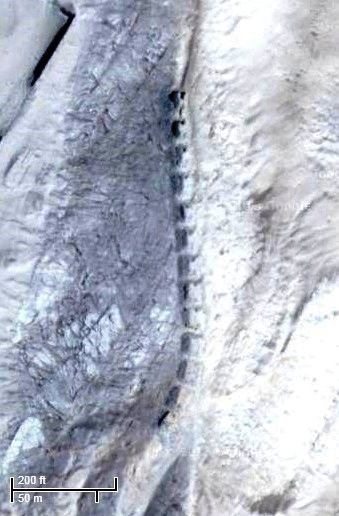 [xxx] [xxx]
(Fig. xx, upper) Front view photo of Chankillo solar observatory complex on the Casma-Sechin Oasis, Peru with its thirteen huacas structures as seen from the fortress (Edgar, 2013)[137] located approximately 1.1 km distant to the northwest (Google Map, 2013).[138] The length of the Chankillo aperture mask array being approximately 300 m (984' ft) in length, roughly orientated north to south, with north being to the left (xx, xx). [139] (Fig. xx, lower left) Rear quarter view photo of huacas structures (Aranibar, 2010). The north structure being closest.[140] (Fig. 22, lower right) Color and contrast enhanced aerial photo of the Chankillo observatory aperture mask array (Google Map, 2013; adapted, McGraw, 2013).[141] The linear nature of the aperture mask being a function of the natural morphology of the geology, the array running along the spine of one of many similar small hill formations in the region. The markers on the scale at bottom left being 200' feet and 50 meters.
|
The Pankenier, Liu and Meis (2008) efforts indicating an inconsistently varying amount of azimuthal bearing error for the full seasonal azimuthal bearing range required. Measurements for sighting E2 (winter solstice) being off from best fit pillar slot by 5.81o degrees or approximately ≈12 solar widths, the Sun's diameter being approximately 0.50o (30' arcmins). The misalignment differential for sighting E7 (spring and fall equinox) being off by 4.27o degrees, the sighting differential for E12 (summer solstice) being off by 1.27o degrees (Pankenier, Liu and Meis, 2008).[142] The angular differential from E2-E7 being 1.54o degrees the differential from E7-E12 being 3.10o degrees, and large value. Compensating for epoch, thus point of Sunrise, not compensating of this large nonlinearly error between the sightings E1-E7-E12, thus not very possible that these azimuthal bearings were used to angularly measure and time horizon events of the Sun.
In perspective, the approximate diameter of the Sun and Moon relative to the circumference of a circle κυκλος (kuklos) measured in degrees μοιπαι (moipai)(Evens, and Berggren, 2006) or ≈ 1:720 of a circle and equal to about 1/2 degree of arc, written (Laertius ca. 3rd c.) to have been known to the Greeks by the ca. 6th c. BCE from Thales of Miletus (Θαλῆς ὁ Μίλητος)(624-547 BCE)(Harley, and Woodward, 1987),[325] (640-546 BCE)(Moulton, 1902, 1914, 1962)[326] or (624-548 BCE)(Aujac, 1987).[327]
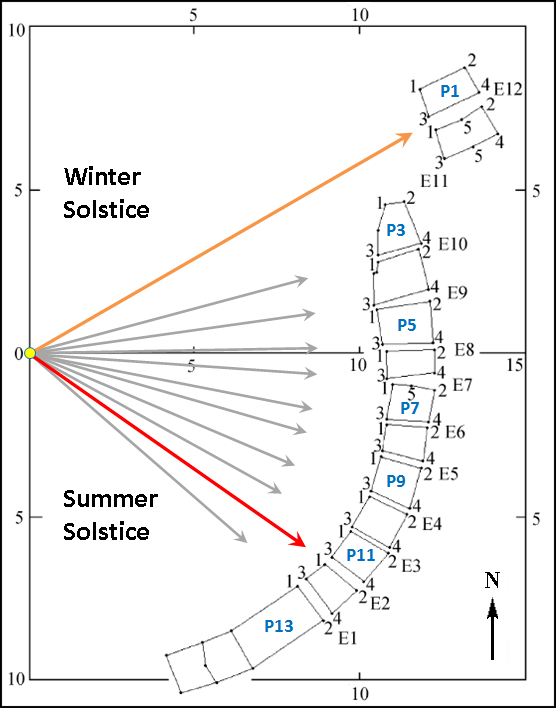 [xxx] [xxx] 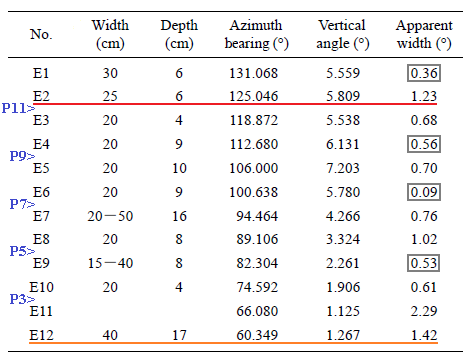 [xxx] [xxx]
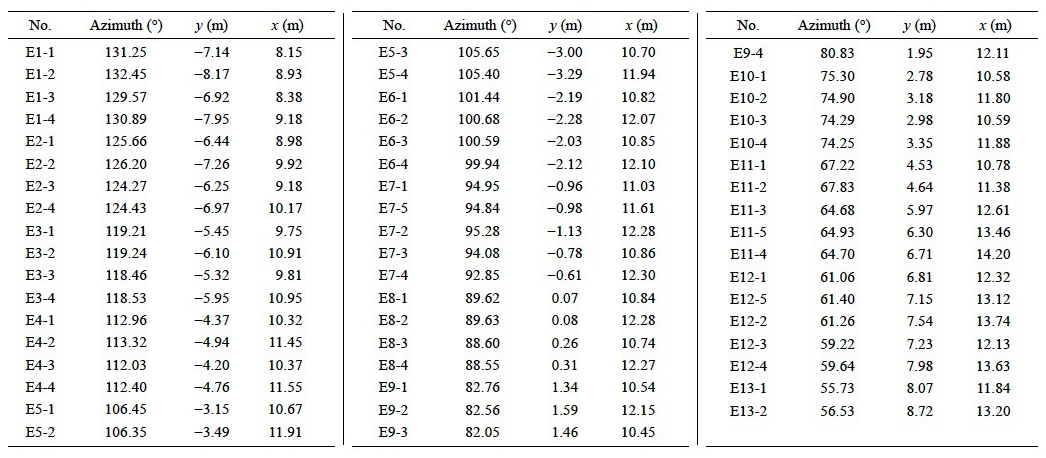 [xxx] [xxx]
(Fig. 23, upper left) Táosi observatory scaled floor plan in meters showing the placement of the sighting pillars (Wu, Chen, and Liu, 2009; adapted, McGraw, 2013),[146] or aperture mask array. This author numbering the pillars starting from the upper right corner, counting clockwise, P1 - P13 (blue). The small yellow marker at left midcenter being the location of the gnomon (biǎo). The grey arrows corresponding to secondary sighting alignments E1, E3-E10. (Tbl. 4, upper right) Táosi Observatory 12 sighting azimuthal angles with pillar locations, sighting elevations, and corresponding field of view (FOV) table (Wu, Chen, and Liu, 2009; adapted, McGraw, 2013).[147] The summer solstice values noted with an orange line, the winter solstice with a red line. The four apertures with minimum width or less than the angular diameter of the Sun noted with a grey rectangle. (Tbl. 5, lower) Complete azimuthal bearing table for each of the pillar's sighting angle field of view (FOV) aperture contacts (Wu, Chen, and Liu, 2009; adapted, McGraw, 2013).[148]
|
The radially arcing collection of vertical and apparently bulky pillars, and associated 11 valid viewing apertures (Figs. xx, xx), the apertures performing the function of a "forward, optical sight, aperture mask" failing to simultaneously capture the correct horizontally level adjusted azimuthal location of the rising Sun on the true horizon or the apparent relative horizon with no elevation compensation, thus timing correction for the gnomon (Wu, 1999-2000)[149] (Fig. xx). The difference in time from the true horizon time to that of the apparent horizon time (Figs. xx, xx) being greater than 20' minutes, and azimuthally dependent.
For successful line of sight (LOS) horizon observations, require an unobstructed and coaxial ray path for LOS path segment 1 (gnomon to pillar aperture) and LOS path segment 2 (pillar aperture to rising Sun), which for the current era are non coaxial path segments. More recent extrapolated locations of the rising Sun position (Tbl. 4), per the site's geographical location, produced by software (Wu, and He, 2005),[150] and epoch compensated to accommodate the understood 26,000 year precession rate of Earth's oblique rotational axis, yet to provide a viable geometrical optical ray path for Táosi, given the presumed sighting limitations of this instrument. Secondary ephemeral verification of the observations and timing performed with the software Starry Night Pro (Wu, 1999, 2000).[151]
Another detractor to operating the Táosi site in the form of a horizon viewing incline gnomon shadow tip instrument, one requiring the integrated use of the pillars as forward sighting aperture masks, being the inflexibilities inherent with such design. The large pillar sighting construction approach preventing easy post assembly translation and or rotation adjustments of their placement, relative to the entire near radially uniform primary pillar segment and general shape. The slot gaps themselves casting shadows and edge diffraction, pillars the being thick in depth, making proper illumination of the gnomon staff very angularly sensitive with respects to the irregular wedge shaped sighting gaps (Figs. xx, xx, xx).
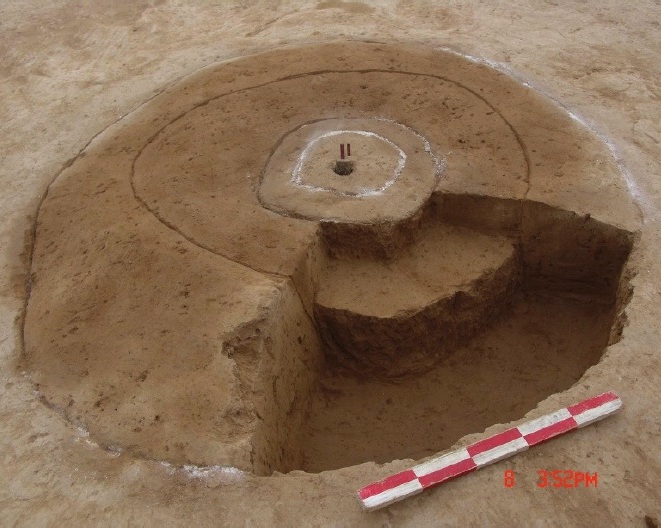 [xxx] [xxx] 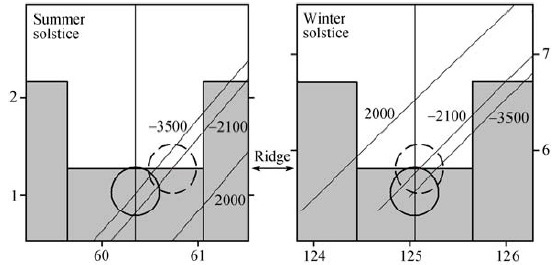 [xxx] [xxx]
_for_pilar_apertures_1-12.jpg) [xxx] [xxx]
(Fig. 24, upper left) Photo of the raised gnomon (biǎo) template and mounting hole for a 180cm (≈71" inch) staff (Xu, and He, 2010).[155] (Fig. 25, upper right) Drawing of the Sun's transit path for the summer solstice (left) for sighting aperture E12 and winter solstice (right) transit path for sighting aperture E2 (Wu, Chen, and Liu, 2009; adapted, McGraw, 2013).[156] The Sun's position for the summer solstice being off in azimuth (pillar obstructed) by ≈3.5 solar diameters for the current epoch, improving some by ca. 3500 BCE though not coincident with the aperture centerline with the Sun placed in contact 1st surface to 1st surface with the apparent horizon (saddle). Determining the centerline of a circle being more difficult to consistently determine compared to determining first or last contact. The Sun at winter solstice ... (Fig. 26, lower) Photo showing the line of sight (LOS) view for apertures 1-12 (right to left) as seen from the gnomon pedestal looking towards the direction of the rising Sun (northeast to southeast). The estimated locations of the solstice sunrises, for both past and current epochs (2000 CE and 2100 BCE) indicated with short black lines (Liu, Liu, and Ma, 2005).[157]
|
The various pillar slot gaps themselves, being of marginal azimuthal angular width for proper biǎo (gnomon) illumination, and critical for correct instrument use to fully illuminate the gnomon with the entire angular width of the Sun's diameter, ≈0.5o degrees. The basic field of view (FOV) requirement being that the width of each of the pillar gap (aperture mask) needs to be greater in angular width than the apparent angular width of the Sun. A proper aperture mask design erring on the side of the gaps being slightly wider in angular FOV than necessary as appose to being too narrow in FOV. Else, the tip of the gnomon shadow will appear not to move in angular space as the Sun transits across the width of the pillar gap, resulting in erroneous timings. The pillar slot width for sighting E1, having an angular FOV of only 0.36o (Pankenier, Liu and Meis, 2008)[158], being smaller than the angular width of the Sun. Sighting E7 at 0.76o (Pankenier, Liu and Meis, 2008)[159] (Tbl. 4) being just larger than the Sun's width. The Sun needing to fully illuminate the gnomon void of highly diffracted light produced by aperture edge induced diffraction setting the minimum practical field of view requirement to 1.5o degrees. The value of 1.5o degrees being the width of the solar disk, plus edge diffraction clearance, in addition to providing a reasonable zero power working width for determining the moment the Sun transits the aperture gap vertical centerline. Any induced rotation errors with pillar placement reducing the angular dimension of the gap even further.
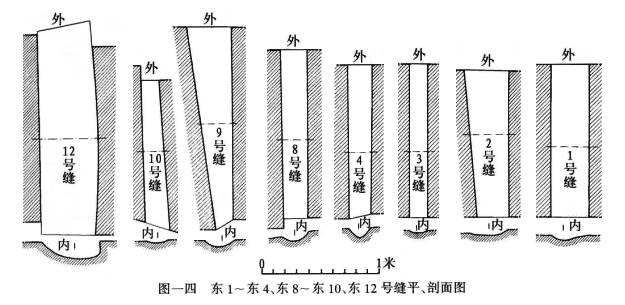 [xxx] [xxx]
(Fig. 27) Scaled overhead illustration in meters of the Táosi pillar aperture openings (footprint), starting from left, E12, E10-E8, and E4-E1 along with a respective representation at bottom of the morphology for the apparent horizon (xxxx, xxxx; adapted, McGraw, 2013).[161]
|
The current difference in ecliptic declination angle (ΔeDec.) between the spring and fall equinoxes of ≈1.25o degrees (+0.75o, -0.50o)(Fig. xx) converting into an azimuthal angular range on the horizon between the two seasonal nodes of ≈1.1o degrees. A complementary angular value of ≈0.5o degrees needing to be added to the angular width (field of view) of the sighting aperture so as to avoid visual clipping of the Sun's diameter. This additional angular consideration dictating that the FOV for the aperture gap used to determine the location of the sunrise during the two equinoxes, needing to be at minimum ≈2.1o degrees in width. The slot width value of ≈2.1o degrees incorporating an additional solar width of 0.5o degrees to help mitigate edge diffraction effects produced by the pillar's vertical aperture hard stops, thus helping to alleviate adverse, non plane wave illumination of the gnomon.
The closest sighting aperture to the two equinoxes being sighting angle E7, at just 0.76o degrees in width, (xxxx, xxxx)[162] (Tbl. 4) and approximately 1/3 the minimum required FOV for the aperture of ≈2.1o degrees, the pillars forming the gap, P6 and P7, bounded by pillars P5 and P8 and their associated aperture openings E9, E8, E6 and E5 (Fig. xx), to preserve the series of adjacent apertures, not having the necessary azimuthal bearing translation space to accommodate a wider FOV for sighting E7. This sighting complication raising questions as to if the aperture mask opening E7 was by design, ever intended to illuminate a gnomon during an equinox, nonetheless capable of gnomon illumination for both equinox events.
From the position of the gnomon to the closest pillar, P6 at 10.8 m in addition to the requirement of a minimum working angle field of view of 2.1o degrees for the spring and fall equinox stipulating that the rear (anterior) aperture of the pillar gap needs to be ~0.40 m (1.31' ft) in width, the front (exterior) aperture, given the typical depth of 1.5 m per pillar setting the minimum width of 0.45 m (1.48' ft). The typical minimum field of view for simply properly illuminating the gnomon using pillars with radial placement distances of 10.8 meters requiring an interior clear aperture width of 0.28 m (0.92' ft) and exterior clear aperture of 0.32 m (1.05' ft) or greater. The final aperture width requirement being a tangent function of the radial distance to the gnomon and the required angular field of view of 1.5o degrees. The only pillar gap openings (Fig. 24) with the necessary minimum clear aperture being E12, E11 and E1.
_Solar_Shadow_Path_Locations-2-c2.png) [163], [164] [163], [164]
(Fig. 25) Aerial photo (right insert) of Táosi Observatory (Xu, and He, 2010; adapted, McGraw, 2013) with an overlaying 10.8 m (35.4' ft) reference line (light blue), gnomon shadow paths E2-E12 (blue) produced from numerical data (upper left) collected by Wu, Chen, and Liu (2009)[165] in addition to representing the minimum required extended area necessary to fully enclose all of the gnomon shadow tip landings upon a common and uniform level surface. The majority of the shadow end point locations, even without taking into consideration the downward terracing of the Táosi site floor plan, the terracing spanning diagonally 45o degrees from the northeast to southwest (inserts left center), greatly exceeding the observatory's rammed floor area and perimeter reaching ≈54.1 m (≈177' ft), ≈91.7 m (≈300' ft) and 81.2 m (≈266' ft) for sighting locations E10, E11 and E12 (Wu, Chen, and Liu, 2009),[166] thus impractical path length dimensions. Given the observatory's physical need to utilize such protracted shadow path lengths do to inherent sighting angle elevation restrictions, nonetheless integrate the use of a biǎo 1.8 m (5.9' ft) in height (He, 2009),[167], strongly indicating the possibility that the various pillar aperture gaps many not have been used in combination with an incline shadow gnomon for timing and measuring sunrise events, irrespective of season.
|
Instrument sighting difficulties further aggravated by the requirement to view over the elevation of the Chong Mountains (Táer Mountain) being only 4-7 miles (≈6.5-11 km) to the west,[168] reaching heights of 1,493 m (≈4,900' ft).[169] Regardless, the Táosi site, with apparent raised pedestal with gnomon staff hole (Fig. xx) and complementary discovery of a gnomon staff pressing the continued indication that this location was at one time a viable solar instrument complex.
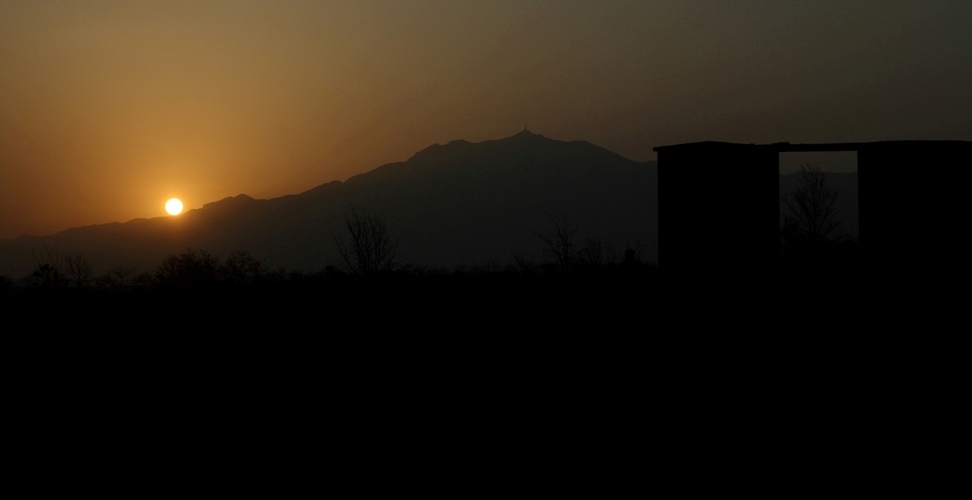 [170] [170]
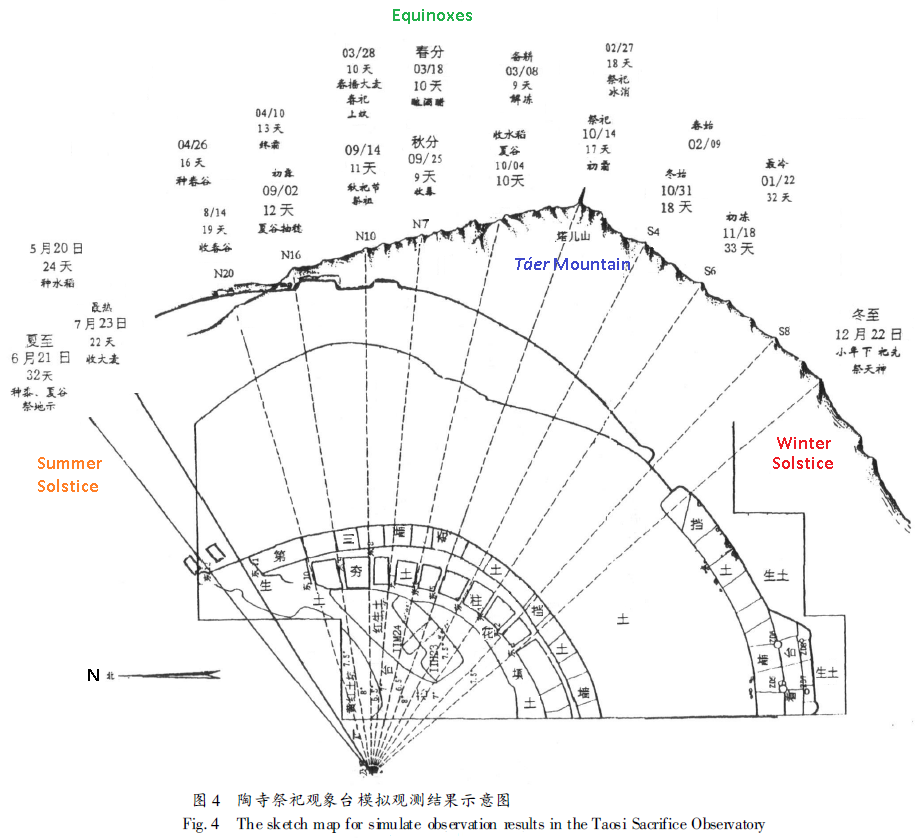 [171] [171]
(Fig. 26, upper) Photo of the sunrise and 1,493 m (≈4,900' ft) Táer Mountain as scene from adjacent to Táosi observatory (Cui, 2009) on the vernal equinox (spring).[xxx] The pillars P1-P4 of the brick reconstruction model silhouetted at right. The azimuth bearing of the Sun corresponding to position N7 in the illustration below. (Fig. 27, lower) Illustration of the Sun's double pass transit dates from summer to winter solstice, along the elevated, apparent eastern horizon, as a function of pillar gap line of sight with respects to Táer Mountain (xxxx, xxxx; adapted, McGraw, 2013).[173] Interesting to note, is that Táosi observatory is referred to as a jìsì (祭祀), or sacrificial alter and place for divination practices, rather than yízhǐ (遗址), or ruin.
|
Secondary examination of the Cartesian data collected for the Táosi aperture array and relative gnomon placement (xxxx, xxxx, xxxx; xxxx, xxxx, xxxx, xxxx; xxxx, xxxx, xxxx) [174], [xxx], [xxx] bringing to light numerous concerns relative to the collective accuracy of the published measured values and associated scaled drawing, relative to what appear to be low distortion aerial photographs of the Táosi site (Figs. xx, xx). The differential in cartographic data collected by direct measurements of what appear to be low spatial distortion aerial photos, compared to direct measurements collected from intended scaled drawings of the Táosi site, these drawing shared in this discussion, many of the drawings incorporated into peer publications, resulting in sustentative azimuthal line of sight (LOS) alterations that on the whole, are incapable of being duplicated in a one to one overlaying superposition manner of the Táosi observatory aerial photos.
 [175] [175]  [176] [176]  [177] [177]
(Fig. xx, left) ...(xxxx, xxxx).[178]
(Fig. xx, center) ...(xxxx, xxxx).[179]
(Fig. xx, right) ...(McGraw, 2013).
|
The multitude of instrumentation and site implementation difficulties associated with attempting to utilize the Táosi astronomical facility as an incline shadow gnomon device, appearing to be peculiar and inconstant relative to the highly contradictory residual design signatures of a far more sophisticated nature. The subtle design attributes being far in excess of the elemental core intellectual requirements necessary to benefit from an incline shadow gnomon device. The Táosi complex projecting a much deeper understand of moving celestial bodies. The Longshan culture, during the Middle Táosi period from the time of the Yellow Emperor, Huáng Dì (皇帝)[180](2697-2597, or 2696-2598 BCE) understood to already be in possession of long duration, multiple generations worth of accumulated astrometric knowledge and data pertaining to the observable motion of the Sun in addition to the precise location of the various seasonal nodes, this granular knowledge ultimately incorporated into a high level of technical proficiency and presented at Táosi observatory.
V) METHODOLOGY II
To mitigate the wide variety of complications associated with current proposed means of usage for the Táosi solar instrument, suggest that the Táosi observatory was not designed for the intended purpose of being an azimuthally measuring incline shadow tip gnomon instrument (Fig. 20) for collecting measurements of horizon events, premised about a discreet, fixed framed forward line of sighting (LOS) via the use of a fixed position aperture mask array.
In place of the predominate theory, this author proposing that the Táosi observatory's numerous vertical pillars are the structural support columns for a velocity compensated raised bulkhead or wall used to mount a large surface normal optical (shadow) imaging plane. The horizontal shadow produced by the full length gnomon being projected at sunset upon one of two screens. The larger of the two fixed backdrops being the "fast" screen, the small backdrop being the "slow" screen (Fig. 21). Hence the slightly non constant radius placement of the pillars with respects to the position of the gnomon staff, per the observatory floor plan. That the gnomon staff at Táosi observatory was not used as an incline shadow tool such as a rear sighting device for line of sight azimuthal measurements of the Sun on the horizon via narrow fixed pillar openings (aperture masks). Suggesting that the majority of the incline angle style gnomon measurements were primary associated with high elevation angle meridian and culmination measurements.
Though not clearly stated or fully implied in ancient Chinese writings such as the Zhou bi (周髀)[181] the use of a horizontal gnomon and by such means, does not automatically preclude the viable existence of such instrument configuration prior to the writing of such text. The Chinese clearly demonstrating with the invention of silk and compass the ability to harbor state secrets from not only the public, and imperial court, but civil astronomers as well. The development, hence possible example of a horizontal shadow gnomon and natural evolution to the incline shadow gnomon, being possible particular when one considered the great cultural importance solar horizon events were to the Chinese.
With the passing of time, the horizontal gnomon configuration and method, having been possibly lost, superseded or forgotten during dynastic transitions. The proceeding comments, predicated on zero site modification and simple procedures to demonstrate an alternative means of instrument uses.
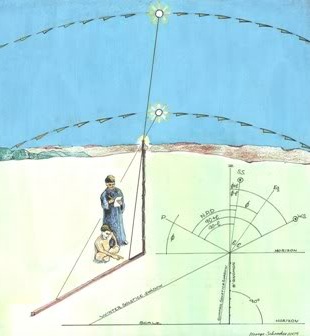 [182] [182] 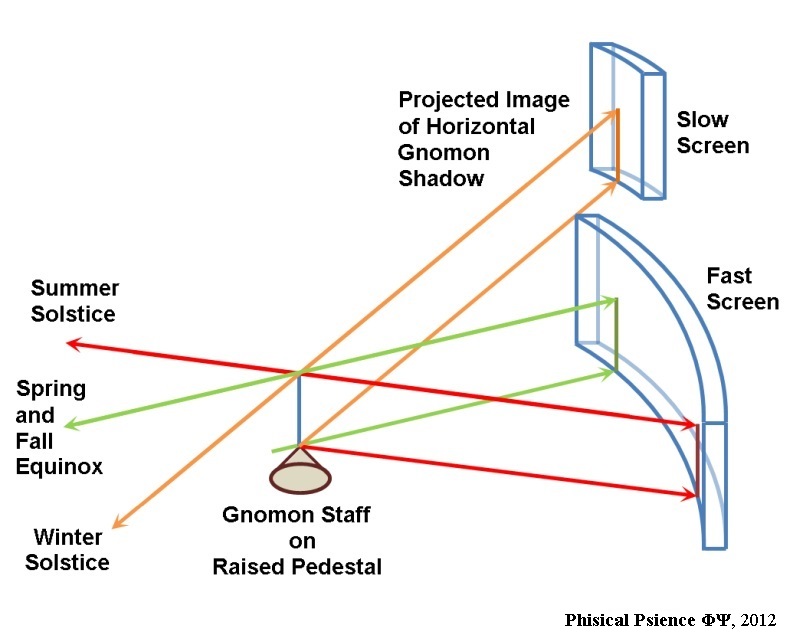
(Fig. 28, left) Drawing representing the solar alignment between the Sun, vertical gnomon staff, and resulting gnomon staff shadow (xx, xx).[183] This method of shadow tip ground measurements being idea for midday position readings of the Sun, but far from idea when attempting to measure the position of the Sun on the horizon to note the exact rising and or setting location and or angular bearing. (Fig. 29, right) Rendering of the Táosi solar observatory with proposed shadow ray paths along with the location of the projected horizontal image of the gnomon staff shadow for both the summer and winter solstices along with the median location for the two equinoxes spring and fall (McGraw, 2013). The slight elevating of the gnomon pedestal base assisting with the sighting of the bottom of the gnomon staff, adding in the final verification of when the cast shadow is perfectly horizontal with the ground and exact moment of measurement. This solar configuration entirely removing the sunrise and sunset measurement obstacles associated with the incline gnomon shadow method. The apparent horizontal translation velocity of the Sun's position along the horizon as a function of season, being compensated for with the use of a "fast" and "slow" screen. The slow (winter) screen being positioned at a greater distance from the gnomon staff so as to provide a (r)cosθ increase[184] in the horizontal resolution (precision) of the instrument.
|
Increasing the horizontal shadow path lengths for pillars 12 and 13 (Figs. 15, 34) aiding with the measuring of the Suns azimuthal position during the most difficult season of the year, that being winter. The increased path length traveled by the low shadow each day, slightly increasing the horizontal distance of the gnomon shadow path as the Sun moves relative with the Earth, the Sun drifting retrograde along the ecliptic path. The visual result being an artificial increase in the azimuthal distance traveled each day, or arc path length, by the gnomon shadow tip. The height of the horizontally projected gnomon shadow, being non finite in vertical dimension resulting in a very slowing diverging thus increasing shadow image height as a function of increasing distance from the gnomon, nearly uniform for each screen, negligible between the slow and fast screens, when combined with a horizontal method of measurement, of little relevance.
Shadow tip location ambiguities produced from a thin vertical gnomon, because of inherent optical diffraction and divergence of the projected shadow image upon a background surface, as a function of increasing shadow path length between the gnomon staff and pillars P12 and P13 being negligible for such short distances. The shadow tip location ambiguities produced from a low (≈7.77:1)(path length:gnomon height) ratio surface normal shadow image being orders of magnitude less than the shadow location ambiguities produced from a long path length, low incident angle (elevation-1) incline shadow image projected (incident) upon a non surface normal common level surface (Figs. 19).
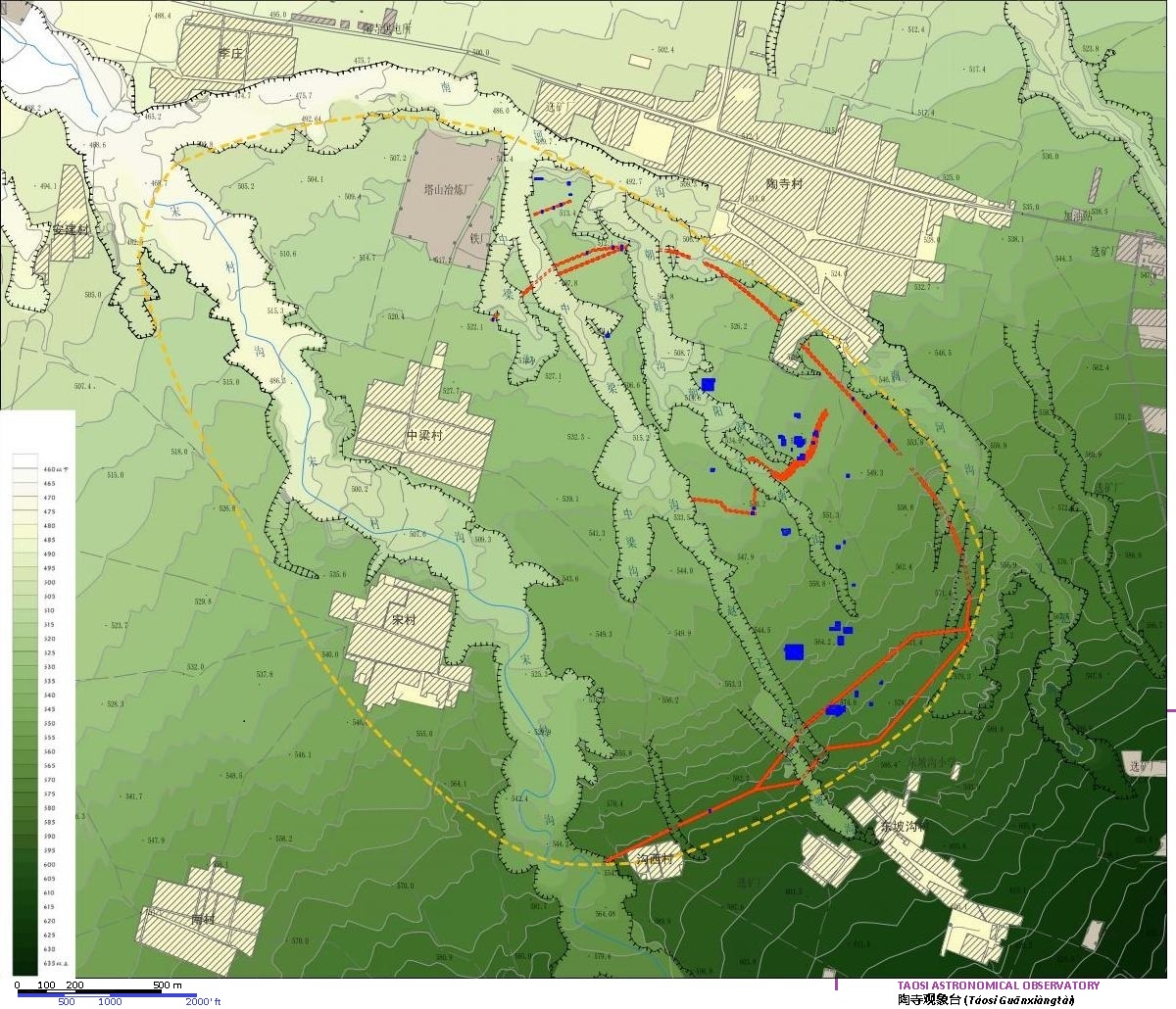 [185] [185]
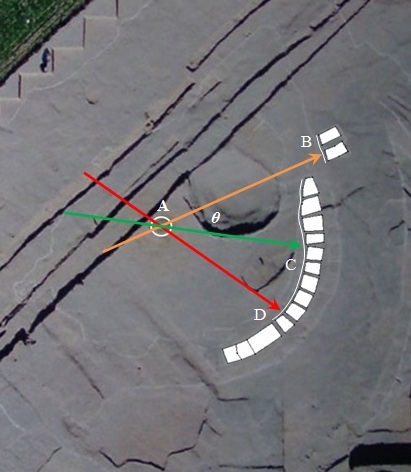 [186, 187] [186, 187] 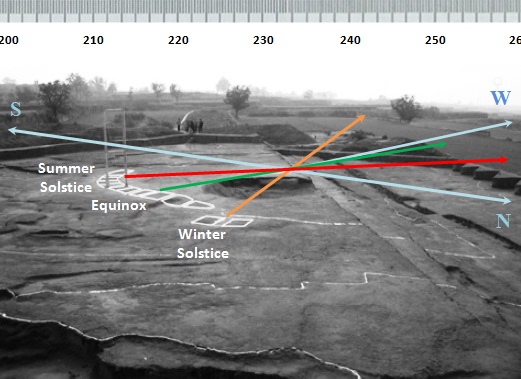 [188] [188]
(Fig. xx, upper) Shaded topographic survey map of the Táosi area (中国建筑设计研究院建筑历史研究所的歷史, China Architecture Design and Research Group Institute of Architectural History, 2013; adapted, McGraw, 2013) with the site location of the solar observatory (small blue plot) noted with perimeter hash marks (purple).[189] (Fig. 30, lower left) Aerial photo of the Táosi Solar Observatory (Xu, and He, 2010)[190] with overlay (white blocks) of the pillars (Wu, 2009)[191] and approximate shadow projection paths (arrows) formed by the gnomon (A) for the winter solstice line [AB], the median azimuth bearing for spring and fall equinox line [AC], and summer solstice line [AD](Xu, and He, 2010; adapted, McGraw, 2012).[192] The horizon location for the spring and fall equinox nodes, not falling precisely onto each other's position, being slightly displaced from the ecliptic in declination by approximately ≈1.25o (+0.75o, -0.50o)(epoch 2013) or ≈1.1o degree in azimuthal bearing range do to Earth's orbital acceleration and deceleration properties (Fig. 31). The precise ephemeral value of these two equinox nodes being different for when the Taosi observatory was in use, the seasonal nodes having translated azimuthally along the horizon from their current locations, the angular displacement in declination with respects to the ecliptic path being minimally effected as the obliquity angle of Earth's rotational axis changes slightly in value with time. The small "slow" projection screen, as a means to compensate for the slower right ascension (R.A.) translation velocity of the Sun's position along the ecliptic being placed farther from the gnomon staff compared to the larger "fast" screen. (Fig. 32, lower right) Photo of the Táosi Solar Observatory looking in the direction of the winter solstice (orange arrow), with a compass bearing of ≈245o degrees (Wu, Chen, and Liu, 2009; adapted, McGraw 2013).[193] The physical horizon to the east of the observatory, with slight negative grade, unlike that towards the west and slightly out of frame being free of any natural interferences to hinder views of the setting Sun, the clear line of sight spanning from winter to summer solstice (red arrow). The nature of the observatory platform, itself appearing to step downwards towards the east, thus by architectural design, adding in the projection of the horizontal shadow of the gnomon during sunset. The arrow representing the two equinoxes (green) is the median azimuth bearing direction.
|
By using the relatively flat and level western horizon view for obtaining measurements of the setting Sun, a horizon with a vanishing point of near equal distance for the entire azimuthal bearing range of the Sun yielding a high finesse timing reference for determining horizon events for any arbitrary day of the year, as appose to attempting to obtain location values of the rising Sun to the east (Figs. 22 - 23). The view of the rising Sun from Táosi, spanning northeast to southeast, being not level with an irregular profile, the profile varying in elevation angle as a function of azimuthal bearing angle, generating non uniform timing data. This undesirable sighting complication being the product of the Chong Mountains (Taer Hill) 4-7 miles (≈6.5-11 km) from Taosi observatory. These timing related difficulties circumvent able by making measurements of the more optimally placed setting Sun to the western horizon.
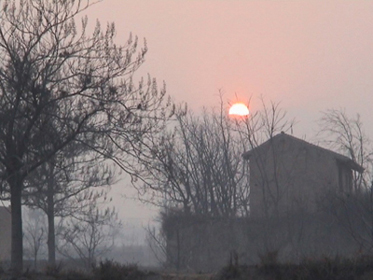 [194] [194] 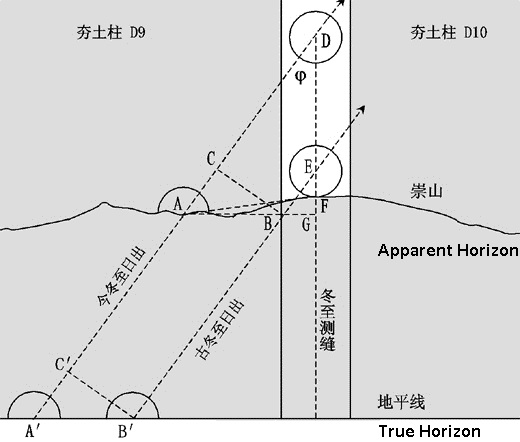 [195] [195]
(Fig. 33, left) Photo (Plate 5) of the half sunrise on Dec. 22, 2003 (He, and Wu, 2005).[196] Note how the Sun does not rise on the true horizon and vanishing point, being obstructed with a mountain in the line of sight. The mountain negatively affecting the directly measured solar values, thus ultimately failing to obtain the precise location and time of a true sunrise, being limited to viewing only apparent sunrise events, and little different than waiting for the Sun to rise and appear from behind a small building. As such, reducing the direct measurement accuracy of the Táosi instrument, ultimately having to result to extrapolated sunrise values, incorporating a multitude of errors. (Fig. 34, right) Diagram showing the Sun's current angled, (φ), transit pass, (A'), with respects to the winter solstice pillar gap (aperture) E2 in addition to a differential path, (B'), that is compensated to correspond with the elevation of an apparent horizon sunrise, transit pass of the pillar gap. The vertical elevation differential between the true and apparent horizons resulting in a southward horizontal shift of the midwinter sunrise location relative to the zero elevation (true horizon) sunrise time (He, and Wu, 2005; adapted, McGraw, 2013).[197] The winter solstice Sun requiring slightly more than 20 minutes from the time of apparent half sunrise to being coincident with the pillar gap (aperture) center line [DE]. The noted pillars in the diagram, D9 and D10 (shaded areas), per this study, corresponding to pillars, P11 and P12.
|
The atmosphere becoming more dense and in an increasingly non linear manner the closer one gets to the true horizon or vanishing point, resulting in a slight corresponding non linear increase in the optical index of refraction value (n) for the atmosphere, in addition to increasing path length in the atmosphere, less turbulence induced effects, resulting in observable path distortion[198] (Fig. 26).
Observations from Táosi observatory collected from the western horizon (sunset), and horizon view with nearly uniform vanishing point thus near zero elevation angle differential from winter solstice to summer solstice nodes, greatly reducing sighting and timing errors caused from inconsistent index of refraction values in atmosphere.
Observations facing the eastern horizon (sunrise)(Fig. 26), in a non uniform manner, varying in elevation angle from 5.81o degrees along sighting location E2, 125.06o degrees azimuth, to 1.47o at location E12, 60.35o degrees azimuth (Pankenier, Liu, and Meis, 2008),[199] hence a function of azimuthal bearing angle. (Fig. 27, Tbl. 6) Forcing the observer to view through atmosphere of changing density, affecting the index of refraction in a gradient (GRIN) manner along the varying sighting path length through the atmosphere.
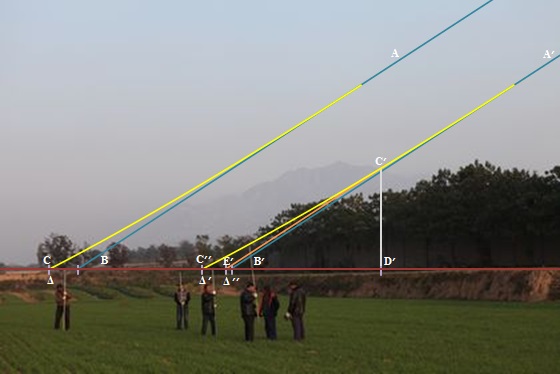 [200] [200] 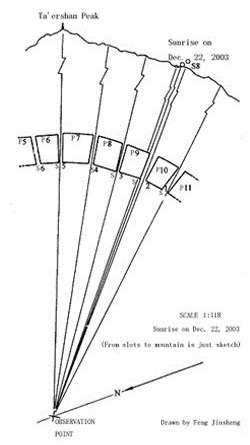 [201] [201]
 [202] [202]
(Fig. 35, upper left) Photo of Táosi rammed earth city 10YJ54 (xxxx, xxxx; adapted, McGraw, 2013) adjacent to excavation IIFJT1 the solar observatory looking northeast with the Chong Mountains (Táer Mountain) in the background with overlaid refraction paths for the sunrise (xxxx, xxxx).[203] The altitude of the mountains in the background resulting in true sunrise timing errors by introducing a false, elevated apparent horizon. The linear path [BA](blue) representing the correct path of the Sun from a clear (true) horizon (dark red). The path [CA](yellow) representing an accentuated atmosphere refracted path, and what is visible to the observer. The azimuthal bearing differential [BC] or path difference (Δ), for the most constant thus accurate measurements possible, remaining as level and void of an incline as possible for the entire horizontal bearing range of the seasonal nodes, the single greatest contributor to such uniform results being the minimizing of the sighting elevation angle relative to the true horizon. The path [C'A'](yellow) being the observed sunrise from an elevated apparent horizon. The vertical line [C'D'](grey) representing a simple azimuth bearing value for the rising Sun and first order differential error value of (Δ'). A linear line [C'E'](orange) drawn normal with true horizon introducing a second order differential azimuth bearing error [E'C''] or path difference (Δ'') having not been compensated for a gradient refractive index (GRIN) as a function of sighting elevation. The sum of the path errors do to an elevated apparent horizon at sunrise not plausibly acceptable given the general degree of accuracy required for such measurements to be of precise calendrical value. Modern day air pollution magnifying the visual difference in air density as a function of elevation angle with the horizon (altitude). (Fig. 36, upper right) Diagram representing the variations in the elevation of the horizon, looking towards the east, as a function of horizon azimuthal bearing angle as seen and measured on 22 Dec 2003 (Feng, 2003).[204] (Tbl. 6, lower) Táosi, atmospheric refraction table as a function of azimuthal bearing with associated vertical angle (elevation value)(Wu, Chen, and Liu, 2009; adapted, McGraw, 2013).[205]
|
Hence, from an index of refraction perspective, sightings from Táosi observatory towards the more level and elevation true western horizon (Fig. 23, 41) at sunset being much more uniform and with fewer induced error values compared to sunrise data collected from the east (Figs. 26, 27, Tbl. 6).
The almost uniform radial nature of the concave pillar placements (Fig. 35), should they be used as a backing for a large projection screen, the pillars being arranged in a spherical nature, resulting in a near uniform gnomon shadow projection height at sunset across the face of the pillars. The inward curved spherical imaging screen generating more accurate event timing data compared to a linear screen placed horizontally orthogonal with the equinox and horizon. The curved arrangement of the pillars only complicating the construction and placement of a forward sighting aperture masks, in addition to offering no additional benefit to an incline shadow gnomon.
VI) ANALYSIS
The level of technical proficiency necessary to design a gnomon observatory which incorporates the use of a velocity compensating fast and slow projection screens, such as that being proposed by this author for Táosi solar observatory, raising addition questions as to the full depth of Longshan scientific awareness and mathematical skills. For the Táosi facility to have incorporated into its design such level of sophistication providing possible indications as to the culture's prior knowledge of the varying apparent solar time (Zeilik, and Gregory, 1998)[371] through the course of a year via gnomon shadow changes in the angular differential value of maximum shadow length from true meridian noon (local solar noon), from infer the solar analemma (Figs. 28, 30) pattern in the sky or via shadow, and product of the Sun movement along both above and below the ecliptic path during the course of a year. The analemma pattern being an orbital mechanic artifact of Earth's oblique rotational axis, in combination with Earth's elliptical orbit (Fig. 29).
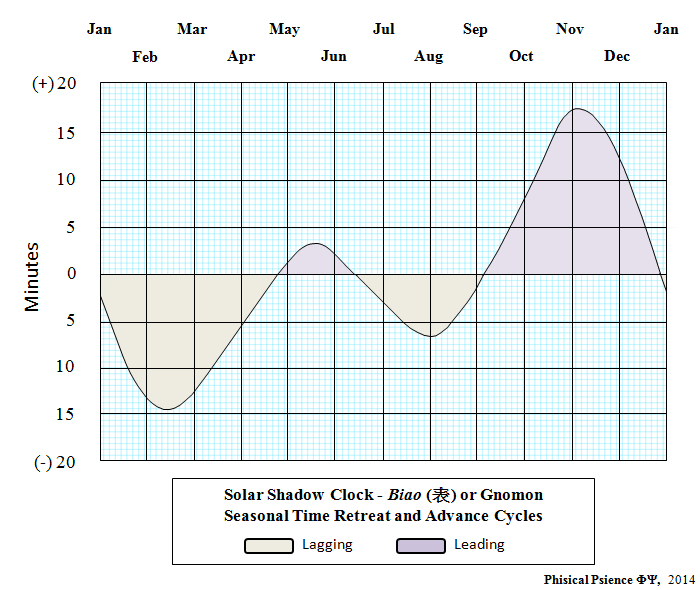 [xxx] [xxx]
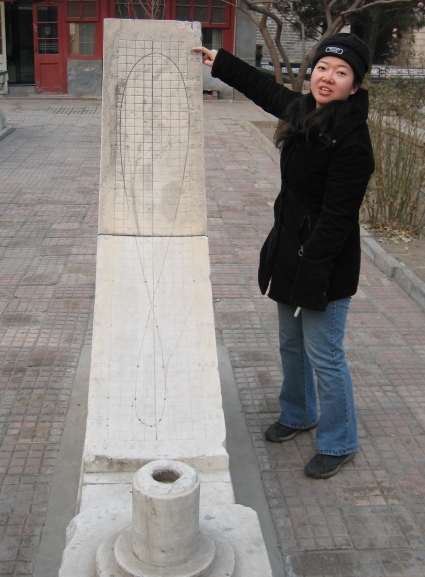
(Fig. xx, left) Diagram showing the yearly advance and lag time cycles (McGraw, 2014), there being two cycle sets each, for a sundial clock in minutes (Barnett, 1998).[xxx] (Fig. xx, right) Photo of Ming Chao, (xx xx)[206](Ming Dynasty), (Zhang, and Fan, 2003)[207] biǎo (gnomon) with inscribed inverted analemma pattern at the Beijing Observatory along with Chinese host Jing Wu (McGraw, 2004). The hollow pedestal at bottom being the mounting location for the shadow casting staff.
|
The Chinese, not yet openly addressing the subject of the analemma till perhaps the Han Dynasty. The Chinese having an example of a gnomon device with engraved analemma pattern superimposed upon the solar noon time grid, the analemma being inverted top to bottom, being the product of the gnomon's projected tip, on display at the Beijing Observatory (Fig. 28).
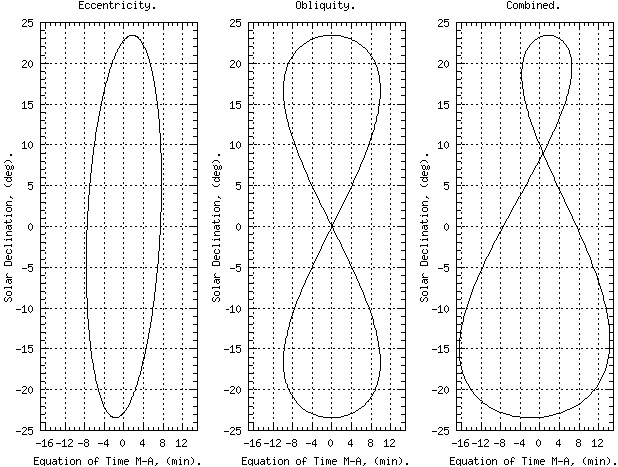 [208] [208] 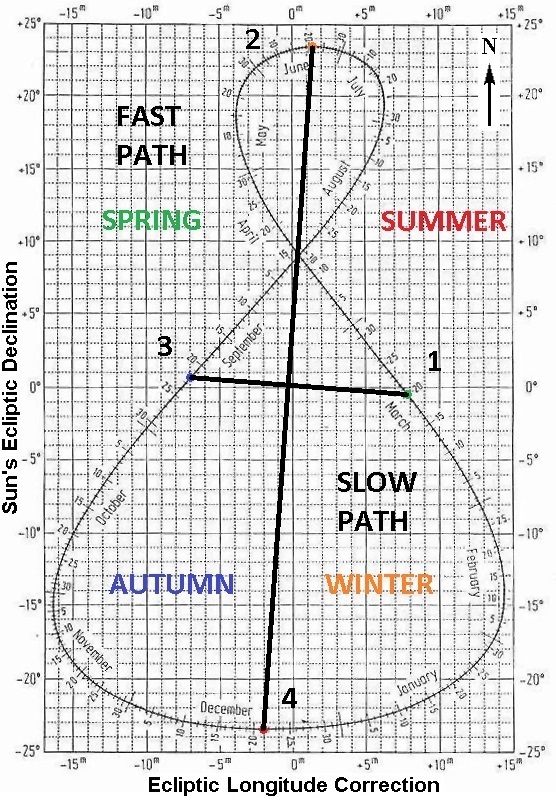 [209] [209]
(Fig. 38, left) Drawing representing the orbital composition of the Sun's analemma path in the sky (xx, xx).[210] The elliptical nature of Earth's orbit around the Sun and the non symmetric location of the two acceleration and deceleration inflection points within the orbit (solstice nodes) resulting in asymmetric changes to Earth's angular velocity, inducing a slight clockwise axial rotation (inclination) to the analemma pattern (xxxx, xxxx).[211] (Fig. 39, right) Graphic plot of the Sun's analemma path with respects to the four seasonal nodes (xx, xx; adapted, McGraw, 2013).[212] The slow path in Earth's orbit being centered about (fall - winter) the fast path being centered about (spring - summer). The line path [3, 1] representing the inclination value of Earth's orbital plane about the Sun or ecliptic, the angular differential being measured from the collective, angular momentum generated invariable plane of the solar system (xxxx, xxxx).[213] The non bilaterally symmetric perimeter shape of the analemma path being slighting rotated to the west and skewed in a diagonal, non orthogonal manner.
|
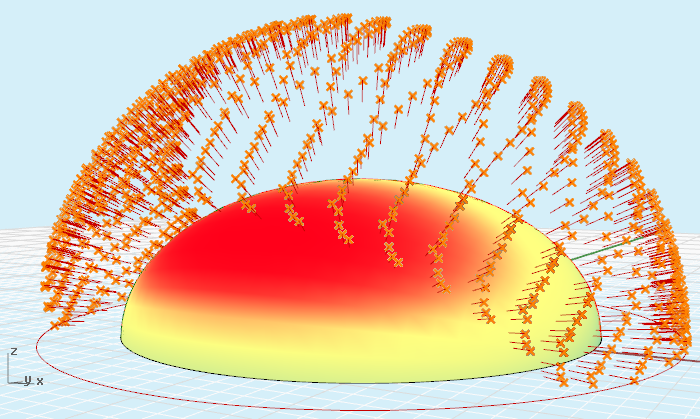 [214] [214] 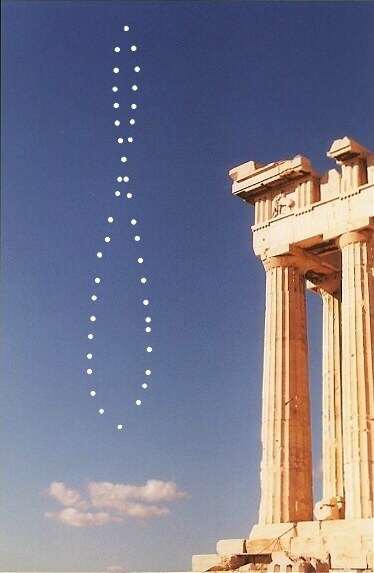 [215] [215]
(Fig. 40, left) Graphic one year plot of the Sun's position and orbital composition of the analemma path across the sky, generated at one hour intervals overhead the Earth (xx, xx).[216] Note how the embedded analemma pattern in the sky is visible over the entire hemisphere for any given moment off time. (Fig. 41, right) One year multi exposure photograph of the Sun's analemma path with one image taken at nearly the same time and day of week for each week of the solar year, with the Acropolis in Athens Greece at right (xx, xx).[217]
|
The distance for the analemma path segment [1 → 2 → 3] being shorter than path [3 → 4 → 1] (Fig. 30) as determined by Kepler's law of orbital mechanicals stating that an arbitrary swept of equal area, (Δ) or areal velocity, produced by an orbiting planet, per unit of equal time is a constant (Petersen, 2008)[218] (Fig. 33).
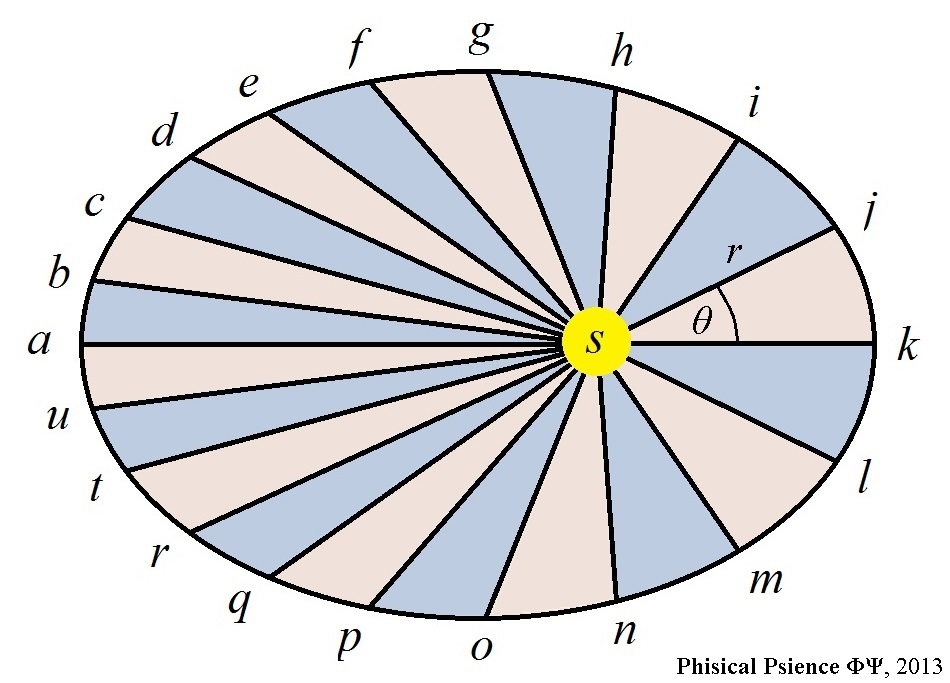
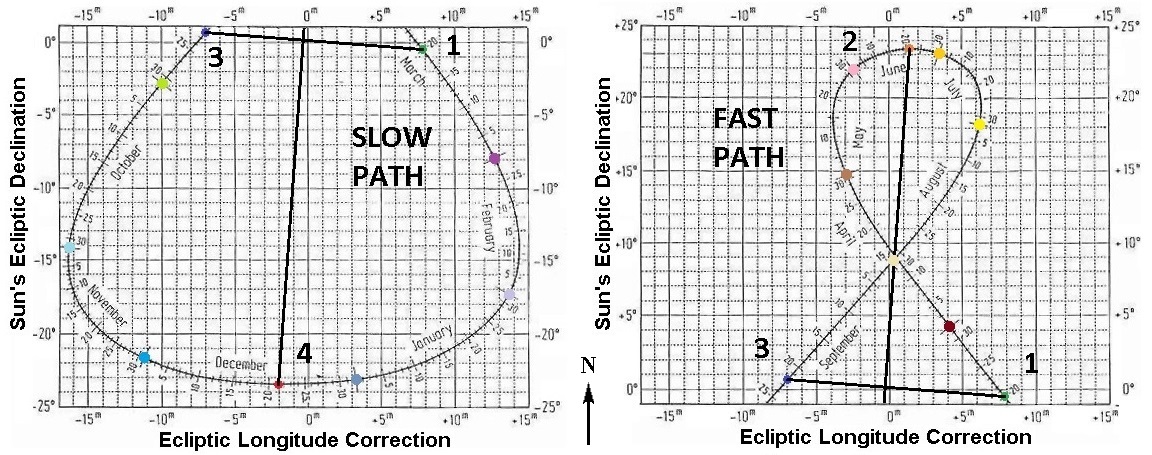 [219] [219]
(Fig. 42, upper) Classical diagram (McGraw, 2012) representing Kepler's second law of planetary motion (Kepler, 1609)[220] where an elliptically orbiting body (accentuated for effect) about the Sun, (s), and "central gravitational force", sweeps out "equal area in equal time".[221] Hence, the triangular area Δ1 [asba] is equal in area to Δ2 [kslk].[222] In addition, the classical Newtonian time (non relativistic) for the orbiting body to travel the arc from points [mn] is the same as that required to travel the arc from points [tu]. Thus the orbiting body accelerates along path [ak] and decelerates along path [ka], and accordingly, increasing in angular velocity along path [ak] and decreasing in angular velocity along path [ka] as the orbiting body completes a revolution about the central gravitational force (Sun)(Landau, and Lifshitz, 1975).[223] The arbitrary equal area interval (Δ) resulting in the inner angle (θ) to change in angular value with time, increasing and decreasing in coincidence with the rate of change in angular velocity of the orbiting body (Earth). (Fig. 43, lower) ... (xxxx, xxxx; adapted, McGraw, 2013). [224]
|
The value of the increase in azimuthal arc path length being = (cosθ)Δr, setting Δr = [line AB] - [line AD] = (rSS - rWS)[225] (Fig. 33) resulting in a horizontal radial velocity, (v), of v = (cosθ)Δrs-1, with the variable, (s) equal to seconds.
The additional difference in horizontal shadow path velocities, (cosθ)Δrs-1 between the fast and slow projections screens compared to Earth's orbital path distance ratio of (≈45:55) (vernal equinox [1] to summer solstice [2] point:autumnal equinox [3] to winter solstice [4] points)(Fig. 30) being proportional (Fig. 34). Given that half of the orbital path length distance between the equinox points [1→3], [3→1] traveled by the Earth is performed with nearly uniform areal (sweep) velocity, or (θ1 = θ2), dictates the same ratio for each of the seasonal node linear path lengths (Fig. 33) of the solar analemma's perimeter path.
VII) Results
Therefore, a transept produced by two intersecting imaginary lines (black) (Fig. 30), a vertical line drawn between nodes 2 and 4 the second line being from nodes 1 and 3, resulting in a equally bisected line that represents the total linear length of the analemma. The value of the two bisected vertical halves, as a function of Kepler's law, representing the time, thus required velocity to travel one half Earth's orbit about the Sun. The two arcing perimeter path lengths, the upper portion of the analemma representing the fast orbit segment the lower portion of the analemma representing the slow segment of Earth's orbit being similar in value to Earth's orbital path distance ratio of (≈45:55)(xx, xx)[226] (Fig. 34). The orbital ratio of (≈45:55), or more precisely (11.05:14.08) to be implemented into the design of Táosi solar observatory (Fig. 35), thus nearly normalizing the azimuthal gnomon shadow velocity differential produced by Earth's elliptical orbit about the Sun.
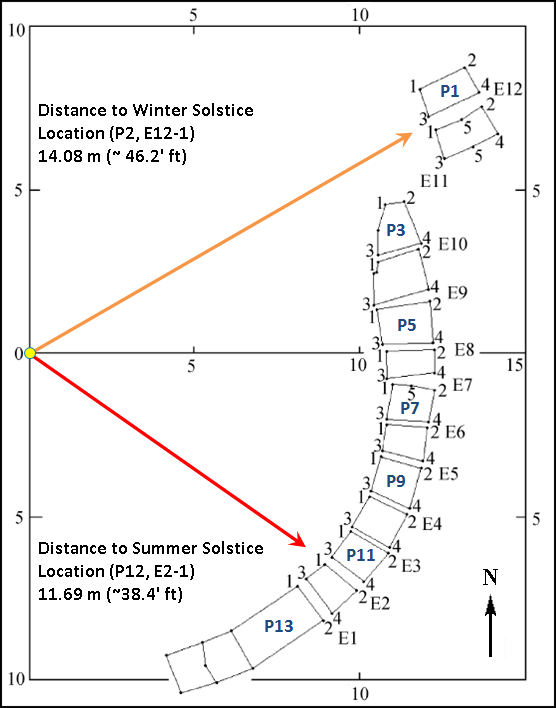 [227] [227] 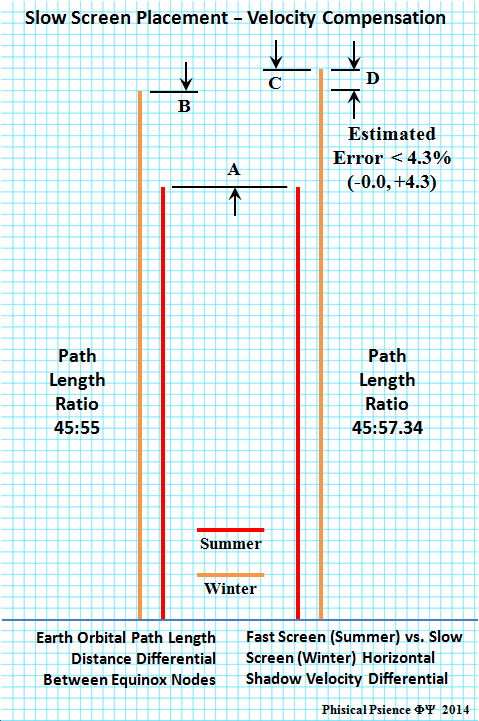
(Fig. 44, left) Sunset ray path diagram starting from the gnomon location for the winter solstice (orange), the gnomon shadow imaging upon the slow screen the summer solstice path (red) imaging upon the fast screen (Wu, 2009; adapted, McGraw, 2013).[228] (Fig. 45, right) Rendering of the slow screen (orange bar) placement velocity compensation error bar (at right) for the winter solstice path compared to the difference in orbital path length distance between Earth's two equinox nodes (McGraw, 2013). The large fast screen (red bar) being the shorter of the two measurement values, established as the reference metric for determining the accuracy of the slow screen placement. The distance misplacement error in the positioning of the slow screen, and interestingly enough the tolerance error being in the preferred direction, that being outward, calculated to be less than < 4.3% in total path length, and considerable degree of accuracy.
|
The Táosi orbital velocity ratio from winter solstice to summer solstice of (11.05:14.08) obtained from values provided in (Tbl. 5) by Wu, Chen, and Liu (2009). The data, though a measurement of the approximate solstice sunrise locations, sufficiently close to the slightly non reciprocating azimuthal bearing location of the solstice sunsets as the full angular translation of the sun's movement at sunset along the horizon being nearly identical to that of sunrise. The azimuth and Cartesian data table, from comparative inspection, being consistent relative to site photos and scaled drawings of Táosi. The Wu, Chen, and Liu (2009) data table providing a summer solstice rise position values for location (P2, E12-1) of (x = 12.32 m), (y = 6.81 m), producing a hypotenuse or radial gnomon shadow path length to the slow screen of 14.08 m (≈46.2' ft). The winter solstice sunrise position values for location (P12, E2-1) being (x = 10.78 m), (y = -4.53 m), resulting in a hypotenuse or radial gnomon shadow path of length to the fast screen of 11.69 m (≈38.4' ft).
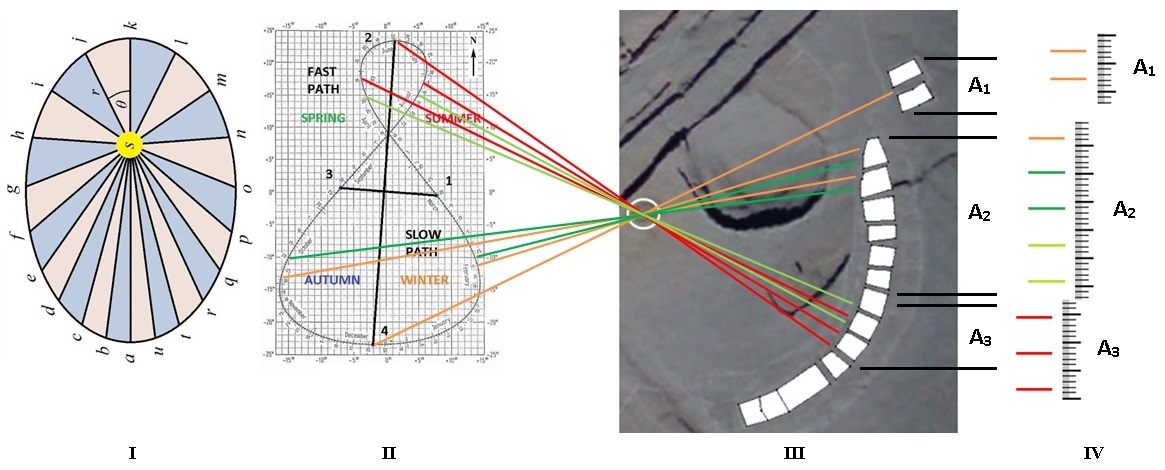
(Fig. 46) ... (xxxx, xxxx; adapted, McGraw, 2013).[229]
|
The observable effect upon a gnomon matched to a velocity compensated slow screen, appearing as uniform daily azimuthal translations of the Sun's shadow movement spanning from summer to winter solstice (Fig. 36). The placement of the velocity compensated slow screen at Táosi having a measured orbital ratio of (11.05:14.08 = 45:57.34), and error value of (-0%, +4.3%) from the required location ratio of (45:55) (Fig. 35), being an impressive accomplishment for a Neolithic culture.
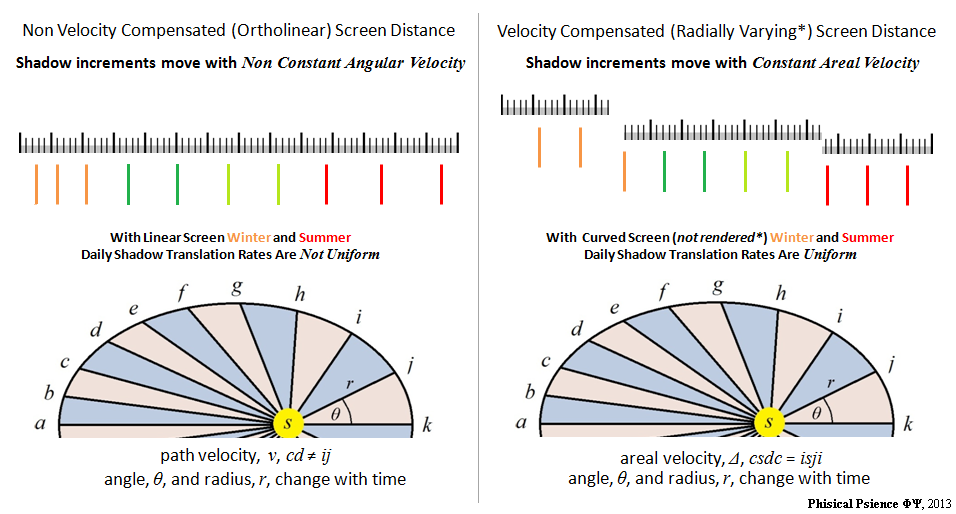
(Fig. 47) Diagram representing the effects upon the daily azimuthal translation rate of the Sun's gnomon shadow upon the image projection screen for both a non velocity compensated instrument (left) and design implementing a single large, fixed radius screen (mono angular velocity) for projecting both summer (red) and winter (orange) shadows verse that of a velocity compensated device (right) using two screens, a slightly arching* non uniform radius fast screen for summer and smaller slow screen for winter (McGraw, 2013). (*software limited)
|
The Chinese lunisolar lifa calendar (tropical year), and said to be dated from the winter solstice of 2698 BCE (≈4,700 years old), implying that the solar observatory at Táosi is a contemporary product or of lesser age, dated to 2100 - 2000 BCE. The high level of finesse seen in the Chinese lifa suggesting the need for numerous years of data collection to compile a seasonal calendrical registry composed of 24 discreet jiéqi (节气)(seasonal nodes) segments. The variations in local weather patterns and opportunity to observer solar, lunar and other celestial events, along with the timing of horizon, zenith, meridian, or culmination passing's being dictated by atmospheric conditions meaning numerous missed opportunities and discontinuations of a non uniform nature needing to be normalized prior to assembling the lifa.
The necessary time to compose a competent calendar of social value and associated observatory to measure solar and celestial events, requiring numerous construction iteration, prior to refinement. Giving rise to the distinct possibility that the Táosi solar observatory was not the first constructed of its type, being a highly refined solar instrument. That it is very likely, the solar observatory at Táosi represents the pinnacle of like technology and operational methodology, and ultimately the product of multiple trial and failure iterations prior to amassing the spatial geometry, orientation and scale seen at this site. Hence, the discovery of more antiquated forms of gnomon solar observatory construction, those less effective, non horizontal in shadow path (incline gnomon shadow) or perhaps not incorporating a fast and slow screen, may yet to be located in China, a facility and instrument predating the Táosi complex.
Speculating that by acutely limiting open public discussion to just that of an incline shadow gnomon and an overt optical phenomena that the Chinese state must have long ago capitulated upon as a non secret, the means to make such measurements of the sun being prolific beyond the political jurisdiction boundaries of 2nd millennia BCE China, may have limited or retarded public curiosity and further advancement towards a more sophisticated solar instrument. The typical member of society seeing further advancement beyond the incline shadow gnomon or from the perspective of a casual user not of great social importance, nor necessarily value added.
From the perspective of State secrets and much like classified systems today, in addition to remaining consistent with advice provided by Chinese tacticians from no less than the time of Sun Tzu (孫武) or Sun Zi (孫子)(Giles, 1910)[230] and his seminal text Sunzi Bingfa (孫子兵法)(The Art of War)(ca. 544-496 BCE)(Moran, 2012),[231] easily giving way to the possibility that the incline shadow gnomon could have been misrepresented as "state of the art". The Chinese having already developed, as shown from the Anhui Sheng (安徽省)[232] Anhui Provence excavation of the Xiahou Zao tomb, an equatorial sundial like instrument (ca. 165 BCE) by the start of the Western Han Dynasty (206 BCE-23 CE)(Zhang, and Fan, 2003),[233] with predecessor devices, per the Zhou bi, possibly dating back to the Zhou dynasty (1046-77 BCE)(Zhang, and Fan, 2003)[234] if not earlier.
_Western_Han_Dynasty.jpg) [235] [235] _equatorial_sundial-Nanjing_University_of_Science_and_Technology.jpg) [236] [236] _xinggui_(star dial).jpg) [237] [237]
(Fig. 47, left) Recreated shi (式)(Pankenier, 2005),[238] (diviner's board)(Yoke, 1985, 2000)[239] from the Western Han Dynasty. This equatorial and apparent astronomical device found in the tomb of Xiahou Zao (夏侯灶), 2nd Generation Lord of Ruyin (汝陰侯)(Shaughnessy, 2001),[240] or 2nd Marquis of Ruyin (ca. 165 BCE), Fuyang (阜陽) City, Ānhuī Shěng (汝陰侯)[241](Anhui Province)(Shi, 2012).[242] Note on the face of the top plate, the symbolic representation of the Chinese constellation bei dou (北斗)(Northern Plough)(Rowe, 2011)[243] with 7 stars being rendered. The seventh star being the location of the protruding gan (竿), rod at center. This discussion hypothesizing that the device was a measuring instrument used to angularly determine the position of the various xiu (宿) lodges, or lunar mansions they being written in black along the beveled edge of the dark red circular plate, relative to the location of the full Moon, and perhaps Jupiter, (x)[244] during new Moon or to that of the non visible Sun to locate the anti earth location. The clock angle orientation of the drawn beidou, (big dipper) on the face of the round plate, needing to be properly positioned for each lunar or planetary measurement. The calibration procedure requiring the turning of the front plate to match the clock angle orientation of the actual constellation in the sky. The visible night time shadow cast on the dark red dial face giving the operator of the instrument the location of the Moon or Jupiter with respects to the antisolar point. A white or shinny metallic plate adversely affecting the night vision sensitivity of the observer, and possible explanation for the selection of a dark color for the instrument. A robust instrument such as the shi and essentially a non powered clock that requires no consumables items such as water or sand, when properly fielded, possibly being an important device for determining the hours remaining in a night, and very useful for conducting military troop, hardware and logistics maneuvers under the cover of night. The shi, and perhaps in a similar manner as a sleeping bag, navigational sextant or radio transmitter, a dual use device with both civilian and military applications. (Fig. 48, center) Rigui (日晷)(pointed day tablet),[245] or equatorial sundial seen here at the Nanjing University of Science and Technology.[246] The invention of the Chinese rigui currently stated as having been invented in 574 CE.[250] (Fig. 49, right) Tang Dynasty (618-907 CE)(Zhang, and Fan, 2003)[251] xinggui (星晷)(star dial).[252] All three objects, the artifact from the Xiahou Zao tomb, rigui, and xinggui being similar in design, resulting in historical writings that at are descriptively ambiguous in nature.
|
The existence of the rigui (Fig. 50) probably predating the Zhou Dynasty (1046-77 BCE). This theory premised from a translation of the Zhou bi by Cullen. The Cullen's translation reading, "a gnomon, or gan (竿) rod casting no shadow on the solstice" (Cullen, 1996).[247] The summer solstice alignment condition described, with the shadow of the rod falling upon itself, not possible for a vertical gnomon for all locations north of 23.5o degrees latitude (Tropic of Cancer),[248] and geographical condition true for most of ancient China and inparticular during the Zhou dynasty. The only possible condition for any gnomon gan, (rod) located above the Tropic of Cancer, regardless of design approach to seasonally disappear, thus forming no visible shadow, occurring with equatorial sundials during the spring and fall equinox. In this given situation, the rod shadow falling parallel with the gnomon template time dial, forming a zero incident angle, resulting in no shadow being cast upon the template time dial. Hence the discussion in the Zhou bi, replacing the word solstice with equinox being more fitting of an equatorial configured sundial, or rigui (日晷), then that of a simple vertical gnomon staff, be it a gan (表), simple rod or calibrated biǎo gan (表竿), gauged rod or measured gnomon staff (Zi, 2010).[249]
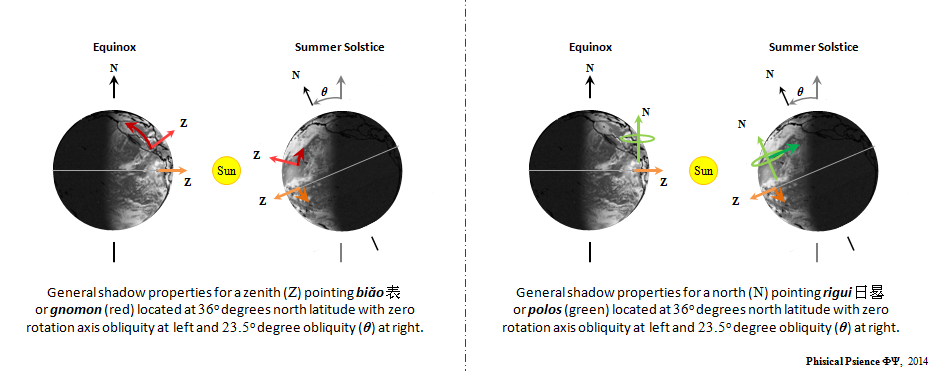 [xxx], [xxx] [xxx], [xxx]
(Fig. 50) Visual wavelength GOES West weather satellite images with overlaid renderings of the shadow relationship between the Sun and Earth (NASA, 2013; adapted, McGraw, 2014).[xxx], The frame at left representing a standard zenith aligned (Z) biao (gnomon) sundial located at 36o north latitude, drawn in red, compared to in the right frame and drawn in green, a polar aligned rigui sundial or equatorial sundial with a north celestial pole (N) aligned gan (polos) and right ascension (R.A.) plate, also located at 36o north latitude. The respective shadow for each sun shadow clock design approach indicated with a darker shade of color. The two frames, rendered with a zenith pointing control gnomon located along Earth's equator (orange). The equatorially located zenith pointing gnomon and polar aligned equatorial sundial (polos) casting no observable shadow on the two equinoxes. As a defining characteristic of the equatorial sundial (rigui), the staff's (gan) incline shadow on such instrument cast downward upon the topside (upper) surface of the equatorial disk from spring to fall, the cast incline shadow alternating to the underside (lower) surface of the equatorial disk from fall to spring, casting the shadow of the gan upwards. The winter solstice orientation of the gnomon shadow, being a trivial state condition, is omitted from the diagram. As a defining characteristic of the equatorial sundial (rigui), the staff's (gan) incline shadow on such instrument cast downward upon the topside (upper) surface of the equatorial disk from spring to fall, the cast incline shadow alternating to the underside (lower) surface of the equatorial disk from fall to spring, casting the shadow of the gan upwards. The winter solstice orientation of the gnomon shadow, being a trivial state condition, is omitted from the diagram.
|
The only parts of China today with a nadir shadow event on the summer solstice being regions near the Pearl River Delta or Yuè Jiāng Píngyuán (粤江平原) and south to include Hainan Island and regions near the Vietnam border. Although the Tang Dynasty had strong influence over Hainan Island and perhaps from the Jin Dynasty, does not appear in cartographic representation as being under Chinese political domain until the Song Dynasty with the 11th century Nan Song Chao 南宋朝 (Southern Song Dynasty)(1127-1279)[xxx], stone carved Yu Ji Tu 禹地圖 (Illustration of Yu's Land)(Cao Wanru, 1959).[xxx] (Fig. 51) Woodblock reproduction of Chinese and per the text in the upper right hand corner, operating a gnomon on the solstice with shadow present (Taipei Astronomical Science Museum, 台北市立天文科教館),[xxx] perhaps a working guide for regions in latitude close to Nanjing and former Eastern Wu (吳) and early Ming Dynasty capital city. The gnomon shadow representing a 9o incident angle with the ground, corresponding to a longitude of 33o north.
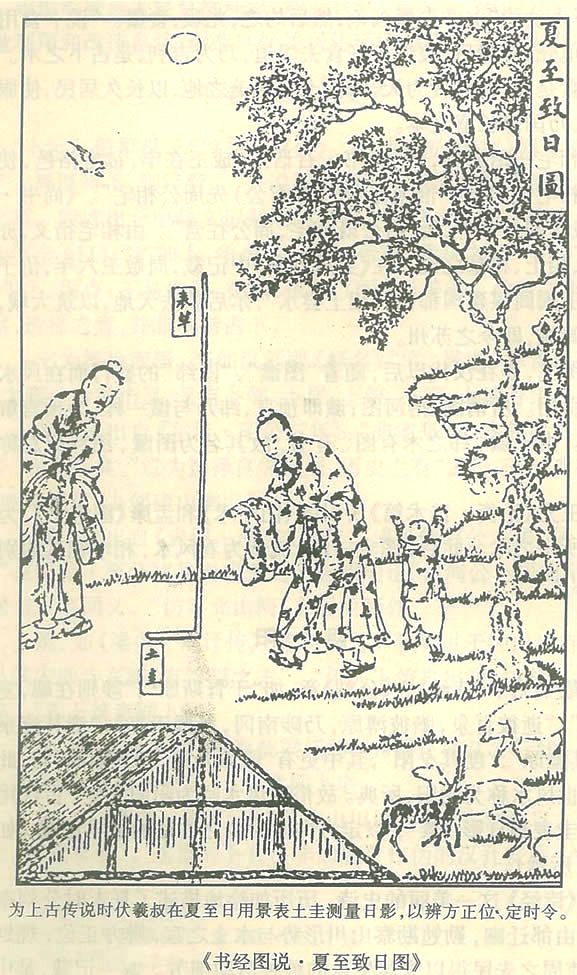 [xxx] [xxx]
(Fig. 51) Woodblock image of Chinese operating a biao (Taipei Astronomical Science Museum, 台北市立天文科教館)
with what maybe and per the Chinese text in the upper right corner, Xiàzhì zhì rì tú (夏至致日圖) translated as "Illustration of Summer Solstice",[xxx], a representation of the Sun's shadow near the summer solstice for regions close to 32o north, such as the city of Nanjing at (32.05o N)[xxx], since the incline angle of the shadow (biao end to shadow end) equals ~9o degrees.
|
A brief video (Vid. 1)(Iadevaia, 2011)[253] demonstrating the operation of an equatorial sundial, and how such device responds during the spring and fall equinox can be scene here at: http://www.bytepile.com/public/user/ko/videos/Demonstration_of_Equatorial_Sundial.wmv.
VIII) DISCUSSION
A summarized listing of some possible reasons supporting the use of the Táosi observatory as a horizontal gnomon used to measure the setting Sun being as followed.
i) Observatory staff is at maximum alertness in the day, not needing to rise early in the morning. Hence, physiologically less stressful to maintain a high level of working proficiency for an extended duration of time, introducing fewer humans errors into the total measuring procedure. Staff has maximum time to prepare for the daily measurement, using the late afternoon to anticipate the setting location of the sun and final position of the gnomon staff shadow.
ii) Measuring the azimuthal position of the setting Sun alleviates the requirements of having to determine correctly the difficult, sight unseen, anticipated appearance location on the horizon and exact time of the rising Sun (Fig. 24). Matched by not having to make the more difficult task of anticipating the exact incline location, or radial distance to the gnomon staff shadow tip on the ground, as the elevation of the apparent horizon varies with azimuthal bearing.
iii) Increasing the horizontal shadow path lengths for pillars 12 and 13 (Figs. 21, 22) assist with the measuring of the suns azimuthal position during its most difficult period of the year, that being the winter solstice. The increased path length traveled by the low shadow each day, slightly increasing the horizontal distance of the gnomon shadow as the sun moves relative with the Earth, drifting retrograde along the ecliptic path. The visual result being an artificial increase in the azimuthal distance traveled, or arc path length, by the gnomon shadow tip. Extending the shadow path length improves the accuracy of the angular measurement of the Sun against a background. The value of the increase in azimuthal arc path length being = (cosθ)Δr, setting Δr = [AB] - [AC] (Fig. 34). Additional ambiguities forming along the shadow edge from inherent optical diffraction and divergence of the projected shadow image upon the background surface due to increasing the shadow path length between the gnomon staff and pillars P12 and P13 being negligible for such short distances.
iv) Using a continuous background medium, such as a long cloth screen or curtain, permitting for yearlong and uninterrupted azimuthal measurements of the Sun. Leaving no discontinuities in the final data produced by instrument configuration limitations. The breath of the solar instrument's value being greatly maximized, as the need to view the sun through narrow viewing windows situated between difficult to alter locations limited by the inner spacing distance of the pillars, no longer a limiting factor.
v) The ability to continuously monitor the azimuthal position of the Sun (Fig. 21), weather permitting, aiding greatly in the Chinese ability to determine time duration variations of the Sun's apparent motion above and below the celestial equator as a function of season. That the Táosi Solar Observatory many have been specifically designed to make such measurements at sunset, so as to get a better understanding of the yet discovered full asymmetric analemma path taken by the Sun, which is best perceived and measured, if one has a long duration and precise timing instrument, with the Sun on the horizon.
vi) Measuring the azimuthal location of the shadow tip at sunset, with the projected shadow of the gnomon staff being level and horizontal with respects to the ground, decouples the vertical (tilt) component of an oblique ecliptic (Fig. 20), making for more precise azimuthal measurements, having no cosφ error produced by the inclination (elevation) angle (φ) of the gnomon shadow with respects to the true horizon.
vii) Measuring the azimuth bearing angle of the setting Sun via a horizontal shadow, as appose to measure the location of an inclined shadow path, means the gnomon staff does not need to be placed at the same height for each measurement. The only requirement being that the staff is linear. Hence, any problems associated with a damaged gnomon staff, debris filling the gnomon mounting hole or getting deeper with wear, will not generate any variations in the radial distance of the measurement location as the gnomon shadow tip translates across the background. Thus, improving overall azimuthal precision of the device and measurement accuracy. Mean while, simplifying the manufacturing process and general consistency of the final gnomon staff. Effectively normalizing any errors produced from staff height variations. The exposed ground in general, being an inferior recording medium as people walk across and erode the surface.
viii) Using the pillars as a bulkhead mounting surface for a cloth projection screen or curtain, and easy to remove recordable medium which can be study at leisure, instead of using stationary pillars as a reference sighting aid for line of sight (LOS) measurements, from a construction perspective, requiring simple uniform spacing and non prior knowledge of the exact bearing angles each pillar must possess relative to the gnomon staff. The tight inner spacing's between the pillars aiding in the securing of the removable shadow screen, along with maintaining the screen at a near constant radial distance from the gnomon staff, preserving the desired curvature of the background structure.
ix) The necessity to insure proper pillar gap interval and width, or aperture mask width, becoming nullified when using the Táosi instrument as a level projection device. The non coincidence nature of the pillar gaps with respects to critical calendrical dates, along with insufficient pillar gap widths, the widths ranging in width from adequate to insufficient (Tbl. 4)(Fig. 18), the angular field of view of the pillar gap less than the diameter of the Sun suggesting that the placement of the pillars were not very critical. The number of pillar used for sighting purposes, the count being 11, glaringly inconsistent with the typical mathematical factors in the Chinese calendar, thus the value of 11 pillars being an invalid multiplicative numerical factor. The nature of the gaps, being coarsely arrange, perhaps an indicator as to the non critical nature of the pillars exact placement, in addition to their non implementation as forward sighting devices for timing sunrise events.
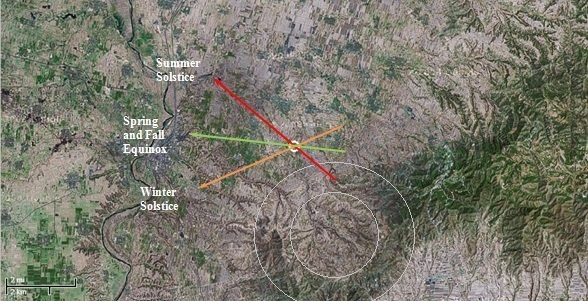 [254] [254]
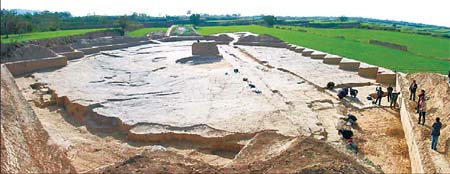 [255] [255] 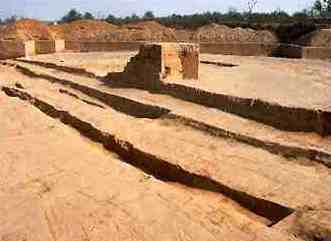 [256] [256]
(Fig. 52, upper) Satellite view of Táosi observatory, Shanxi China (Google Earth)[257] with arrows indicating the approximate compass heading, derived from work performed by Jiabi Wu (1999 - 2000), for the summer solstice (red), spring (vernal) and fall (autumnal) equinox, winter solstice (orange). The horizon looking northwest to southwest from Táosi solar observatory, viewing across the Fen He (汾河)(Fen River) (Pankenier, Liu, and De Meis, 2008)[258] and loess soil of the Linfen basin, appearing less obstructed along the horizon than that looking west. The geography around the 300 hector (741 acres)(3,000,000 m2) walled Táosi site, and largest Neolithic settlement found near a tributary of the Huang He (黃河)(Yellow River) valley being planar in nature (Liu, 2005).[259] The copper and lead rich (China Hydraulic Ministry, 1987)(Li, 2005)[260] Chong Mountains (Táer Mountain) being only 4 - 7 miles (≈6.5 - 11 km) to the west (Google Earth, 2012),[261] reaching heights of 1,493 m (≈4,900' ft). The elevation of the Táosi site being 573 m (1,880' ft)(Xu, and He, 2010).[262] Over level terrain, the distance to an unobstructed horizon being ≈11 miles (xx, xx).[263] The ≈3 mile (≈4.8 km) diameter, semi circular feature at lower center being a probable meteor impact site. (Fig. 53, lower left) ... (xxxx, xxxx).[264] (Fig. 54, lower right) ... (xxxx, xxxx).[265]
|
x) The double steps, leading to a recessed landing in the ground, adjacent to the gnomon mounting hole and aligned with the background pillars, being the ideal location for an assistant, while insuring that the gnomon staff remains in place and vertical during azimuthal measurement of the Sun (Fig. 16). The discovered staff being 180 cm long (He, 2009), implying that the tip of the staff be of lesser height about the surrounding, as some portion of the staff needs to remain inserted into the ground. Hence, to insure that the assistant does not introduce themselves into the projected path of the horizontal gnomon shadow, would best serve the procedure by remaining seated on the ground. The twin steps to the lower landing, performing such task.
xi) Using a horizontal project method at Sun set, looking west (Fig. 12, 29), having a controlled shadow path length removing the necessity for a large smooth floor area to record horizon events. A surface that will eventually be walked upon and exposed to weather, and as such less than ideal medium for preserving recorded measurements for future reexamination. The height of the gnomon at 1.8 m (5.9' ft), in addition to the Sun light ray path inclination angle (φ) of 1.125o degrees specifying the need for a minimum clear radius region of 91.66 m (300.7' ft) behind the gnomon for the shadow tip to reach common level ground. The current western perimeter of the Táosi observatory not sufficient in size to accommodate the formation and measurement of such long incline shadow path length (Fig. 19, 29). A horizontal gnomon shadow with projection screen needing only to be sufficiently far from the gnomon to easily perceive motion in the shadow, thus more compact design. The instant the gnomon shadow azimuth bearing ceases to translate, implying that half of the Sun's diameter has vanished below the horizon.
xii) From a material fabrication and site construction perspective, it's much less time consuming, easier to design and cheaper to build a solar instrument that functions about a simple and replaceable screen, such as a long sheet of silk cloth, and product already available in China at the time, then it would be to produce numerous large and heavy, monolithic like pillars, placing very strict tolerance requirements upon both spatial dimension and final placement. A monolithic design for such solar instrument, being essential non value added, complicating assembly while unnecessarily limiting the diversity and flexibility of the instrument and its ultimate user configuration.
xiii) The method for measuring the azimuthal position of the Sun on the horizon as suggested by this treatise provides the Longshan period, Táosi Chinese (Chang, Pingfang, Liancheng, Wangping, Youping, Wenming, Zhongpei with Hong, and Renxiang, 2002)[266] with a simple means of accurately measuring the distance from the location of the setting Sun to the pole star. A task understood by Cullen (2005) as anachronistic, not having been possible without the use of a huntian yi (浑天儀)(armillary sphere[267] or whole sky instrument[268]), or huntian xiàng (浑天象)[269] (whole sky rendering device).[270]
xiv) The solar observatory at Táosi, very likely, being capable of accurately timing the position and timing of other setting events for celestial objects such as the bright planets Venus and Jupiter, the setting time for the various phases of the Moon, as these object are already well known for being able to cast shadows at night,[271] along with very special and unforeseen events such as bright super nova and comets.
IX) CONCLUSION
The ultimate and fundamental question to this discussion on Taosi Solar Observatory is, could the Chinese of the Late Longshan culture have first detected such anomalous patterns in Earth's orbit and then devised an instrument that could be used to observer in detail the subtle nature of Earth's elliptical orbit about the Sun? This author being of the understanding that such technical capacity and astronomical understanding was well with the grasp of the early Chinese societies. The few records that share information regarding the events and activities of the earlier era's touching upon such astronomical understanding of the Earth's placement in the solar system in addition to the other 5 naked eye planets, the 2 inferior (Mercury, Venus) and 3 superior (Mars. Jupiter, Saturn)(xxxx, xxxx).[475] .
The estimated chronological date span for Taosi Observatory falling neatly within the estimated date range for the period of Emperor Kù's (喾帝) (2436-2366 BCE) or Kao, reign (xxxx, xxxx).[476] The contributions made to the field of astronomy by Emperor Ku being well know to the point that specifics about his works are legendary. The revered text Jinshu Ji Dynasty Office History, stating as translated;
Then at the time of the emperor Kao the orders of the Three Heavenly bodies (i.e. the sun, the moon, and the stars, including the planets) were also formulated. (Ho, tr. 1966; Yoke, 1985, 2000).[478]
|
The usage of a term equivalent to the word "formulated", suggesting that the comment was a possible reference as to the nature of the individual orbits for each planet, to include the Earth. That such understand, presuming it was correct, open to being structured about a heliocentric model. Such planetary model discovery having been independently determined by the pre Socratic Greeks such as ..... (xxxx, xxxx),[479] and later by Hipparchus thought errantly disregarded due to unresolved hidden orbital issues pertaining to the still yet appreciated focicentric elliptical orbit solution. Thus the stipulation of heliocentric orbits being on the whole, not that exceptional.
The critical comparative factor for determining parity scientific environments, written and verbal communication functions given to be uniform between societies, thus any scientific advantages to a culture would have to be predicated about what's available from the "test equipment and instrumentation pool" between the Greeks and Longshan Chinese independent of the 1,500 years separating the two societies. The assessment of this author being that the ancient Greeks held no technical equipment advantage over the Longshan Chinese. The only limiting factor for astronomical discovery being a function of individual contribution and ultimately a reflection of comprehension of the celestial world. As such, deeming the two societies, the pre Socratic Greeks and Longshan Chinese to have possessed similar technical equipment sophistication levels and measurement capabilities. Thus any astronomical discoveries of a celestial mechanical nature produced by the ancient Greeks, having being well within the capacity of the Longshan Chinese to independently ascertain and discover, all of which premised upon regionally available astronomical instrumentation.
The invention of the Chinese armillary sphere, according to the ca. 3rd c. text Jin shu (晉書)(Book of Jin) commentary under the topic huntian yi (whole sky instrument) hun yi for short, being credit to the astronomer Zhang Heng, of which possibly written by an anonymous hand (Yoke, 1985, 2000).[272] The Greek Hipparchus being credit with the invention of the Greek armillary sphere (xx, xx).[273] Such device with similar functions, probably already in use in China, per writings inferred from the text Zhou bi, some 1,200 years prior, during the Zhou Dynasty.
The Chinese instrument more than likely evolving from the equatorial oriented, single axis rigui device with the integration of an additional rotating axis that is mechanically coupled and placed orthogonal to the equatorially plane. This second, and rotating axis, performing the function of what was called the yougui (遊規)(declination ring), (Yoke, 1985, 2000),[274] and equivalent to the declination axis setting circles on a modern equatorial telescope mount (xx, xx).[275] The entire instrument and its collection of functions, such as angular measurements, performing comparably well to the first generation armillary device, jian yi (x儀) or abridged armillary (Fig. 56).[276] Having not yet evolved into a mechanical platform, composed of a multitude of spherically concentric rings that are meant to conceptualize different stellar projections, such as the ecliptic.
The equatorial jian yi instrument, configured with the aid of a wangtong (望筒)(sighting tube), (Yoke, 1985, 2000)[277] capable of making precise angular measurements of less than < 0.5 du (度) of arc (< 0.5o degree of arc), easily differentiating angles of arc equal to better than the width of the Sun or Moon (xx, xx).[278] There being 365.25 du in a year hence 360o degrees = 365.25 du (Wong, and Liu 1989; Cullen, 1996).[279] The entire device, with wongtong perhaps integrated in manner similar to that of a first generation horseshoe style equatorial mount, much like that supporting the 200" inch (5 m) Hale telescope at Mt. Palomar Observatory (xx, xx)[280] (Fig. 57).
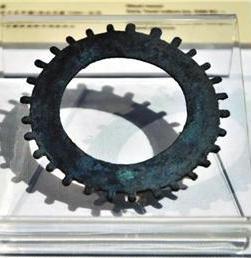 [281] [281]
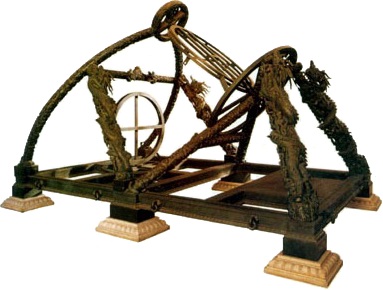 [282] [282]
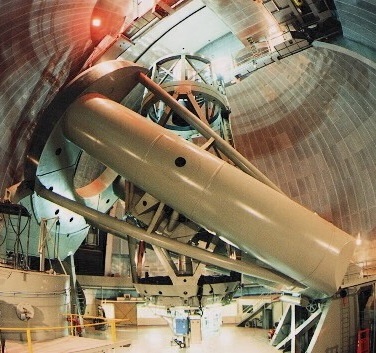 [283] [283]
(Fig. 55, left) Photo of middle to late period Táosi culture (ca. 2100-1900 BCE), 29 tooth, fan cast bronze gear (sprocket) identified as artifact 01M11:2,[284] that is ≈4.5" inches (≈13.8 cm) in diameter, composed of 97.86% copper, 1.54% lead, and 0.16% zinc. The intended purpose and function of this device yet to be determined, however from the 29 tooth count, claimed by some to be possibly related to the lunar cycle (中国社会科学院考古研究所 Chinese Academy of Social Sciences Institute of Archaeology, 2010).[285] This author suggesting, from the perspective of an analogue computing device, that the three wide teeth straddling the 12:30 o'clock location, perhaps the start or synchronize position for the sprocket with the larger center tooth being a shift or reset initiator for a base 28 arithmetic device. Thus raising the additional possibility that such a sprocketed device could have assisted the Chinese with the tracking or calculating of the lunar Metonic cycle of 235 synodic months (≈6,940 days) = ≈19 years (xxxx, xxxx)[286], and known to the Chinese as zhāng (章)[287], rule cycle, by at least the 6th century BCE (xxxx, xxxx).[288] (Fig. 56, center) Photo of a Ming Cháo (明朝)[289](1368-1644 CE)(Zhang, and Fan, 2003)[290](Ming Dynasty) recreation of a Western Han Dynasty (221 BCE-9 CE) abridged armillary device or jian yi (x儀)[291], not yet spherical in appearance, only in function.[292] Given a hypothetical wangtong (望筒)(sighting tube) mounted coplanar with the yougui (遊規)(declination ring), (Yoke, 1985, 2000),[293] located upper middle instrument, between the parallel and axially concentric small north and larger south, right ascension (R.A.) rings permitting a zero power (1x magnification) sighting tube device to function as a very accurate angular measuring tool, in an equatorial as appose to azimuthal manner. (Fig. 57, right) Photo of the Mt Palomar Observatory Hale telescope and horseshoe mount (Hanson, 2001).[294] The 200" inch (5 m) Hale telescope tube assembly being the open trust structure nested near the mount center to permit rotation of the telescope tube about the declination (Dec.) axis (north - south motion). The declination axis with tube assemble attached, placed between the north (left) and south (right) polar bearings. The north and south bearings on the horseshoe mount, like the north and south armillary rings, forming the right ascension (R.A.) axis, (east - west motion), resulting in an equatorially mounted instrument configuration. The jian yi and Mt. Palomar 200" inch (5 m) Hale telescope horseshoe style equatorial mount, at the rudimentary level, functioning in the same manner, and much like the Han Dynasty jian ji armillary is to the bronze Táosi gear, separated by nearly 2,000 years.
|
Given the precise values stated in the circa 12th c. BCE text "Zhou bi" and possibly containing data from the 26th c. BCE, calling out angular units in du (graduation), the unit's of du from currently known surviving evidence thought not to have been in existence prior to the writing of the 4th c. BCE text Shí Shēn Tiānwén (石申天文) "Astronomy, Shi Shen" by Shí Shēn (石申),[295] none the less may have existed in a separate, and yet to be determine unit equal to or of similar angular value as to the du, if not better.
The position held by this author, with regards to the circa 4th c. BCE preexistence of the angular unit du and or similar unit of measure, being contrary to understandings shared by others, relative to the Qian (1958) and Bo (1989) gnomon shadow data, of which there are two sets published in the Zhou bi. The second data set in the Zhou bi being more accurate, leading to the suggestion by some individuals that this second data set is the product of mathematical derivation as appose to direct visual measurement (Li, and Sun, 2009).[296]
The very high angular tolerances dictated and understood to have been incorporated in to the design and construction of the Taosi observatory, had this astronomical complex and instrument been specifically conceived of for the intended purpose of gnomon sighting, azimuthally measuring and timing celestial events along a horizon, inherently dictating angular resolving abilities more precise than the du. This more obscure higher unit of angular resolution, needing to be on the order of 0.25 du or ≈1/2 the diameter of the Sun, equaling approximately (02' min 30" sec) of time (xxxx, xxxx).[297]
The Chinese having the means to make direct angular measurements equal to half the diameter of the Sun or better, much like that seen in (Fig. 24) and interval of time equal to ≈2.5' minutes, the Sun and Moon being ≈0.5o degrees in arc width (≈0.5 du) thus ≈5' minutes of elapse time in angular space, long prior to the time of Shi Shen, providing additional credence to the possibility that the Chinese during the Longshan culture (4200 BCE - 1900 BCE) were capable of making repeatable angular measurements to the level of accuracy equal to or greater than the a unit of du, and assertion contrary to that put forth by Li and Sun (2009).
The Polish astronomer and merchant, Johannes Hevelius (1611-1687) with his wife Elizabeth from the city of Danzig (Gdańsk), using a 6' ft (1.8 m) radius brass sextant making geometrically "pure" astrometric measurement of stars to an accuracy of 1' arcmin, producing a 1,561 "naked eye" star atlas Firmamentum Sobiescianum sive Uranographia (1687), derived from the catalogue called the Prodromus Astronomiae, the catalogue not released until 1690 (Tirion, Rappaport and George Lovi, 1987).,[xxx]
X) FURTHER WORK
....
In closing wish to share some disappointment as to the current state of the Táosi Solar Observatory complex. Recent satellite images of the area (Fig. 58) indicating that the original excavation ruin, IIFJT1 is no longer open for study, being superseded in favor of the modern reproduction (Google Map, 2013).[303].
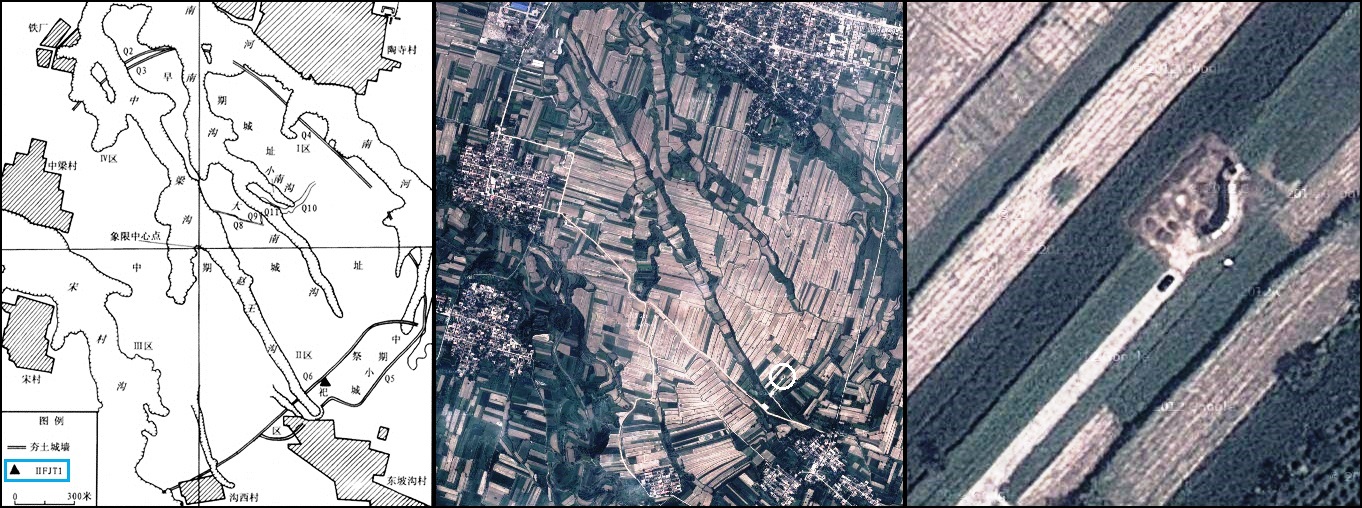 [298], [299] [298], [299]
(Fig. 58) Image series starting from left, archeological sketch of the entire Táosi region (He, 2007; adapted, McGraw, 2013), noting near bottom right the location of the Solar Observatory ruin IIFJT1 (black triangle)(xxxx, xxxx; adapted, McGraw, 2013)[300] compared to a current and identically scaled contrast enhanced satellite photo of the same area at center (Google Map, 2013; adapted, McGraw, 2013).[301] At far right is a contrast enhanced close up satellite image of the IIFJT1 ruin (35o 52' 55.9" N, 111o 29' 54.9" E)[302] showing the presence of a large shadow casting structure, the structure matching the original footprint area of the ancient facility.[303]
|
The original archeological site at Táosi, with investigators losing access to the land upon completion of the site survey in 2011, having been grossly disrespected and marginalized. The ancient facility and perhaps motivated for the less than illustrious desires to garner gains from such, backfilled with 2-3 meters of soil in favor of a Stonehenge like and overtly stylistic reconstruction of the Táosi observatory. A highly changeable reconstruction that may have been best served situated adjacent to the original and carefully protected ancient observatory site, the original Táosi observatory complex left graciously unmolested as possible post the 2011 site survey, rather than having the reconstruction developed as an overburden structure (Google Map, 2013; adapted, McGraw, 2013).[303]
|
REFERENCES
[1] Early China: a social and cultural history, 2013, pgs. xx, 30, 31, Cambridge University Press, Li Feng et. al., (Columbia University), ISBN 978-0-521-71981-0
[2] The Archaeology of China, From the Late Paleolithic to the Early Bronze Age, 2012, pgs. 216, 217, 222, Cambridge University Press, Li Liu, and Xingcan Chen et. al., (Stanford University / Chinese Academy of Social Sciences), ISBN 978-0-521-64432-7
[3] Archaeoastronomical Study of the Taosi Observatory from the Late Neolithic China, Sun Xiaoshun et. al., (中国科学院自然科学史研究所, Institute for the History of Natural Sciences, Chinese Academy of Sciences), National Astronomical Observatory of China, and Institute of Archaeology of the Chinese Academy of Social Sciences, National Science Foundation of China and by Chinese Academy of Science, News and Events, 2008, 2011, 2013, retrieved 11 Jan 2014; english.ihns.cas.cn/NE/NAE/201309/t20130929_110205.html" >http://english.ihns.cas.cn/NE/NAE/201309/t20130929_110205.html
[4] Case Study 5.1: Taosi Observatory, China, Xu Fengxian and He Nu et. al., (Institute for the History of Natural Science, Chinese Academy of Sciences, Beijing, China/Archaeology Institute, Chinese Academy of Social Sciences, Beijing, China), Heritage Sites of Astronomy and Archaeoastronomy in the context of the UNESCO World Heritage Convention, A Thematic Study, Michel Cotte, Clive Ruggles et. al., (University of Nantes, France / University of Leicester, United Kingdom), pg. 87, Jun 2010, International Council on Monuments and Sites, International Astronomical Union, ISBN 978-2-918086-01-7, retrieved 08 Aug 2011; www.astronomicalheritage.org/images/content/astroherit/WHC-internal/Astronomy-and-World-Heritage_Thematic-Study.pdf">http://www.astronomicalheritage.org/images/content/astroherit/WHC-internal/Astronomy-and-World-Heritage_Thematic-Study.pdf
[5] Aristarchus of Samos: The Ancient Copernicus, Oxford Clarendon Press 1913, Dover Edition 1981 republished 2004, pg. 293, Dover Publishing Inc., Sir Thomas Heath et. al., ISBN 0-486-43886-4
[6] 现代汉语词典 (英汉双语版) The Contemporary Chinese Dictionary (Chinese-English Edition), 11 月 2002, (November 2002), 第 5 次印刷 (5th Printing), 1 月 2003 (January 2003), 页 128, 129 (pgs. 128, 129), 外语教学与研究出版社 (Foreign Language Teaching and Research Press), 本社辞书部 編 中国 社会科 学院语言研究所词典编辑室 北京, (Dictionary Department, Institute of Linguistics, Chinese Academy of Social Sciences, Beijing) ed., ISBN 7-5600-3195-1/H 1649
[7] Astronomy and mathematics in ancient China: the Zhou bi suan jing, 周髀算經, 1996, pg. 178, Cambridge University Press, Christopher Cullen et. al., (History of Chinese Science and Medicine, School of Oriental and African Studies, University of London), ISBN 10 0-9823212-4-4
[8] Early Astronomy, 1st Edition, 1994, pg. 27, Springer-Verlag, Hugh Thurston et. al., (Department of Mathematics, University of British Columbia, Vancouver, BC), ISBN 0-387-94107-X
[9] 现代汉语词典 (英汉双语版) The Contemporary Chinese Dictionary (Chinese-English Edition), 11 月 2002, (November 2002), 第 5 次印刷 (5th Printing), 1 月 2003 (January 2003), 页 129 (pg. 129), 外语教学与研究出版社 (Foreign Language Teaching and Research Press), 本社辞书部 編 中国 社会科 学院语言研究所词典编辑室 北京, (Dictionary Department, Institute of Linguistics, Chinese Academy of Social Sciences, Beijing) ed., ISBN 7-5600-3195-1/H 1649
[10] Principia, 1685, Isaac Newton et. al., Cambridge, Book I, Sec II., III., An Introduction to Celestial Mechanics, pgs. 69, 70, 97, The MacMillan Company, Second Revised Edition, April 1914, Fifteenth Printing, 1962, Forest Ray Moulton et. al., (University of Chicago / Carnegie Institution of Washington)
[11] Warren J. Smith's Modern Optical Engineering, Third Edition, 2000, pgs. 128, 129, McGraw-Hill, Warren J. Smith et. al., (Kaiser Electro-Optics Inc.), ISBN 0-07-136360-2
[12] Revolution in Time, Clocks and the Making of the Modern World, 1983, Presidents and Fellows of Harvard College, 1998, pg 3, Barnes and Noble Books with Harvard University, Landes et. al., ISBN 0-7607-1074-0
[13] Geminos's Introduction to the Phenomena, A Translation and Study of a Hellenistic Survey of Astronomy, 2006, pgs. 53-57, Princeton University Press, James Evens, and J. Lennart Berggren et. al., ISBN 0-691-12339-X
[14] Aristarchus of Samos: The Ancient Copernicus, Oxford Clarendon Press 1913, Dover Edition 1981 republished 2004, pg. 308, Dover Publishing Inc., Sir Thomas Heath et. al., ISBN 0-486-43886-4
[15] Johannes Kepler, Abelard-Schuman 1959, Dover Edition 1993, pgs. 70, 134, 135, Dover Publishing Inc., Max Caspar et. al., C. Doris Hellman tr. et., Owen Gingerich intr., ISBN 0-486-67605-6
[16] An Introduction to Celestial Mechanics, pg. 33, The MacMillan Company, Second Revised Edition, April 1914, Fifteenth Printing, 1962, Forest Ray Moulton et. al., (University of Chicago / Carnegie Institution of Washington)
[17] 外研社 英汉汉英词典 (FLTRP, English-Chinese Chinese-English Dictionary), 2 月 2002, (December 2002), 第 2 次印刷 (2nd Printing), 3 月 2003 (March 2003), 页 591, 78 (pgs. 591, 78), 外语教学与研究出版社 (Foreign Language Teaching and Research Press), 本社辞书部 編 中国 社会科 学院语言研究所词典编辑室 北京, (Dictionary Department, Institute of Linguistics, Chinese Academy of Social Sciences, Beijing) ed., ISBN 7-5600-3105-6
[18] 中国历史与文明 The History and Civilization of China, 五月 2003 (May 2003), 页 255 (pg. 255), 中央文献出版社 (Central Party Literature Press), 张英聘 (Zhang Yingpin), and 范蔚 (Fan Wei) et., ISBN 7-5073-1360-3 k.605
[19] Evidence suggests Chinese civilization even more ancient, Beijing Times, Ye Xin (叶欣) ed. tr., (Beijing Times), Beijing Times, reprint 23 Jul 2010, Tann, ed., China, Home/Life & Culture, 人民网 (People's Daily Online, English), retrieved 2 Oct 2013; english.peopledaily.com.cn/90001/90782/7078611">http://english.peopledaily.com.cn/90001/90782/7078611
[20] 现代汉语词典 (英汉双语版) The Contemporary Chinese Dictionary (Chinese-English Edition), 11 月 2002, (November 2002), 第 5 次印刷 (5th Printing), 1 月 2003 (January 2003), 页 2228, 1980, 738 (pgs. 2228, 1980, 738), 外语教学与研究出版社 (Foreign Language Teaching and Research Press), 本社辞书部 編 中国 社会科 学院语言研究所词典编辑室 北京, (Dictionary Department, Institute of Linguistics, Chinese Academy of Social Sciences, Beijing) ed., ISBN 7-5600-3195-1/H 1649
[21] 现代汉语词典 (英汉双语版) The Contemporary Chinese Dictionary (Chinese-English Edition), 11 月 2002, (November 2002), 第 5 次印刷 (5th Printing), 1 月 2003 (January 2003), 页 1248, 1249, 1668, 2004, 2006, 835 (pgs. 1248, 1249, 1668, 2004, 2006, 835), 外语教学与研究出版社 (Foreign Language Teaching and Research Press), 本社辞书部 編 中国 社会科 学院语言研究所词典编辑室 北京, (Dictionary Department, Institute of Linguistics, Chinese Academy of Social Sciences, Beijing) ed., ISBN 7-5600-3195-1/H 1649
[22] Evidence suggests Chinese civilization even more ancient, Beijing Times, Ye Xin (叶欣) ed. tr., (Beijing Times), Beijing Times, reprint 23 Jul 2010, Tann, ed., China, Exhibitions, Travel, Archaeology News Network, retrieved 2 Oct 2013; archaeologynewsnetwork.blogspot.com/2010/07/evidence-suggests-chinese-civilization.html#.UvLLf9HTnCM">http://archaeologynewsnetwork.blogspot.com/2010/07/evidence-suggests-chinese-civilization.html#.UvLLf9HTnCM
[23] Early China: a social and cultural history, 2013, pgs. xx, 30, 31, Cambridge University Press, Li Feng et. al., (Columbia University), ISBN 978-0-521-71981-0
[24] The Formation of Chinese Civilization, An Archaeological Perspective, 2002, pg. 97, Yale University Press / New World Press, Kwang-chih Chang, Xu Pingfang, Lu Liancheng, Shao Wangping, Wang Youping, Yan Wenming, Zhang Zhongpei with Xu Hong, and Wang Renxiang al., Sarah Allan ed., Peter J. Ucko fw., ISBN 0-300-09382-9
[25] The Archaeology of China, From the Late Paleolithic to the Early Bronze Age, 2012, pgs. 226, 262, 263, Cambridge University Press, Li Liu, and Xingcan Chen et. al., (Stanford University / Chinese Academy of Social Sciences), ISBN 978-0-521-64432-7
[26] 外研社 英汉汉英词典 (FLTRP, English-Chinese Chinese-English Dictionary), 2 月 2002, (December 2002), 第 2 次印刷 (2nd Printing), 3 月 2003 (March 2003), 页 751, 78 (pgs. 751, 78), 外语教学与研究出版社 (Foreign Language Teaching and Research Press), 本社辞书部 編 中国 社会科 学院语言研究所词典编辑室 北京, (Dictionary Department, Institute of Linguistics, Chinese Academy of Social Sciences, Beijing) ed., ISBN 7-5600-3105-6
[27] 中国历史与文明 The History and Civilization of China, 五月 2003 (May 2003), 页 255 (pg. 255), 中央文献出版社 (Central Party Literature Press), 张英聘 (Zhang Yingpin), and 范蔚 (Fan Wei) et., ISBN 7-5073-1360-3 k.605
[28] 现代汉语词典 (英汉双语版) The Contemporary Chinese Dictionary (Chinese-English Edition), 11 月 2002, (November 2002), 第 5 次印刷 (5th Printing), 1 月 2003 (January 2003), 页 634, 2453, 2454 (pgs. 634, 2453, 2454), 外语教学与研究出版社 (Foreign Language Teaching and Research Press), 本社辞书部 編 中国 社会科 学院语言研究所词典编辑室 北京, (Dictionary Department, Institute of Linguistics, Chinese Academy of Social Sciences, Beijing) ed., ISBN 7-5600-3195-1/H 1649
[29] 现代汉语词典 (英汉双语版) The Contemporary Chinese Dictionary (Chinese-English Edition), 11 月 2002, (November 2002), 第 5 次印刷 (5th Printing), 1 月 2003 (January 2003), 页 1246, 1733, 826, 931 (pgs. 1246, 1733, 826, 931), 外语教学与研究出版社 (Foreign Language Teaching and Research Press), 本社辞书部 編 中国 社会科 学院语言研究所词典编辑室 北京, (Dictionary Department, Institute of Linguistics, Chinese Academy of Social Sciences, Beijing) ed., ISBN 7-5600-3195-1/H 1649
[30] Li, Qi, and Shu, An Introduction to Science and Civilization in China, 1985, Dover Edition, 2000, pg. 153, Dover Publications, Ho Peng Yoke et. al., (Australian Academy of Humanities), ISBN 0-486-41445-0
[31] 现代汉语词典 (英汉双语版) The Contemporary Chinese Dictionary (Chinese-English Edition), 11 月 2002, (November 2002), 第 5 次印刷 (5th Printing), 1 月 2003 (January 2003), 页 2355 (pg. 2355), 外语教学与研究出版社 (Foreign Language Teaching and Research Press), 本社辞书部 編 中国 社会科 学院语言研究所词典编辑室 北京, (Dictionary Department, Institute of Linguistics, Chinese Academy of Social Sciences, Beijing) ed., ISBN 7-5600-3195-1/H 1649
[32] The Chinese Calendar, Tyler J. Rowe et. al., (International Feng Shui Association, Australia Chapter), International Feng Shui Association, Australia Chapter, 29 Sep 2011, pg. 3, retrieved 23 Aug 2012; www.chinadragon.com.au/PDFs/Chinese_Calendar.pdf">http://www.chinadragon.com.au/PDFs/Chinese_Calendar.pdf
[33] 外研社 英汉汉英词典 (FLTRP, English-Chinese Chinese-English Dictionary), 2 月 2002, (December 2002), 第 2 次印刷 (2nd), 3 月 2003 (March 2003), 页 78, 249, 740 (pgs. 78, 249, 740), 外语教学与研究出版社 (Foreign Language Teaching and Research Press), 本社辞书部 編 中国 社会科 学院语言研究所词典编辑室 北京, (Dictionary Department, Institute of Linguistics, Chinese Academy of Social Sciences, Beijing) ed., ISBN 7-5600-3105-6
[34] 中国历史与文明 The History and Civilization of China, 五月 2003 (May 2003), 页 255 (pg. 255), 中央文献出版社 (Central Party Literature Press), 张英聘 (Zhang Yingpin), and 范蔚 (Fan Wei) et., ISBN 7-5073-1360-3 k.605
[35] Cosmos: An Illustrated History of Astronomy and Cosmology, 2008, University of Chicago Press, John David North et. al., (University of Groningen, Netherlands), pgs. 50, 51, ISBN 978-0-226-59441-5
[36] Aristarchus of Samos: The Ancient Copernicus, Oxford Clarendon Press 1913, Dover Edition 1981 republished 2004, pg. 293, Dover Publishing Inc., Sir Thomas Heath et. al., ISBN 0-486-43886-4
[37] 现代汉语词典 (英汉双语版) The Contemporary Chinese Dictionary (Chinese-English Edition), 11 月 2002, (November 2002), 第 5 次印刷 (5th Printing), 1 月 2003 (January 2003), 页 2288 (pg. 2288), 外语教学与研究出版社 (Foreign Language Teaching and Research Press), 本社辞书部 編 中国 社会科 学院语言研究所词典编辑室 北京, (Dictionary Department, Institute of Linguistics, Chinese Academy of Social Sciences, Beijing) ed., ISBN 7-5600-3195-1/H 1649
[38] 中国历史与文明 The History and Civilization of China, 五月 2003 (May 2003), 页 255 (pg. 255), 中央文献出版社 (Central Party Literature Press), 张英聘 (Zhang Yingpin), and 范蔚 (Fan Wei) et., ISBN 7-5073-1360-3 k.605
[39] 殷历谱 On the Calendar of the Yin Period, 1945, Dong Zuobin 董作宾, et. al., (Institute for the History of Natural Science, Chinese Academy of Science), Lizhuang, A Brief Introduction to the Studies on History of Science in the People’s Republic of China, Chinese Academy of Science, retrieved 04 Mar 2014; www1.ihns.ac.cn/members/liu/doc/chinese.htm">www1.ihns.ac.cn/members/liu/doc/chinese.htm
[40] Li, Qi, and Shu, An Introduction to Science and Civilization in China, 1985, Dover Edition, 2000, pgs. 153, 154, 156, Dover Publications, Ho Peng Yoke et. al., (Australian Academy of Humanities), ISBN 0-486-41445-0
[41] Astronomy and mathematics in ancient China: the Zhou bi suan jing, 周髀算經, 1996, pgs. 24, 29, 95, Cambridge University Press, Christopher Cullen et. al., (History of Chinese Science and Medicine, School of Oriental and African Studies, University of London), ISBN 10 0-9823212-4-4
[42] Li, Qi, and Shu, An Introduction to Science and Civilization in China, 1985, Dover Edition, 2000, pgs. 153, 154, 156, Dover Publications, Ho Peng Yoke et. al., (Australian Academy of Humanities), ISBN 0-486-41445-0
[43] The Formation of Chinese Civilization, An Archaeological Perspective, 2002, pgs. 170, Yale University Press / New World Press, Kwang-chih Chang, Xu Pingfang, Lu Liancheng, Shao Wangping, Wang Youping, Yan Wenming, Zhang Zhongpei with Xu Hong, and Wang Renxiang al., Sarah Allan ed., Peter J. Ucko fw., ISBN 0-300-09382-9
[44] Cambridge Illustrated History of China, 2003, pg. 17, Cambridge University Press, Patricia Buckley Ebrey al., Damian Thompson, et., ISBN 0-521-66991-X
[45] 现代汉语词典 (英汉双语版) The Contemporary Chinese Dictionary (Chinese-English Edition), 11 月 2002, (November 2002), 第 5 次印刷 (5th Printing), 1 月 2003 (January 2003), 页 1422, 1184, 1185 (pgs. 1422, 1184, 1185), 外语教学与研究出版社 (Foreign Language Teaching and Research Press), 本社辞书部 編 中国 社会科 学院语言研究所词典编辑室 北京, (Dictionary Department, Institute of Linguistics, Chinese Academy of Social Sciences, Beijing) ed., ISBN 7-5600-3195-1/H 1649
[46] The Mathematics of the Chinese Calendar, Helmer Aslaksen et. al., (Department of Mathematics, National University of Singapore, Singapore), 17 July 2010, pg. 21, Department of Mathematics, Faculty of Science, National University of Singapore, Singapore, retrieved 22 Feb 2013; www.math.nus.edu.sg/aslaksen/calendar/cal.pdf">http://www.math.nus.edu.sg/aslaksen/calendar/cal.pdf
[47] 现代汉语词典 (英汉双语版) The Contemporary Chinese Dictionary (Chinese-English Edition), 11 月 2002, (November 2002), 第 5 次印刷 (5th Printing), 1 月 2003 (January 2003), 页 2069, 1184, 1185, 2285 (pgs. 2069, 1184, 1185, 2285), 外语教学与研究出版社 (Foreign Language Teaching and Research Press), 本社辞书部 編 中国 社会科 学院语言研究所词典编辑室 北京, (Dictionary Department, Institute of Linguistics, Chinese Academy of Social Sciences, Beijing) ed., ISBN 7-5600-3195-1/H 1649
[48] Cosmos: An Illustrated History of Astronomy and Cosmology, 2008, pg. 27, University of Chicago Press, John David North et. al., (University of Groningen, Netherlands), ISBN 978-0-226-59441-5
[49] Early Astronomy, 1st Edition, 1994, pgs. 8, 82, Springer-Verlag, Hugh Thurston et. al., (Department of Mathematics, University of British Columbia, Vancouver, BC), ISBN 0-387-94107-X
[50] The Exact Sciences In Antiquity, Brown University Press 1957, Dover Edition 1969, pg. 81, Dover Publications Inc., O. Neugebauer et. al., (Brown University), ISBN 0-486-22332-9
[51] Early Astronomy, 1st Edition, 1994, pg. 20, Springer-Verlag, Hugh Thurston et. al., (Department of Mathematics, University of British Columbia, Vancouver, BC), ISBN 0-387-94107-X
[52] Geminos's Introduction to the Phenomena, A Translation and Study of a Hellenistic Survey of Astronomy, 2006, pg. 20, Princeton University Press, James Evens, and J. Lennart Berggren et. al., ISBN 0-691-12339-X
[53] Time in History, Views of Time from Prehistory to the Present Day, 1988, Oxford University Press, 2004 edition, pg. 26, Barnes & Noble Books, Gerald James Whitrow et. al., (University of London / Imperial College of Science and Technology, London), ISBN 0-7607-5549-3
[54] Ancient Egypt, An Introduction, 2009, pgs. xiii, xiv, Cambridge University Press, Salima Ikram et. al., (American University in Cairo), ISBN 978-0-521-67598-7
[55] Cosmos: An Illustrated History of Astronomy and Cosmology, 2008, pg. 22, University of Chicago Press, John David North et. al., (University of Groningen, Netherlands), ISBN 978-0-226-59441-5
[56] Ancient Egypt, An Introduction, 2009, pg. xiv, Cambridge University Press, Salima Ikram et. al., (American University in Cairo), ISBN 978-0-521-67598-7
[57] Time in History, Views of Time from Prehistory to the Present Day, 1988, Oxford University Press, 2004 edition, pg. 26, Barnes & Noble Books, Gerald James Whitrow et. al., (University of London / Imperial College of Science and Technology, London), ISBN 0-7607-5549-3
[58] The Oxford History of Ancient Egypt, 2000, new edition 2003, pgs. 207, 212, 485 Oxford University Press, Ian Shaw et. al., (University of Liverpool), ISBN 978-0-19280458-7
[59] Burnham's Celestial Handbook Vol. I, Andromeda-Cetus, 1978 Revised and Enlarged Edition 1966 Edition, pgs. 381, 387, Dover Publications Inc., Robert Burnham Jr. et. al., (Lowell Observatory), ISBN 0-486-23567-X.
[60] The Exact Sciences In Antiquity, Brown University Press 1957, Dover Edition 1969, pg. 82 , Dover Publications Inc., O. Neugebauer et. al., (Brown University), ISBN 0-486-22332-9
[61] Time in History, Views of Time from Prehistory to the Present Day, 1988, Oxford University Press, 2004 edition, pg. 26, Barnes & Noble Books, Gerald James Whitrow et. al., (University of London / Imperial College of Science and Technology, London), ISBN 0-7607-5549-3
[62] Ancient Greece, From Prehistoric to Hellenistic Times, 1996, Yale University, pgs. x, 36, 43, 51, 2000 Yale Nota Bene, Yale University Press, Thomas R. Martin et. al., (College of the Holy Cross), 0-300-08493-5
[63] Aristarchus of Samos: The Ancient Copernicus, Oxford Clarendon Press 1913, Dover Edition 1981 republished 2004, pgs. 1, 7, 11, 20, Dover Publishing Inc., Sir Thomas Heath et. al., ISBN 0-486-43886-4
[64] Early Astronomy, 1st Edition, 1994, Springer-Verlag, Hugh Thurston et. al., (Department of Mathematics, University of British Columbia, Vancouver, BC), pg. 24, ISBN 0-387-94107-X
[65] Burnham's Celestial Handbook Vol. I, Andromeda-Cetus, 1978 Revised and Enlarged Edition 1966 Edition, pgs. 302-304, Dover Publications Inc., Robert Burnham Jr. et. al., (Lowell Observatory), ISBN 0-486-23567-X
[66] Time in History, Views of Time from Prehistory to the Present Day, 1988, Oxford University Press, 2004 edition, pg. 48, Barnes & Noble Books, Gerald James Whitrow et. al., (University of London / Imperial College of Science and Technology, London), ISBN 0-7607-5549-3
[67] Geminos's Introduction to the Phenomena, A Translation and Study of a Hellenistic Survey of Astronomy, 2006, pgs. 7, 19, 26, 301, Princeton University Press, James Evens, and J. Lennart Berggren et. al., ISBN 0-691-12339-X
[68] Aristarchus of Samos: The Ancient Copernicus, Oxford Clarendon Press 1913, Dover Edition 1981 republished 2004, pgs. 10, 11, 285, Dover Publishing Inc., Sir Thomas Heath et. al., ISBN 0-486-43886-4
[69] Atlas of World History, From the Origins of Mankind to the Present Day, Parragon Edition, 2012, pgs. 29, 31, 48-51, Kate Santon, and Liz McKay et. al., ISBN 978-1-4054-5331-8
[70] Maps in the Service of the State: Roman Cartography to the End of the Augustan Era, Oswald A. W. Dilke al., (University of Leeds), Cartography in Prehistoric, Ancient, and Medieval Europe and the Mediterranean, pg. 204, University of Chicago Press, Volume One, 1987, J. B. Harley (University of Wisconsin-Milwaukee), and David Woodward et., (University of Wisconsin-Madison), ISBN 0-226-31633-5
[71] Pocket Oxford Greek Dictionary, Second Edition, Greek-English English-Greek, (ΕλληνιχόΑγγλο ΑγγλοΕλληνιχό) 1982, 1986, 1995, 2000, Revised Edition of The Oxford Dictionary of Modern Greek, 1965, J. T. Pring, cm., pg. 555, Oxford University Press, ISBN 978-0-19-860327-6
[72] Geminos's Introduction to the Phenomena, A Translation and Study of a Hellenistic Survey of Astronomy, 2006, pgs. 13, 14, Princeton University Press, James Evens, and J. Lennart Berggren et. al., ISBN 0-691-12339-X
[73] Time in History, Views of Time from Prehistory to the Present Day, 1988, Oxford University Press, 2004 edition, pgs. 55, 67-69, Barnes & Noble Books, Gerald James Whitrow et. al., (University of London / Imperial College of Science and Technology, London), ISBN 0-7607-5549-3
[74] The Mathematics of the Chinese Calendar, Helmer Aslaksen et. al., (Department of Mathematics, National University of Singapore, Singapore), 17 July 2010, pg. 37, Department of Mathematics, Faculty of Science, National University of Singapore, Singapore, retrieved 22 Feb 2013; www.math.nus.edu.sg/aslaksen/calendar/cal.pdf">http://www.math.nus.edu.sg/aslaksen/calendar/cal.pdf
[75] 现代汉语词典 (英汉双语版) The Contemporary Chinese Dictionary (Chinese-English Edition), 11 月 2002, (November 2002), 第 5 次印刷 (5th Printing), 1 月 2003 (January 2003), 页 78, 657 (pgs. 78, 657), 外语教学与研究出版社 (Foreign Language Teaching and Research Press), 本社辞书部 編 中国 社会科 学院语言研究所词典编辑室 北京, (Dictionary Department, Institute of Linguistics, Chinese Academy of Social Sciences, Beijing) ed., ISBN 7-5600-3195-1/H 1649
[76] 中国历史与文明 The History and Civilization of China, 五月 2003 (May 2003), 页 255 (pg. 255), 中央文献出版社 (Central Party Literature Press), 张英聘 (Zhang Yingpin), and 范蔚 (Fan Wei) et., ISBN 7-5073-1360-3 k.605
[77] 现代汉语词典 (英汉双语版) The Contemporary Chinese Dictionary (Chinese-English Edition), 11 月 2002, (November 2002), 第 5 次印刷 (5th Printing), 1 月 2003 (January 2003), 页 2185 (pg. 2185), 外语教学与研究出版社 (Foreign Language Teaching and Research Press), 本社辞书部 編 中国 社会科 学院语言研究所词典编辑室 北京, (Dictionary Department, Institute of Linguistics, Chinese Academy of Social Sciences, Beijing) ed., ISBN 7-5600-3195-1/H 1649
[78] 现代汉语词典 (英汉双语版) The Contemporary Chinese Dictionary (Chinese-English Edition), 11 月 2002, (November 2002), 第 5 次印刷 (5th Printing), 1 月 2003 (January 2003), 页 1887, 634 (pgs. 1887, 634), 外语教学与研究出版社 (Foreign Language Teaching and Research Press), 本社辞书部 編 中国 社会科 学院语言研究所词典编辑室 北京, (Dictionary Department, Institute of Linguistics, Chinese Academy of Social Sciences, Beijing) ed., ISBN 7-5600-3195-1/H 1649
[79] Astronomy and mathematics in ancient China: the Zhou bi suan jing, 周髀算經, 1996, pg. 9, Cambridge University Press, Christopher Cullen et. al., (History of Chinese Science and Medicine, School of Oriental and African Studies, University of London), ISBN 10 0-9823212-4-4
[80] 现代汉语词典 (英汉双语版) The Contemporary Chinese Dictionary (Chinese-English Edition), 11 月 2002, (November 2002), 第 5 次印刷 (5th Printing), 1 月 2003 (January 2003), 页 1735, 1887, 634 (pgs. 1735, 1887, 634), 外语教学与研究出版社 (Foreign Language Teaching and Research Press), 本社辞书部 編 中国 社会科 学院语言研究所词典编辑室 北京, (Dictionary Department, Institute of Linguistics, Chinese Academy of Social Sciences, Beijing) ed., ISBN 7-5600-3195-1/H 1649
[81] 现代汉语词典 (英汉双语版) The Contemporary Chinese Dictionary (Chinese-English Edition), 11 月 2002, (November 2002), 第 5 次印刷 (5th Printing), 1 月 2003 (January 2003), 页 1735, 514, 419, 2453 (pgs. 1735, 514, 419, 2453), 外语教学与研究出版社 (Foreign Language Teaching and Research Press), 本社辞书部 編 中国 社会科 学院语言研究所词典编辑室 北京, (Dictionary Department, Institute of Linguistics, Chinese Academy of Social Sciences, Beijing) ed., ISBN 7-5600-3195-1/H 1649
[82] The Mathematics of the Chinese Calendar, Helmer Aslaksen et. al., (Department of Mathematics, National University of Singapore, Singapore), 17 July 2010, pgs. 35, 36, Department of Mathematics, Faculty of Science, National University of Singapore, Singapore, retrieved 22 Feb 2013; www.math.nus.edu.sg/aslaksen/calendar/cal.pdf">http://www.math.nus.edu.sg/aslaksen/calendar/cal.pdf
[83] Astronomical Records on the Shang Dynasty Oracle Bones, Xu Zhentao, K. K. C. Yau, and F. R. Stephenson et. al., (Purple Mountain Observatory, Nanjing / Durham University), Archaeoastronomy, Journal for the History of Astronomy, Supplemental to Volume 20, Number 14, 1989, pgs. S61-S71, 0142-7253/89/0014-0061, retrieved 23 Aug 2012; www.caeno.org/_Nabonassar/pdf/Stephenson_Xu%20Oracle%20Bones.pdf">http://www.caeno.org/_Nabonassar/pdf/Stephenson_Xu%20Oracle%20Bones.pdf
[84] Early Astronomy, 1st Edition, 1994, pg. 88, Springer-Verlag, Hugh Thurston et. al., (Department of Mathematics, University of British Columbia, Vancouver, BC), ISBN 0-387-94107-X
[85] 现代汉语词典 (英汉双语版) The Contemporary Chinese Dictionary (Chinese-English Edition), 11 月 2002, (November 2002), 第 5 次印刷 (5th Printing), 1 月 2003 (January 2003), 页 2495, 228 (pgs. 2495, 228), 外语教学与研究出版社 (Foreign Language Teaching and Research Press), 本社辞书部 編 中国 社会科 学院语言研究所词典编辑室 北京, (Dictionary Department, Institute of Linguistics, Chinese Academy of Social Sciences, Beijing) ed., ISBN 7-5600-3195-1/H 1649
[86] 中国历史与文明 The History and Civilization of China, 五月 2003 (May 2003), 页 255 (pg. 255), 中央文献出版社 (Central Party Literature Press), 张英聘 (Zhang Yingpin), and 范蔚 (Fan Wei) et., ISBN 7-5073-1360-3 k.605
[87] Li, Qi, and Shu, An Introduction to Science and Civilization in China, 1985, Dover Edition, 2000, pgs. 153, 154, 156, Dover Publications, Ho Peng Yoke et. al., (Australian Academy of Humanities), ISBN 0-486-41445-0
[88] The Chinese Calendar, Tyler J. Rowe et. al., (International Feng Shui Association, Australia Chapter), International Feng Shui Association, Australia Chapter, 29 Sep 2011, pg. 3, retrieved 23 Aug 2012; www.chinadragon.com.au/PDFs/Chinese_Calendar.pdf">http://www.chinadragon.com.au/PDFs/Chinese_Calendar.pdf
[89] The Chinese Calendar, Tyler J. Rowe et. al., (International Feng Shui Association, Australia Chapter), International Feng Shui Association, Australia Chapter, 29 Sep 2011, pg. 3, retrieved 23 Aug 2012; www.chinadragon.com.au/PDFs/Chinese_Calendar.pdf">http://www.chinadragon.com.au/PDFs/Chinese_Calendar.pdf
[90] Time in History, Views of Time from Prehistory to the Present Day, 1988, Oxford University Press, 2004 edition, pgs. 24, 26, Barnes & Noble Books, Gerald James Whitrow et. al., (University of London / Imperial College of Science and Technology, London), ISBN 0-7607-5549-3
[91] The Oxford History of Ancient Egypt, 2000, new edition 2003, Oxford University Press, pgs. 65, 66, Ian Shaw et. al., (University of Liverpool), ISBN 978-0-19280458-7
[92] Early Astronomy, 1st Edition, 1994, pg. 8, Springer-Verlag, Hugh Thurston et. al., (Department of Mathematics, University of British Columbia, Vancouver, BC), ISBN 0-387-94107-X
[93] The Formation of Chinese Civilization, An Archaeological Perspective, 2002, pgs. 170, 284, Yale University Press / New World Press, Kwang-chih Chang, Xu Pingfang, Lu Liancheng, Shao Wangping, Wang Youping, Yan Wenming, Zhang Zhongpei with Xu Hong, and Wang Renxiang al., Sarah Allan ed., Peter J. Ucko fw., ISBN 0-300-09382-9
[94] Cambridge Illustrated History of China, 2003, pg. 17, Cambridge University Press, Patricia Buckley Ebrey al., Damian Thompson, et., ISBN 0-521-66991-X
[95] 现代汉语词典 (英汉双语版) The Contemporary Chinese Dictionary (Chinese-English Edition), 11 月 2002, (November 2002), 第 5 次印刷 (5th Printing), 1 月 2003 (January 2003), 页 464, 465, 2470 (pgs. 464, 465, 2470), 外语教学与研究出版社 (Foreign Language Teaching and Research Press), 本社辞书部 編 中国 社会科 学院语言研究所词典编辑室 北京, (Dictionary Department, Institute of Linguistics, Chinese Academy of Social Sciences, Beijing) ed., ISBN 7-5600-3195-1/H 1649
[96] 现代汉语词典 (英汉双语版) The Contemporary Chinese Dictionary (Chinese-English Edition), 11 月 2002, (November 2002), 第 5 次印刷 (5th Printing), 1 月 2003 (January 2003), 页 2069, 2470 (pgs. 2069, 2470), 外语教学与研究出版社 (Foreign Language Teaching and Research Press), 本社辞书部 編 中国 社会科 学院语言研究所词典编辑室 北京, (Dictionary Department, Institute of Linguistics, Chinese Academy of Social Sciences, Beijing) ed., ISBN 7-5600-3195-1/H 1649
[97] 现代汉语词典 (英汉双语版) The Contemporary Chinese Dictionary (Chinese-English Edition), 11 月 2002, (November 2002), 第 5 次印刷 (5th Printing), 1 月 2003 (January 2003), 页 310, 566 (pgs. 310, 566), 外语教学与研究出版社 (Foreign Language Teaching and Research Press), 本社辞书部 編 中国 社会科 学院语言研究所词典编辑室 北京, (Dictionary Department, Institute of Linguistics, Chinese Academy of Social Sciences, Beijing) ed., ISBN 7-5600-3195-1/H 1649
[98] 现代汉语词典 (英汉双语版) The Contemporary Chinese Dictionary (Chinese-English Edition), 11 月 2002, (November 2002), 第 5 次印刷 (5th Printing), 1 月 2003 (January 2003), 页 1581, 566 (pgs. 1581, 566), 外语教学与研究出版社 (Foreign Language Teaching and Research Press), 本社辞书部 編 中国 社会科 学院语言研究所词典编辑室 北京, (Dictionary Department, Institute of Linguistics, Chinese Academy of Social Sciences, Beijing) ed., ISBN 7-5600-3195-1/H 1649
[99] The Chinese Calendar, Tyler J. Rowe et. al., (International Feng Shui Association, Australia Chapter), International Feng Shui Association, Australia Chapter, 29 Sep 2011, pg. 2, retrieved 23 Aug 2012; http://www.chinadragon.com.au/PDFs/Chinese_Calendar.pdf
[100] 现代汉语词典 (英汉双语版) The Contemporary Chinese Dictionary (Chinese-English Edition), 11 月 2002, (November 2002), 第 5 次印刷 (5th Printing), 1 月 2003 (January 2003), 页 858, 860, 726, 1409 (pgs. 858, 860, 726, 1409), 外语教学与研究出版社 (Foreign Language Teaching and Research Press), 本社辞书部 編 中国 社会科 学院语言研究所词典编辑室 北京, (Dictionary Department, Institute of Linguistics, Chinese Academy of Social Sciences, Beijing) ed., ISBN 7-5600-3195-1/H 1649
[101] The 1911 Revolution in China, the Chinese Calendar, the Imaginary Qi and Healing: Translating Li Fa into an Australian Chinese Calendar and into an English Edition of the Northern Hemispherical Chinese Calendar, Rey Tiquia et. al., (School of Historical and Philosophical Studies, University of Melbourne, Melbourne, Australia), Scientific Research Chinese Studies, Social Sciences and Humanities Journal, 29 November 2012, Vol. 1, No. 3, pgs. 23-36, Scientific Research Publishing Inc., ISSN 2168-5428, DOI:10.4236/chnstd.2012.13005, retrieved 24 Feb, 2013; http://www.scirp.org/journal/PaperDownload.aspx?paperID=24933
[102] 现代汉语词典 (英汉双语版) The Contemporary Chinese Dictionary (Chinese-English Edition), 11 月 2002, (November 2002), 第 5 次印刷 (5th Printing), 1 月 2003 (January 2003), 页 514, 516, 1733, 1820, 984, 1520 (pgs. 514, 516, 1733, 1820, 984, 1520), 外语教学与研究出版社 (Foreign Language Teaching and Research Press), 本社辞书部 編 中国 社会科 学院语言研究所词典编辑室 北京, (Dictionary Department, Institute of Linguistics, Chinese Academy of Social Sciences, Beijing) ed., ISBN 7-5600-3195-1/H 1649
[103] Li, Qi, and Shu, An Introduction to Science and Civilization in China, 1985, Dover Edition, 2000, pgs. 153-155, Dover Publications, Ho Peng Yoke et. al., (Australian Academy of Humanities), ISBN 0-486-41445-0
[104] 现代汉语词典 (英汉双语版) The Contemporary Chinese Dictionary (Chinese-English Edition), 11 月 2002, (November 2002), 第 5 次印刷 (5th Printing), 1 月 2003 (January 2003), 页 716, 2539 (pgs. 716, 2539), 外语教学与研究出版社 (Foreign Language Teaching and Research Press), 本社辞书部 編 中国 社会科 学院语言研究所词典编辑室 北京, (Dictionary Department, Institute of Linguistics, Chinese Academy of Social Sciences, Beijing) ed., ISBN 7-5600-3195-1/H 1649
[105] Li, Qi, and Shu, An Introduction to Science and Civilization in China, 1985, Dover Edition, 2000, pg. 155, Dover Publications, Ho Peng Yoke et. al., (Australian Academy of Humanities), ISBN 0-486-41445-0
[106] 现代汉语词典 (英汉双语版) The Contemporary Chinese Dictionary (Chinese-English Edition), 11 月 2002, (November 2002), 第 5 次印刷 (5th Printing), 1 月 2003 (January 2003), 页 1811 (pg. 1811), 外语教学与研究出版社 (Foreign Language Teaching and Research Press), 本社辞书部 編 中国 社会科 学院语言研究所词典编辑室 北京, (Dictionary Department, Institute of Linguistics, Chinese Academy of Social Sciences, Beijing) ed., ISBN 7-5600-3195-1/H 1649
[107] Astronomy and mathematics in ancient China: the Zhou bi suan jing, 周髀算經, 1996, pg. 9, Cambridge University Press, Christopher Cullen et. al., (History of Chinese Science and Medicine, School of Oriental and African Studies, University of London), ISBN 10 0-9823212-4-4
[108] 现代汉语词典 (英汉双语版) The Contemporary Chinese Dictionary (Chinese-English Edition), 11 月 2002, (November 2002), 第 5 次印刷 (5th Printing), 1 月 2003 (January 2003), 页 2479, 2483, 1520 (pgs. 2479, 2483, 1520), 外语教学与研究出版社 (Foreign Language Teaching and Research Press), 本社辞书部 編 中国 社会科 学院语言研究所词典编辑室 北京, (Dictionary Department, Institute of Linguistics, Chinese Academy of Social Sciences, Beijing) ed., ISBN 7-5600-3195-1/H 1649
[109] The Mathematics of the Chinese Calendar, Helmer Aslaksen et. al., (Department of Mathematics, National University of Singapore, Singapore), 17 July 2010, pgs. 14, 17, Department of Mathematics, Faculty of Science, National University of Singapore, Singapore, retrieved 22 Feb 2013; http://www.math.nus.edu.sg/aslaksen/calendar/cal.pdf
[110] Li, Qi, and Shu, An Introduction to Science and Civilization in China, 1985, Dover Edition, 2000, pg. 120, Dover Publications, Ho Peng Yoke et. al., (Australian Academy of Humanities), ISBN 0-486-41445-0
[111] The 1911 Revolution in China, the Chinese Calendar, the Imaginary Qi and Healing: Translating Li Fa into an Australian Chinese Calendar and into an English Edition of the Northern Hemispherical Chinese Calendar, Rey Tiquia et. al., (School of Historical and Philosophical Studies, University of Melbourne, Melbourne, Australia), Scientific Research Chinese Studies, Social Sciences and Humanities Journal, 29 November 2012, Vol. 1, No. 3, pg. 27, Scientific Research Publishing Inc., ISSN 2168-5428, DOI:10.4236/chnstd.2012.13005, retrieved 24 Feb, 2013; http://www.scirp.org/journal/PaperDownload.aspx?paperID=24933
[112] The Chinese Calendar, Tyler J. Rowe et. al., (International Feng Shui Association, Australia Chapter), International Feng Shui Association, Australia Chapter, 29 Sep 2011, pg. 2, retrieved 23 Aug 2012; http://www.chinadragon.com.au/PDFs/Chinese_Calendar.pdf
[113] Li, Qi, and Shu, An Introduction to Science and Civilization in China, 1985, Dover Edition, 2000, pg. 154, Dover Publications, Ho Peng Yoke et. al., (Australian Academy of Humanities), ISBN 0-486-41445-0
[114] The Chinese Calendar, Tyler J. Rowe et. al., (International Feng Shui Association, Australia Chapter), International Feng Shui Association, Australia Chapter, 29 Sep 2011, pgs. 1, 2, retrieved 23 Aug 2012; http://www.chinadragon.com.au/PDFs/Chinese_Calendar.pdf
[115] Li, Qi, and Shu, An Introduction to Science and Civilization in China, 1985, Dover Edition, 2000, pg. 154, Dover Publications, Ho Peng Yoke et. al., (Australian Academy of Humanities), ISBN 0-486-41445-0
[116] Li, Qi, and Shu, An Introduction to Science and Civilization in China, 1985, Dover Edition, 2000, pgs. 154, 156, Dover Publications, Ho Peng Yoke et. al., (Australian Academy of Humanities), ISBN 0-486-41445-0
[117] 现代汉语词典 (英汉双语版) The Contemporary Chinese Dictionary (Chinese-English Edition), 11 月 2002, (November 2002), 第 5 次印刷 (5th Printing), 1 月 2003 (January 2003), 页 850, 428 (pgs. 850, 428), 外语教学与研究出版社 (Foreign Language Teaching and Research Press), 本社辞书部 編 中国 社会科 学院语言研究所词典编辑室 北京, (Dictionary Department, Institute of Linguistics, Chinese Academy of Social Sciences, Beijing) ed., ISBN 7-5600-3195-1/H 1649
[118] 中国历史与文明 The History and Civilization of China, 五月 2003 (May 2003), 页 255 (pg. 255), 中央文献出版社 (Central Party Literature Press), 张英聘 (Zhang Yingpin), and 范蔚 (Fan Wei) et., ISBN 7-5073-1360-3 k.605
[119] The Silk Road on Land and Sea, First Printing 1989, pg. 15, China Pictorial Publishing, Chen Tan, Sun Yifu, Huang Zuàn, Chen Heyi, and Ru Suichu al., Sun Yifu, and Huang Zuàn et., ISBN 7-80024-044-4/J.45
[120] The Mathematics of the Chinese Calendar, Helmer Aslaksen et. al., (Department of Mathematics, National University of Singapore, Singapore), 17 July 2010, pgs. 37, 38, Department of Mathematics, Faculty of Science, National University of Singapore, Singapore, retrieved 22 Feb 2013; http://www.math.nus.edu.sg/aslaksen/calendar/cal.pdf
[121]
Cosmos: An Illustrated History of Astronomy and Cosmology, 2008, pg. 148, University of Chicago Press, John David North et. al., (University of Groningen, Netherlands), ISBN 978-0-226-59441-5
[122] Early Astronomy, 1st Edition, 1994, pg. 92, Springer-Verlag, Hugh Thurston et. al., (Department of Mathematics, University of British Columbia, Vancouver, BC), ISBN 0-387-94107-X
[123] 现代汉语词典 (英汉双语版) The Contemporary Chinese Dictionary (Chinese-English Edition), 11 月 2002, (November 2002), 第 5 次印刷 (5th Printing), 1 月 2003 (January 2003), 页 353, 373, 1178, 914 (pgs. 353, 373, 1178, 914), 外语教学与研究出版社 (Foreign Language Teaching and Research Press), 本社辞书部 編 中国 社会科 学院语言研究所词典编辑室 北京, (Dictionary Department, Institute of Linguistics, Chinese Academy of Social Sciences, Beijing) ed., ISBN 7-5600-3195-1/H 1649
[124] Chinese Literature, Da Dai Liji, 大戴禮記 "Records of Ritual Matters by Dai Senior", 15 October 2010, Ulrich Theobald et. al., Literature, Confucian Classics, Da Dai Liji, China Knowledge, a universal guide for China studies, retrieved 2 Sep 2013; http://www.chinaknowledge.de/Literature/Classics/dadailiji.html
[125] 现代汉语词典 (英汉双语版) The Contemporary Chinese Dictionary (Chinese-English Edition), 11 月 2002, (November 2002), 第 5 次印刷 (5th Printing), 1 月 2003 (January 2003), 页 2369, 2370, 1235, 1236 (pgs. 2369, 2370, 1235, 1236), 外语教学与研究出版社 (Foreign Language Teaching and Research Press), 本社辞书部 編 中国 社会科 学院语言研究所词典编辑室 北京, (Dictionary Department, Institute of Linguistics, Chinese Academy of Social Sciences, Beijing) ed., ISBN 7-5600-3195-1/H 1649
[126] The Development and Decline of Chinese Cosmology, Columbia University Press, 1984, 1989, pgs. 18-21, Windstone Press Ltd., Taiwan, 2011, John D. Henderson et. al., (Department of History, Louisiana State University), ISBN 0-9823212-4-4
[127] Chinese Literature, Da Dai Liji, 大戴禮記 "Records of Ritual Matters by Dai Senior", 15 October 2010, Ulrich Theobald et. al., Literature, Confucian Classics, Da Dai Liji, China Knowledge, a universal guide for China studies, retrieved 2 Sep 2013; http://www.chinaknowledge.de/Literature/Classics/dadailiji.html
[128] 现代汉语词典 (英汉双语版) The Contemporary Chinese Dictionary (Chinese-English Edition), 11 月 2002, (November 2002), 第 5 次印刷 (5th Printing), 1 月 2003 (January 2003), 页 1105, 1581 (pgs. 1105, 1581), 外语教学与研究出版社 (Foreign Language Teaching and Research Press), 本社辞书部 編 中国 社会科 学院语言研究所词典编辑室 北京, (Dictionary Department, Institute of Linguistics, Chinese Academy of Social Sciences, Beijing) ed., ISBN 7-5600-3195-1/H 1649
[129] 中国历史与文明 The History and Civilization of China, 五月 2003 (May 2003), 页 42 (pg. 42), 中央文献出版社 (Central Party Literature Press), 张英聘 (Zhang Yingpin), and 范蔚 (Fan Wei) et., ISBN 7-5073-1360-3 k.605
[130] 现代汉语词典 (英汉双语版) The Contemporary Chinese Dictionary (Chinese-English Edition), 11 月 2002, (November 2002), 第 5 次印刷 (5th Printing), 1 月 2003 (January 2003), 页 1105, 2539 (pgs. 1105, 2539), 外语教学与研究出版社 (Foreign Language Teaching and Research Press), 本社辞书部 編 中国 社会科 学院语言研究所词典编辑室 北京, (Dictionary Department, Institute of Linguistics, Chinese Academy of Social Sciences, Beijing) ed., ISBN 7-5600-3195-1/H 1649
[131] Chinese Literature, Da Dai Liji, 大戴禮記 "Records of Ritual Matters by Dai Senior", 15 October 2010, Ulrich Theobald et. al., Literature, Confucian Classics, Da Dai Liji, China Knowledge, a universal guide for China studies, retrieved 2 Sep 2013; http://www.chinaknowledge.de/Literature/Classics/dadailiji.html
[132] Early Astronomy, 1st Edition, 1994, pg. 92, Springer-Verlag, Hugh Thurston et. al., (Department of Mathematics, University of British Columbia, Vancouver, BC), ISBN 0-387-94107-X
[133] 现代汉语词典 (英汉双语版) The Contemporary Chinese Dictionary (Chinese-English Edition), 11 月 2002, (November 2002), 第 5 次印刷 (5th Printing), 1 月 2003 (January 2003), 页 2069, 2104, 2441 (pgs. 2069, 2104, 2441), 外语教学与研究出版社 (Foreign Language Teaching and Research Press), 本社辞书部 編 中国 社会科 学院语言研究所词典编辑室 北京, (Dictionary Department, Institute of Linguistics, Chinese Academy of Social Sciences, Beijing) ed., ISBN 7-5600-3195-1/H 1649
[134] Chinese and Korean Star Maps and Catalogs, F. Richard Stephenson, al., (Department of Physics, East Asian Studies Department, University of Durham, UK), The History of Cartography, Volume Two, Book Two, Cartography in Cartography in the Traditional East and Southeast Asian Societies, 1987, pg. 513, The University of Chicago Press, J. B. Harley and David Woodward ed., (Department of Geography, University of Wisconsin, Milwaukee, WI / Department of Geography, University of Wisconsin, Madison, WI), ISBN: 0-226-31637-8
[135] 现代汉语词典 (英汉双语版) The Contemporary Chinese Dictionary (Chinese-English Edition), 11 月 2002, (November 2002), 第 5 次印刷 (5th Printing), 1 月 2003 (January 2003), 页 1184, 1185, 525 (pgs. 1184, 1185, 525), 外语教学与研究出版社 (Foreign Language Teaching and Research Press), 本社辞书部 編 中国 社会科 学院语言研究所词典编辑室 北京, (Dictionary Department, Institute of Linguistics, Chinese Academy of Social Sciences, Beijing) ed., ISBN 7-5600-3195-1/H 1649
[136] The Development and Decline of Chinese Cosmology, Columbia University Press, 1984, 1989, pgs. 18, 19, 21, Windstone Press Ltd., Taiwan, 2011, John D. Henderson et. al., (Department of History, Louisiana State University), ISBN 0-9823212-4-4
[137] Early Astronomy, 1st Edition, 1994, pg. 24, Springer-Verlag, Hugh Thurston et. al., (Department of Mathematics, University of British Columbia, Vancouver, BC), ISBN 0-387-94107-X
[138] 现代汉语词典 (英汉双语版) The Contemporary Chinese Dictionary (Chinese-English Edition), 11 月 2002, (November 2002), 第 5 次印刷 (5th Printing), 1 月 2003 (January 2003), 页 514, 1733, 21, 2160 (pgs. 514, 1733, 21, 2160), 外语教学与研究出版社 (Foreign Language Teaching and Research Press), 本社辞书部 編 中国 社会科 学院语言研究所词典编辑室 北京, (Dictionary Department, Institute of Linguistics, Chinese Academy of Social Sciences, Beijing) ed., ISBN 7-5600-3195-1/H 1649
[139] The Facts On File Dictionary of Astronomy, Revised Edition 1985, pg. 323, Macmillan Press, Valerie Illingworth et., ISBN 0-8160-1357-8
[140]
Cosmos: An Illustrated History of Astronomy and Cosmology, 2008, pgs. 148, 149, University of Chicago Press, John David North et. al., (University of Groningen, Netherlands), ISBN 978-0-226-59441-5
[141] Early Astronomy, 1st Edition, 1994, pg. 26, Springer-Verlag, Hugh Thurston et. al., (Department of Mathematics, University of British Columbia, Vancouver, BC), ISBN 0-387-94107-X
[142] Pocket Oxford Greek Dictionary, Second Edition, Greek-English English-Greek, (ΕλληνιχόΑγγλο ΑγγλοΕλληνιχό) 1982, 1986, 1995, 2000, Revised Edition of The Oxford Dictionary of Modern Greek, 1965, J. T. Pring, cm., pg. 551, Oxford University Press, ISBN 978-0-19-860327-6
[143] Celestial Treasury, From the Music of the Spheres to the Conquest of Space, Bibliothèque National de France Seuil 1998, pg. 80, Cambridge University Press 2001, Marc Lachièze-Rey, and Jean-Pierre Luminet et. al., (Centre National de la Recherche Scientifique, Centre ďEtudes de Saclay, France / Centre National de la Recherche Scientifique, Paris-Meudon Observatory, France), Leo Laredo tr., ISBN 0-521-800-40-4
[144] Space Travel A History, An Update of: History of Rocketry and Space Travel, Fourth Edition, 1985, pg. 2, Harper & Row Publishers, Wernher von Braun, Frederick I. Ordway III, Dave Dooling, et. al., Frederick C. Durant III fw., ISBN 0-06-181898-4
[145] Early Astronomy, 1st Edition, 1994, pgs. 2, 3, Springer-Verlag, Hugh Thurston et. al., (Department of Mathematics, University of British Columbia, Vancouver, BC), ISBN 0-387-94107-X
[146] Exhibition on Medicine and the Olympic Games of Antiquity, pg. 3, Library of the Royal Society of Medicine London / Hellenic Medical Society, UK, 7 Jun 2012, The Royal Society of Medicine, Society for the Promotion of Roman Studies, 2014, The Roman Society, retrieved 06 Mar 2014; http://www.romansociety.org/fileadmin/documents/pdf/Royal_Society_of_Medicine.pdf
[147] Burnham's Celestial Handbook, Vol. II, Chamaeleon - Orion, 1978 Revised and Enlarged Edition 1966 Edition, pgs. 1281, 1283, 1286, Dover Publications Inc., Robert Burnham Jr. et. al., (Lowell Observatory, Arizona), ISBN 0-486-23568-8
[148] Burnham's Celestial Handbook Vol. III, Pavo - Vulpecula, 1978 Revised and Enlarged Edition 1966 Edition, pg. 1655, Dover Publications Inc., Robert Burnham Jr. et. al., (Lowell Observatory), ISBN 0-486-23673-0
[149] Uranometria 2000.0, Volume 2 - The Southern Hemisphere to + 6o, 1987, pgs. 336, 338, Willmann-Bell Inc., Wil Tirion, Barry Rappaport, and George Lovi et. al., ISBN 0-943396-1-8
[150] 现代汉语词典 (英汉双语版) The Contemporary Chinese Dictionary (Chinese-English Edition), 11 月 2002, (November 2002), 第 5 次印刷 (5th Printing), 1 月 2003 (January 2003), 页 2126, 2160 (pgs. 2126, 2160), 外语教学与研究出版社 (Foreign Language Teaching and Research Press), 本社辞书部 編 中国 社会科 学院语言研究所词典编辑室 北京, (Dictionary Department, Institute of Linguistics, Chinese Academy of Social Sciences, Beijing) ed., ISBN 7-5600-3195-1/H 1649
[151] Li, Qi, and Shu, An Introduction to Science and Civilization in China, 1985, Dover Edition, 2000, pg. 116, Dover Publications, Ho Peng Yoke et. al., (Australian Academy of Humanities), ISBN 0-486-41445-0
[152] 现代汉语词典 (英汉双语版) The Contemporary Chinese Dictionary (Chinese-English Edition), 11 月 2002, (November 2002), 第 5 次印刷 (5th Printing), 1 月 2003 (January 2003), 页 461, 462, 544, 1562, 1248 (pgs. 461, 462, 544, 1562, 1248), 外语教学与研究出版社 (Foreign Language Teaching and Research Press), 本社辞书部 編 中国 社会科 学院语言研究所词典编辑室 北京, (Dictionary Department, Institute of Linguistics, Chinese Academy of Social Sciences, Beijing) ed., ISBN 7-5600-3195-1/H 1649
[153] Burnham's Celestial Handbook Vol. III, Pavo - Vulpecula, 1978 Revised and Enlarged Edition 1966 Edition, pgs. 1646, 1655, 1659, 1660, Dover Publications Inc., Robert Burnham Jr. et. al., (Lowell Observatory), ISBN 0-486-23673-0
[154] Tiandihui (天地會) Heaven and Earth Society, 1866, Gustaaf Schlegel et. al., 中國上古天文 (Ancient Chinese Astronomy), 1936, Shinjo Shinzo et. al., (Department of Astronomy, Kyoto University), Li, Qi, and Shu, An Introduction to Science and Civilization in China, 1985, Dover Edition, 2000, pg. 116, Dover Publications, Ho Peng Yoke et. al., (Australian Academy of Humanities), ISBN 0-486-41445-0
[155] Burnham's Celestial Handbook Vol. III, Pavo - Vulpecula, 1978 Revised and Enlarged Edition 1966 Edition, pgs. 1656, 1657, Dover Publications Inc., Robert Burnham Jr. et. al., (Lowell Observatory), ISBN 0-486-23673-0
[156] Li, Qi, and Shu, An Introduction to Science and Civilization in China, 1985, Dover Edition, 2000, pg. 115, Dover Publications, Ho Peng Yoke et. al., (Australian Academy of Humanities), ISBN 0-486-41445-0
[157]
Cosmos: An Illustrated History of Astronomy and Cosmology, 2008, pgs. 135, 143, 145, 147, University of Chicago Press, John David North et. al., (University of Groningen, Netherlands), ISBN 978-0-226-59441-5
[158] The Limits of Earth orbital calculations for geological time-scale use, pgs. 1754-1757, Jacques Laskar et. al., (Astronomie et Systèmes Dynamiques, CNRS-Bureau des Longitudes, Paris, France), Philosophical Transactions A of the Royal Society, 15 July 1999, Vol. 357, No. 1757, pgs. 1735-1759, DOI:10.1098/rsta.1999.0399, retrieved 17 Mar 2014; http://www.leif.org/EOS/laskar-orbit-stability.pdf
[159] Modern Physics, 1987, pgs. 2, 3, 73-75, Prentice-Hall Inc., Hans C. Ohanian al., (Rensselaer Polytechnic Institute, NY), Nicholas C. Romanelli et., ISBN 0-13-596123-8
[160] The Facts On File Dictionary of Astronomy, Revised Edition 1985, pg. 92, Macmillan Press, Valerie Illingworth et., ISBN 0-8160-1357-8
[161] Mathematical Methods For Physicist, Fourth Edition, 1995, pg. 9, Academic Press, George B. Arfken al., Hans-Jurgen Weber et., (Miami University, Oxford, OH / University of Virginia, Charlottesville, VI), ISBN 0-12-059815-9
[162] Calculus, One and Several Variables, 6th Edition, 1990, pgs. 1000, 1001, John Wiley & Sons, Einar Hille et. al., Saturnino Salas et., ISBN 0-471-61195-6
[163] Mathematical Physics, 1947, 1953 Prentice-Hall (Theoretical Physics), Dover Edition 1961 - corrected second edition 1953, pgs. 86-93, Dover Publishing, Donald H. Menzel et. al., (Harvard College Observatory, Harvard University), ISBN 0-486-60056-4
[164] An Introduction to Celestial Mechanics, 2012, pg. 66, Cambridge University Press, Richard Fitzpatrick et. al., (University of Texas at Austin), ISBN 978-1-107-02381-9
[165] Longitude of perihelion, Earth Mean Orbital Elements (J2000), Earth Fact Sheet, Updated: 01 July 2013, David R. Williams et. al., (National Space Science Data Center), NSSDC, NASA Goddard Space Flight Center, Greenbelt, MD, retrieved 17 Mar 2014; http://nssdc.gsfc.nasa.gov/planetary/factsheet/earthfact.html
[166] Physics of the Earth, 2008, Reprint with Corrections 2009, pg. 452, Cambridge University Press, F. P. Stacey, P. M. Davis et. al., ISBN 978-0-521-87362-8
[167] Illustration, Milankovitch Variations, 18 Nov 2005, Robert A. Rohde et. al. (Physics Department, University of California Berkeley), adapted Park McGraw, 12 Mar 2014, Global Warming Art, retrieved 24 May 2011; http://www.globalwarmingart.com/images/7/7e/Milankovitch_Variations.png
[168] Variations in the Earth's Orbit: Pacemaker of the Ice Ages, J. D. Hays, John Imbrie, and N. J. Shackleton et. al., (Department of Geology, Columbia University, New York / Geological Sciences, Brown University, Providence, Rhode Island / Sub-department of Quaternary Research, Cambridge University, Cambridge, England), Science, Vol. 194, No. 4270, 10 Dec 1976, pgs. 1121-1132, AAAS (American Association for the Advancement of Science), DOI: 10.1126/science.194.4270.1121, retrieved 17 Mar 2014; http://www.sciencemag.org/content/194/4270/1121
[169] Physics of the Earth, 2008, Reprint with Corrections 2009, pg. 452, Cambridge University Press, F. P. Stacey, P. M. Davis et. al., ISBN 978-0-521-87362-8
[170] Introductory Astronomy & Astrophysics, fourth edition 1998, pg. 48, A34, Saunders College Publishing, Michael Zeilik, Stephen A. Gregory et. al., (University of New Mexico), ISBN 0-03-006228-4
[171] Cyclostratigraphy and Astrochronology, pg. 66, Linda A. Hinnov, Frederik J. Hilgen al., (Dept. of Earth and Planetary Sciences, The Johns Hopkins University , Baltimore, Maryland, USA / Department of Earth Sciences, Utrecht University, Utrecht, the Netherlands), The Geologic Time Scale 2012, Volume 1, First Edition, 2012, pgs. 55-62, Elsevier, Felix M. Gradstein, James G. Ogg, Mark D. Schmitz, Gabi M. Ogg et., (Oslo University, Norway / Purdue University, Indiana, USA / Boise State University, Idaho, USA), DOI: 10.1016/B978-0-444-59425-9.00004-4, ISBN 978-0-444-59425-9
[172] Introductory Astronomy & Astrophysics, fourth edition 1998, pg. 48, Saunders College Publishing, Michael Zeilik, Stephen A. Gregory et. al., (University of New Mexico), ISBN 0-03-006228-4
[173] Cyclostratigraphy and Astrochronology, pg. 66, Linda A. Hinnov, Frederik J. Hilgen al., (Dept. of Earth and Planetary Sciences, The Johns Hopkins University , Baltimore, Maryland, USA / Department of Earth Sciences, Utrecht University, Utrecht, the Netherlands), The Geologic Time Scale 2012, Volume 1, First Edition, 2012, pgs. 55-62, Elsevier, Felix M. Gradstein, James G. Ogg, Mark D. Schmitz, Gabi M. Ogg et., (Oslo University, Norway / Purdue University, Indiana, USA / Boise State University, Idaho, USA), DOI: 10.1016/B978-0-444-59425-9.00004-4, ISBN 978-0-444-59425-9
[174] The Riddle of Gravitation, Revised and Updated Edition, 1968 Scribner's, 1992 Dover unabridged and slightly enlarged republication of the "Revised and Updated Edition" 1987 Scribner's, pg. 4, Dover Publication, Peter Gabriel Bergmann et. al., (Department of Physics, Syracuse University, Syracuse, NY, USA), ISBN 0-486-27378-4
[175] Precession, Norman F. Ramsey, al., (Department of Physics, Harvard University), Encyclopedia of Physics, Second Edition, 1991, pg. 961, VCH Publishers Inc., Rita G. Lerner, and George L. Trigg et., ISBN 0-89573-752-3
[176] An Introduction to Celestial Mechanics, 2012, pg. 67, Cambridge University Press, Richard Fitzpatrick et. al., (University of Texas at Austin), ISBN 978-1-107-02381-9
[177] The Solar System, Third Edition, 2004, pgs. 9, 10, 400, Springer-Verlag, Thérèse Encrenaz, Jean-Pierre Bibring, Michel Blanc, Maria-Antonietta Barucci, Françoise Roques, Philippe Zarka al., (Laboratoire de Recherche Spatiale, Observatoire de Paris, Meudon, France / Université Paris XI, Laboratoire René Bernas, Orsay, France / Observatoire Midi-Pyrenées, Toulouse, France / LESIA Observatoire de Paris, Meudon, France), Philippe Zarka et., Storm Dunlop tr., ISBN 0-941-783-4
[178] Introduction To Space Dynamics, Corrected Publication of 1963 Second Corrected Printing 1984, pg. 78, Dover Publication, William Tyrrell Thomson et. al., (University of California, Santa Barbara), ISBN 0-486-65113-4
[179] An Introduction to Celestial Mechanics, 2012, pgs. 51-53, Cambridge University Press, Richard Fitzpatrick et. al., (University of Texas at Austin), ISBN 978-1-107-02381-9
[180] Longitude of perihelion, Earth Mean Orbital Elements (J2000), Earth Fact Sheet, Updated: 01 July 2013, David R. Williams et. al., (National Space Science Data Center), NSSDC, NASA Goddard Space Flight Center, Greenbelt, MD, retrieved 17 Mar 2014; http://nssdc.gsfc.nasa.gov/planetary/factsheet/earthfact.html
[181] Physics of the Earth, 2008, Reprint with Corrections 2009, pgs. 94-96, Cambridge University Press, F. P. Stacey, P. M. Davis et. al., ISBN 978-0-521-87362-8
[182] Precession, Norman F. Ramsey, al., (Department of Physics, Harvard University), Encyclopedia of Physics, Second Edition, 1991, pg. 961, VCH Publishers Inc., Rita G. Lerner, and George L. Trigg et., ISBN 0-89573-752-3
[183] An Introduction to Celestial Mechanics, The MacMillan Company, Second Revised Edition, April 1914, Fifteenth Printing, 1962, pgs. 352-355, Forest Ray Moulton et. al., (University of Chicago / Carnegie Institution of Washington)
[184] An Introduction to Celestial Mechanics, 2012, pg. 67, Cambridge University Press, Richard Fitzpatrick et. al., (University of Texas at Austin), ISBN 978-1-107-02381-9
[185] An Introduction to Celestial Mechanics, The MacMillan Company, Second Revised Edition, April 1914, Fifteenth Printing, 1962, pgs. 344, 345, 352-355, Forest Ray Moulton et. al., (University of Chicago / Carnegie Institution of Washington)
[186] Mean Plane Osculating Elements (J2000.0) at JD 2455879.500000, 14 Nov 2011, Park McGraw, et. al., SOLEX Software, (c) 2003 - 2011, Aldo Vitagliano et. al., (Dipart. di Chimica, Università di Napoli "Federico II", Napoli, Italy); http://www.bytepile.com/public/user/ko/images/Earth_relative_to_Invariable_Plane_Solex14Nov2011.jpg
[187] The Solar System, Third Edition, 2004, pg. 236, Springer-Verlag, Thérèse Encrenaz, Jean-Pierre Bibring, Michel Blanc, Maria-Antonietta Barucci, Françoise Roques, Philippe Zarka al., (Laboratoire de Recherche Spatiale, Observatoire de Paris, Meudon, France / Université Paris XI, Laboratoire René Bernas, Orsay, France / Observatoire Midi-Pyrenées, Toulouse, France / LESIA Observatoire de Paris, Meudon, France), Philippe Zarka et., Storm Dunlop tr., ISBN 0-941-783-4
[188] An Introduction to Celestial Mechanics, 2012, pg. 67, Cambridge University Press, Richard Fitzpatrick et. al., (University of Texas at Austin), ISBN 978-1-107-02381-9
[189] Longitude of perihelion, Earth Mean Orbital Elements (J2000), Earth Fact Sheet, Updated: 01 July 2013, David R. Williams et. al., (National Space Science Data Center), NSSDC, NASA Goddard Space Flight Center, Greenbelt, MD, retrieved 17 Mar 2014; http://nssdc.gsfc.nasa.gov/planetary/factsheet/earthfact.html
[190] De die natali, c. 18.2, Censorinus, ca. 1st c. BCE, al., Aristarchus of Samos: The Ancient Copernicus, Oxford Clarendon Press 1913, Dover Edition 1981 republished 2004, pgs 286, 297, Dover Publishing Inc., Sir Thomas Heath et. al., ISBN 0-486-43886-4
[191] Cosmos: An Illustrated History of Astronomy and Cosmology, 2008, pgs. 50, 51, University of Chicago Press, John David North et. al., (University of Groningen, Netherlands), ISBN 978-0-226-59441-5
[192] Geminos's Introduction to the Phenomena, A Translation and Study of a Hellenistic Survey of Astronomy, 2006, pgs. 92-94, Princeton University Press, James Evens, and J. Lennart Berggren et. al., ISBN 0-691-12339-X
[193] An Introduction to Celestial Mechanics, 2012, pgs. 49, 50, 53, Cambridge University Press, Richard Fitzpatrick et. al., (University of Texas at Austin), ISBN 978-1-107-02381-9
[194] Geminos's Introduction to the Phenomena, A Translation and Study of a Hellenistic Survey of Astronomy, 2006, pgs. 92-94, Princeton University Press, James Evens, and J. Lennart Berggren et. al., ISBN 0-691-12339-X
[195] Cosmos: An Illustrated History of Astronomy and Cosmology, 2008, pgs. 92-94, University of Chicago Press, John David North et. al., (University of Groningen, Netherlands), ISBN 978-0-226-59441-5
[196] The Archaeology of China, From the Late Paleolithic to the Early Bronze Age, Cambridge University Press, 2012, pg. 225, Li Liu, and Xingcan Chen et. al., (Stanford University / Chinese Academy of Social Sciences), ISBN 978-0-521-64432-7
[197] The Formation of Chinese Civilization, An Archaeological Perspective, 2002, pgs. 84, 97, Yale University Press / New World Press, Kwang-chih Chang, Xu Pingfang, Lu Liancheng, Shao Wangping, Wang Youping, Yan Wenming, Zhang Zhongpei with Xu Hong, and Wang Renxiang al., Sarah Allan ed., Peter J. Ucko fw., ISBN 0-300-09382-9
[198] 中国历史与文明 The History and Civilization of China, 五月 2003 (May 2003), 页 9 (pg. 9), 中央文献出版社 (Central Party Literature Press), 张英聘 (Zhang Yingpin), and 范蔚 (Fan Wei) et., ISBN 7-5073-1360-3 k.605
[199] The Chinese Neolithic, Trajectories to Early States, New Studies in Archaeology, 2005, Cambridge University Press, Li Liu, al., (La Trobe University), Wendy Ashmore, Clive Gamble, John O'Shea, Colin Renfrew ed., (University of Pennsylvania / University of Southampton / University of Michigan, Ann Arbor / University of Cambridge), pgs. 109, 110, ISBN 978-0-511-08056-2
[200] Early China: a social and cultural history, 2013, pg. xx, Cambridge University Press, Li Feng et. al., (Columbia University), ISBN 978-0-521-71981-0
[201] The Archaeology of China, From the Late Paleolithic to the Early Bronze Age, Cambridge University Press, 2012, pg. 226, Li Liu, and Xingcan Chen et. al., (Stanford University / Chinese Academy of Social Sciences), ISBN 978-0-521-64432-7
[202] Traditional Chinese Astronomy, Tyler J. Rowe et. al., (International Feng Shui Association, Australia Chapter), International Feng Shui Association, Australia Chapter, 21 May 2011, pg. 1, retrieved 30 Aug 2012; http://intfsa.org.au/joomdocs/Traditional%20Chinese%20Astronomy.pdf
[203] 陶寺观象台遗址的天文功能与年代 (Taosi Observatory Ruins, Astronomical Function and Dating), 武家璧 Jia Bi Wu, 陈美东 Meidong Chen, 刘次沅 Ci Yuan Liu, et. al., (东华大学人文学院 College of Humanities, Donghua University, 上海, Shanghai / 中国科学院自然科学史研究所 Institute of History, Chinese Academy of Natural Science, 北京 Beijing / 中国科学院国家授时中心 National Time Service Center, China Academy of Sciences, 西安 Xian), 年 2008, 第 (Vol.) 38 卷, 第 (Vol.) 9 期: (pgs.) 1-8, 中国科学 (Chinese Science), G 辑 (Series G), 物理学 力学 天文学 (Physics, Mechanics and Astronomy), 中国科学 杂志社 (Science in China Press), retrieved 26 March 2014; http://www.kaogu.net.cn/cn/%E7%A0%94%E7%A9%B6%E6%96%B0%E8%AE%BA/%E4%B8%AD%E5%9B%BD%E7%A7%91%E5%AD%A6G%E8%BE%91%E5%88%98%E6%AC%A1%E5%85%83%E6%96%87%E7%AB%A0.pdf
[204] Astronomical function and date of the Taosi observatory, Jia Bi Wu, Mei Dong Chen, and Ci Yuan Liu et. al., (College of Humanities, Donghua University, Shanghai, China / Institute for the History of Natural Science, Chinese Academy of Sciences, Beijing, China / National Time Service Center, Chinese Academy of Sciences, Xi'an, China), Science in China Series G: Physics, Mechanics and Astronomy, Jan 2009, Vol 52, Issue 1, pgs. 151-158, Science In China Press, Springer Verlag, DOI:10.1007/s11433-009-0017-1, retrieved 20 Feb 2013; http://www.kaogu.net.cn/en/download/%E4%B8%AD%E5%9B%BD%E7%A7%91%E5%AD%A6G%E8%BE%91%E5%88%98%E6%AC%A1%E5%85%83%E6%96%87%E7%AB%A0English.pdf
[205] Shanxi, Linfen, Xiang Fen Xian, (临襄线)(Lin, Xiang, Xian), Google Map, Satellite (50' ft / 20 m scale), 07 Feb 2014, retrieved 07 Feb 2014; https://maps.google.com
[206] The Xiangfen, Taosi Site: A Chinese Neolithic 'Observatory'?, David W. Pankenier, Ciyuan Y. Liu, Salvo De Meis et. al., Archaeologia Baltica 10, 5 Nov 2008, V. Reflections of Astronomical and Cosmological Knowledge in Monuments, Landscapes and Architecture, pgs. 141-148, retrieved 24 Aug 2012; http://www.lehigh.edu/~dwp0/Assets/images/taosisite.pdf
[207] 山西省交通图 (Shānxī Shěng Transportation Map), 中国公路网地图册 (China Road Atlas), 北斗地图图书系列 (Dipper Book Map Series), 速査版 (Quick Edition), 四月 2003 (April 2003), 北京天域北斗图书有限公司 (Dipper Book Ltd., Beijing, China), 北京九洲通图电子科技发展有限公司, 編 (Beijing Jiuzhou Digital Illustration, Science and Technology Development Ltd., Beijing, China), 編 (et.), 人民交通出版社 (China Communications Press), 页 (pg.) 14, ISBN 7-5600-3105-6
[208] 中国地图集, Atlas of China, 中国地图出版社, 2006.7, SinoMaps Press (State Bureau of Surveying and Mapping, Beijing, China), 1st Edition, 1st Impression, Jan 2007, 页 (pgs.) 54, 55, ISBN 978-7-5031-4178-2/K.2456
[209] 中国最早的观象台发掘 China's Earliest Observatory Excavation, 页 (pg.) 301, 李维宝 Bao Li, 陈久金 Jiujin Chen et. al., (中国科学院国家天文台云南天文台, 云南昆明 Yunnan Observatory, National Astronomical Observatories, Chinese Academy of Sciences, Kunming / 中国科学院自然科学史研究所, 北京 Chinese Academy of Sciences Institute of History of Natural Sciences, Beijing), 第 (Vol.) 4 卷, 第 (No.) 3 期, 2007 年, 9 月 (Sep.), 页 (pgs.) 301-306, 天文研究与技术 (国家天文台台刊) Astronomical Research and Technology, 2012 China Academic Journal Electronic Publishing House, retrieved 15 Oct 2013; http://catalogs.ihns.ac.cn/bitstream/311051/2119/1/中国最早的观象台发掘.pdf
[210] World's oldest observatory found in China (Xinhua), China Daily, 31 Oct 2005, retrieved 26 Aug 2012; http://www.chinadaily.com.cn/english/doc/2005-10/31/content_488952.htm
[211] 山西省交通图 (Shānxī Shěng Transportation Map), 中国公路网地图册 (China Road Atlas), 北斗地图图书系列 (Dipper Book Map Series), 速査版 (Quick Edition), 四月 2003 (April 2003), 北京天域北斗图书有限公司 (Dipper Book Ltd., Beijing, China), 北京九洲通图电子科技发展有限公司, 編 (Beijing Jiuzhou Digital Illustration, Science and Technology Development Ltd., Beijing, China), 編 (et.), 人民交通出版社 (China Communications Press), 页 (pg.) 13, 14, ISBN 7-5600-3105-6
[212] 中国历史与文明 The History and Civilization of China, 五月 2003 (May 2003), 页 (pg.) 16, 中央文献出版社 (Central Party Literature Press), 张英聘 (Zhang Yingpin), and 范蔚 (Fan Wei) et., ISBN 7-5073-1360-3 k.605
[213] 现代汉语词典 (英汉双语版) The Contemporary Chinese Dictionary (Chinese-English Edition), 11 月 2002, (November 2002), 第 5 次印刷 (5th Printing), 1 月 2003 (January 2003), 页 (pgs.) 1482, 2219, 2080, 外语教学与研究出版社 (Foreign Language Teaching and Research Press), 本社辞书部 編 中国 社会科 学院语言研究所词典编辑室 北京, (Dictionary Department, Institute of Linguistics, Chinese Academy of Social Sciences, Beijing) ed., ISBN 7-5600-3195-1/H 1649
[214] Astronomical function and date of the Taosi observatory, Jia Bi Wu, Mei Dong Chen, and Ci Yuan Liu et. al., (College of Humanities, Donghua University, Shanghai, China / Institute for the History of Natural Science, Chinese Academy of Sciences, Beijing, China / National Time Service Center, Chinese Academy of Sciences, Xi'an, China), Science in China Series G: Physics, Mechanics and Astronomy, Jan 2009, Vol 52, Issue 1, pgs. 151-158, Science In China Press, Springer Verlag, DOI:10.1007/s11433-009-0017-1, retrieved 20 Feb 2013; http://www.kaogu.net.cn/en/download/%E4%B8%AD%E5%9B%BD%E7%A7%91%E5%AD%A6G%E8%BE%91%E5%88%98%E6%AC%A1%E5%85%83%E6%96%87%E7%AB%A0English.pdf
[xxx] Photo, 陶寺观象台遗址模型施工中 (Taosi Observatory Ruin, Model Construction), 陶寺观象台遗址模型涂装工程加紧施工中 (Painting Work Advances on the Constructed Model of Taosi Observatory), 利平 (Li Ping) et. al., 旅游节专题 节庆动态 (Thematic Tourism Festival, Festival News), 10 Sep 2012, 委宣传部 (Propaganda Department Committee), 襄汾县 (Xiangfen Country), 中共 (Chinese Communist Party), retrieved 10 Oct 2013; http://www.xiangfen.gov.cn/news/xlzt/jieqindongtai/2012/910/1GCB.html.
[xxx] 陶寺观象台遗址模型涂装工程加紧施工中 (Painting Work Advances on the Constructed Model of Taosi Observatory), 利平 (Li Ping) et. al., 旅游节专题 节庆动态 (Thematic Tourism Festival, Festival News), 10 Sep 2012, 委宣传部 (Propaganda Department Committee), 襄汾县 (Xiangfen Country), 中共 (Chinese Communist Party), retrieved 10 Oct 2013; http://www.xiangfen.gov.cn/news/xlzt/jieqindongtai/2012/910/1GCB.html.
[298] Illustration, 陶寺遗址平面图, 中国社会科学院考古研究所 (Taosi Ruin Site Drawing, Chinese Academy of Social Sciences, Institute of Archaeology), 15 Jul 2006, 二里头遗址及其周边区域的聚落考古学研究 (Archaeology Settlement Excavations and Surrounding Areas Part 2), 榕城 (Rong Cheung) et. al., 让我们一起看星星 (Let's Look at the Stars Together), 28 Apr 2008, 百度 (Baidu), retrieved 14 Oct 2013; http://www.kaogu.cn/eWebEditor/UploadFile/20071130192511533..jpg.
[300] 二里头遗址及其周边区域的聚落考古学研究 (Archaeology Settlement Excavations and Surrounding Areas Part 2), 榕城 (Rong Cheung) et. al., 让我们一起看星星 (Let's Look at the Stars Together), 28 Apr 2008, 百度 (Baidu), retrieved 14 Oct 2013;
|
|
|
 [167]
[167]


 [129],[130]
[129],[130]  [131]
[131]
 [132]
[132]  [133],[134]
[133],[134]
 [135]
[135]  [136]
[136]  [137]
[137]

 [171]
[171]
 [xxx]
[xxx]  [xxx]
[xxx]  [xxx]
[xxx]
 [xxx]
[xxx]  [xxx]
[xxx]  [xxx]
[xxx]
 [xxx]
[xxx]  [xxx]
[xxx]
 [xxx],[xxx]
[xxx],[xxx]



 [xxx]
[xxx]
 [xx]
[xx]
 [xxx]
[xxx]  [xxx]
[xxx]
 [xxx]
[xxx]  [xxx]
[xxx]
 [xxx]
[xxx]
 [xxx]
[xxx]  [xxx]
[xxx]
_for_pilar_apertures_1-12.jpg) [xxx]
[xxx]
 [xxx]
[xxx]
_Solar_Shadow_Path_Locations-2-c2.png) [163], [164]
[163], [164]
 [170]
[170]
 [171]
[171]
 [175]
[175]  [176]
[176]  [177]
[177]
 [182]
[182] 
 [185]
[185]
 [186, 187]
[186, 187]  [188]
[188]
 [194]
[194]  [195]
[195]
 [200]
[200]  [201]
[201]
 [202]
[202]
 [xxx]
[xxx]

 [208]
[208]  [209]
[209]
 [214]
[214]  [215]
[215]

 [219]
[219]
 [227]
[227] 


_Western_Han_Dynasty.jpg) [235]
[235] _equatorial_sundial-Nanjing_University_of_Science_and_Technology.jpg) [236]
[236] _xinggui_(star dial).jpg) [237]
[237]
 [xxx], [xxx]
[xxx], [xxx]
 [xxx]
[xxx]
 [254]
[254]
 [255]
[255]  [256]
[256]
 [281]
[281]
 [282]
[282]
 [283]
[283]
 [298], [299]
[298], [299]